Uncategorized
now browsing by category
Myofascial Release Therapy for Pain Relief
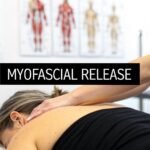
Myofascial release therapy is a highly effective, hands-on treatment that gets to the root of stubborn pain and stiffness. It’s all about targeting the body's fascia—a complex, web-like system of connective tissue. Using slow, sustained pressure, a therapist can release tightness and "knots" in this tissue, restoring your natural freedom of movement.
Think of it this way: your fascia is like a thin, yet incredibly strong, layer of shrink-wrap covering every single muscle, bone, and organ. When it's healthy, it's smooth and flexible. But when it gets tight or stuck, it can pull on everything it surrounds, causing pain and limiting how you move.
Unlocking a Deeper Layer of Pain Relief
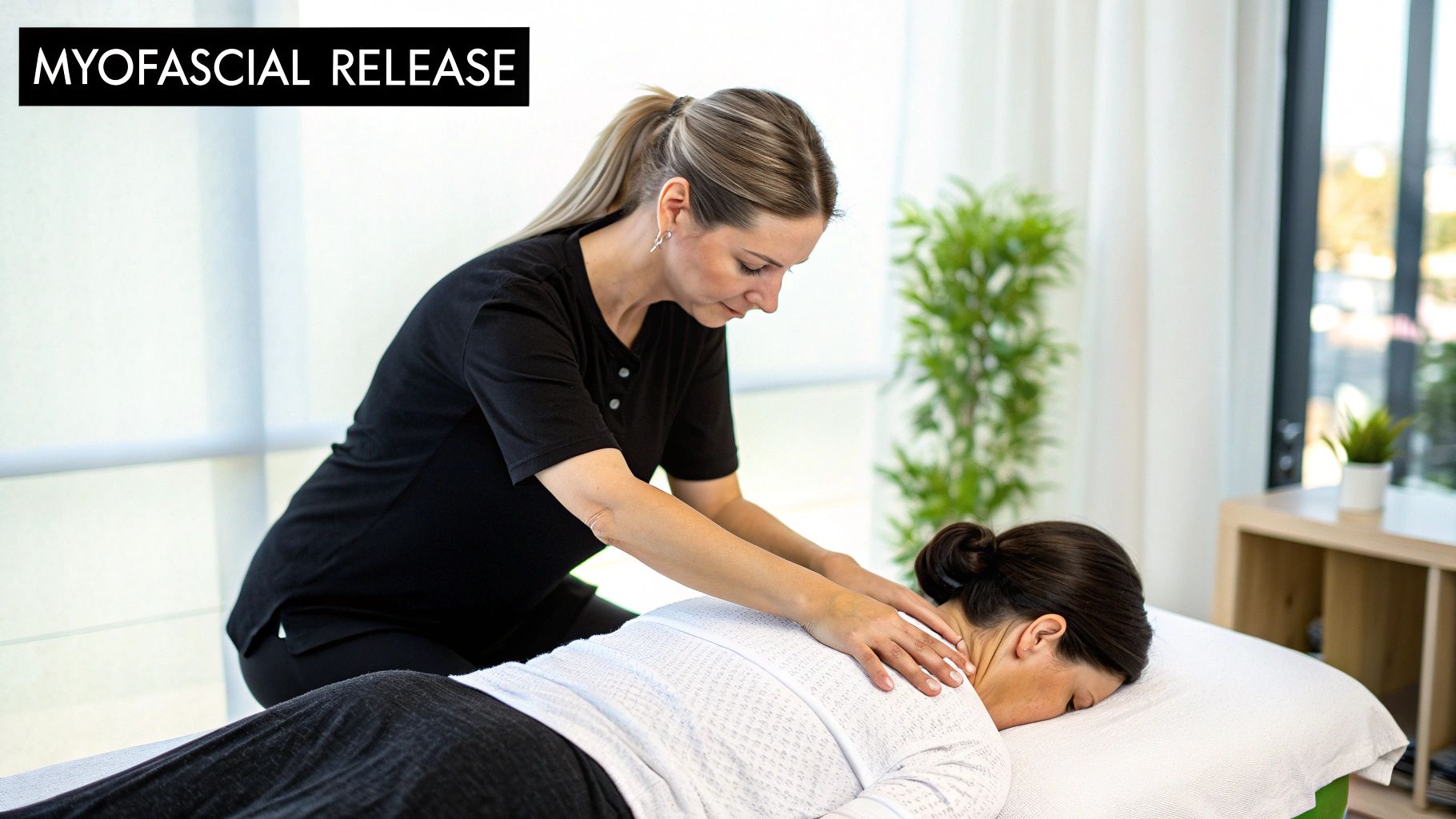
When you're dealing with persistent aches and that feeling of being constantly "tight," it’s easy to blame your muscles. And while they're part of the equation, the real problem often lies a layer deeper in your fascia.
Let's use another analogy. Imagine you're wearing a perfectly fitting, full-body sweater. It moves with you, no problem. Now, what if you get a snag in the shoulder? That one little snag doesn't just stay put—it pulls and creates tension across your chest, down your arm, and up your neck. That’s precisely how restricted fascia behaves. It creates problems far from the original site of the "snag."
This is where myofascial release therapy shines. Unlike a typical massage that might use faster strokes to work the muscles, this technique involves a therapist applying very slow, sustained pressure directly into a fascial restriction. This gentle but firm force gives the stiff, dehydrated fascia enough time to soften, lengthen, and get back its healthy, pliable texture. The goal isn't just to knead the muscle below, but to completely free up the tissue that’s holding it hostage.
Core Concepts of This Therapy
To really get a feel for how myofascial release works, it's helpful to see its core principles laid out. These are the foundational ideas that set it apart from other types of bodywork.
For a quick overview, this table breaks down the essentials of the therapy.
| Concept | Description | Primary Goal |
|---|---|---|
| Fascial Web Focus | The therapy treats the entire body as a single, interconnected system of connective tissue, not as isolated parts. | To address the root cause of pain, which may originate far from where it's felt. |
| Sustained Pressure | Gentle pressure is held on a restricted area for 3-5 minutes or longer, without oils or lotions. | To allow the tough, fibrous fascia enough time to slowly melt, lengthen, and release. |
| Restoring Mobility | The technique focuses on re-establishing the natural glide between fascial layers and the structures they surround. | To eliminate pain, improve range of motion, and restore overall functional movement. |
These principles work together to create profound and lasting change in the body's tissues.
"The fascial system is a three-dimensional web of connective tissue that surrounds, supports, and penetrates all muscles, bones, nerves, and organs. When it becomes restricted, it can create pain and dysfunction throughout the entire body."
A Different Approach to Healing
Myofascial release has deep roots in osteopathic medicine. Its origins can be traced back to Andrew Taylor Still, the founder of osteopathy, in the late 1800s. He was one of the first to truly recognize how restrictions in this tissue web could jam up the body's innate ability to heal itself—a core principle that still guides therapists today.
While myofascial release therapy zeroes in on the fascial system, it's one of many powerful tools for pain relief. For anyone curious about other hands-on treatments, you might find it useful to check out our guide on what is therapeutic massage and how it differs. But when it comes to untangling fascial restrictions, this specific approach truly stands on its own as a way to unlock lasting relief.
Getting to Know Your Body's Fascial Network
To really get what myofascial release therapy does, you first have to understand what it works on: your fascia. This isn't just some passive "packing material" filling the empty spaces in your body. It's an active, intelligent system that plays a huge role in how you move, how you feel, and how your body functions as a whole.
The best way to picture it is as a single, seamless web of connective tissue, almost like a 3D spiderweb, woven throughout your entire body. This amazing network wraps around every single muscle, bone, nerve, and organ, connecting you from head to toe. This is your fascia, and it's what gives your body its form and structure.
What Is Fascia Made Of?
Fascia gets its unique qualities from what it's made of. At its core, it's a mix of tough protein fibers floating in a gel-like liquid known as the ground substance.
- Collagen Fibers: Think of these as tiny, incredibly strong cables. They provide immense tensile strength and support, preventing your tissues from being overstretched or torn. They give fascia its toughness.
- Elastin Fibers: Just like the name implies, these fibers are stretchy. They allow the fascia to be pliable, giving you the flexibility to move freely and without feeling restricted.
When everything is working right, this combination of strong collagen and stretchy elastin, all lubricated by the ground substance, allows for a smooth, effortless glide between tissues. Your muscles can contract, your limbs can move, and everything just works. It's a beautifully designed system for seamless motion.
Your fascial system isn’t just a bunch of separate coverings. It's one continuous, interconnected network. When you pull or tighten one part of this web, that tension can ripple out to distant areas—much like tugging on a thread in a sweater can cause a pucker somewhere else entirely.
When Good Fascia Goes Bad
Unfortunately, this finely tuned system can get thrown out of whack. Things like a sudden injury, the repetitive strain from your favorite sport, chronic stress, or even just sitting with bad posture can cause your fascia to change for the worse. The tissue, which should be supple and hydrated, starts to dry out and stiffen up.
It's like the difference between a wet sponge and a dry one. The wet sponge is soft and pliable, but when it dries out, it becomes hard and brittle. When fascia dehydrates, the collagen fibers can begin to stick to each other, forming dense, tough spots we call adhesions or "knots."
These adhesions are a big deal. They aren't just sore spots; they can put a tremendous amount of tension on whatever they're surrounding—sometimes creating pressure of up to 2,000 pounds per square inch. That kind of constant force can compress nerves, choke off blood flow, and seriously limit how well your muscles can work.
The Domino Effect of Tight Fascia
Once an adhesion forms, it creates a drag on the entire fascial web. This is the key reason why the source of your pain is often not where you actually feel the ache.
For instance, a fascial restriction in your neck—maybe from hunching over a laptop all day—can create a pulling tension down your back and into your shoulder. You might feel a nagging pain in your shoulder, but rubbing it will never provide lasting relief. Why? Because the root cause, the "snag" in the fascial web, is actually in your neck. This phenomenon, where pain shows up in a seemingly unrelated spot, is a classic sign of fascial trouble.
Understanding this interconnectedness is crucial. It’s why myofascial release therapy is so effective. Instead of just chasing the symptom (the sore shoulder), the therapy aims to find and release the source of the problem (the neck adhesion), bringing the whole system back into balance.
How Trigger Points Create Referred Pain
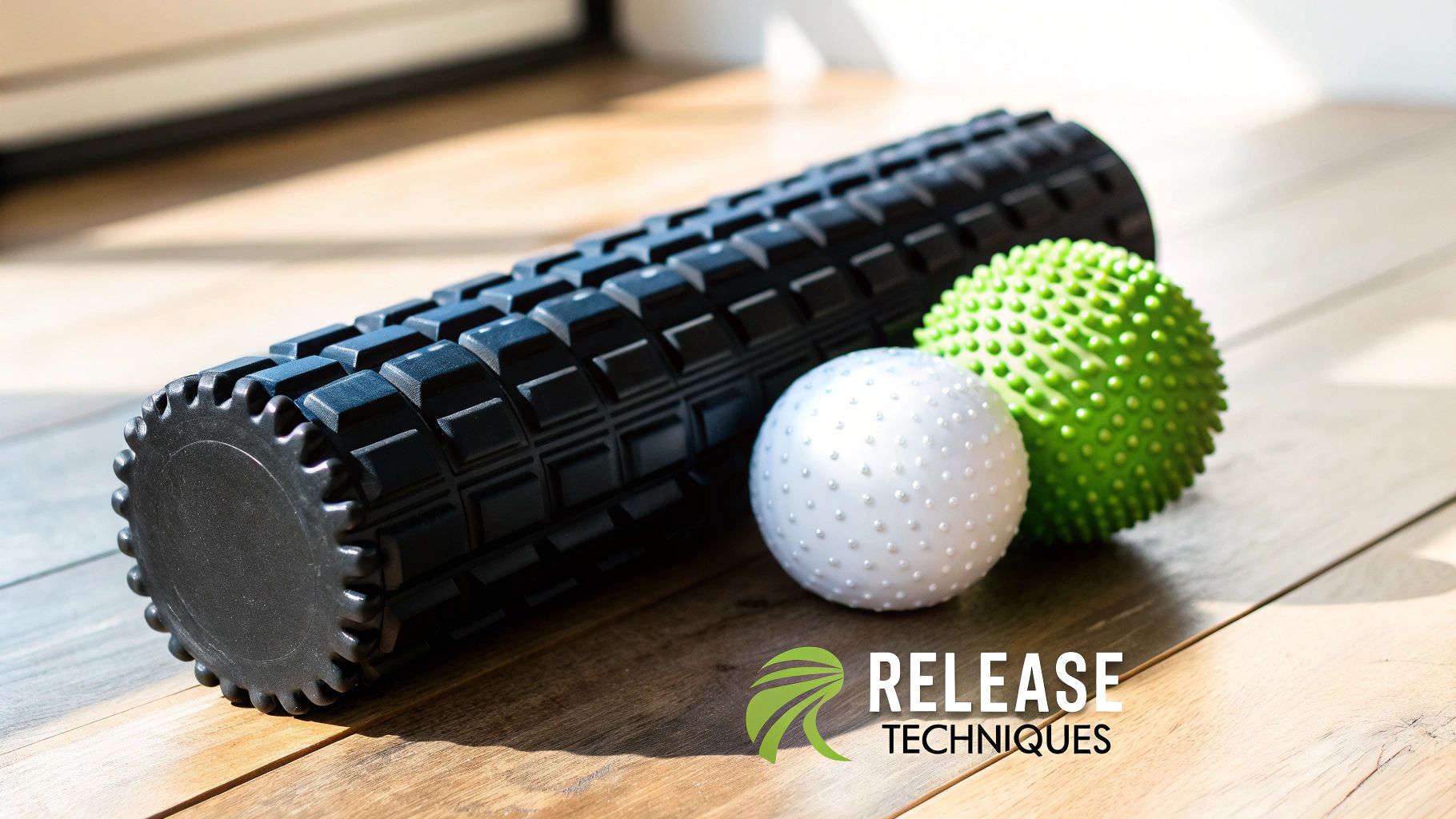
We’ve all felt them—those stubborn, painful “knots” that seem buried deep inside a muscle. They’re more than just simple sore spots. In myofascial release therapy, we call these Myofascial Trigger Points (MTrPs), and they're the tiny, hyper-irritable epicenters of dysfunction within your fascia.
A trigger point is a small, contracted nodule inside a taut band of muscle tissue. What makes it so tricky is its ability to "broadcast" pain to other, seemingly unrelated parts of the body. This is a phenomenon called referred pain, and it’s why so many aches and pains feel mysterious and are so hard to pin down.
For instance, you might be dealing with persistent headaches that feel like they're coming from behind your eye. You could try everything to treat the headache directly, but the real culprit might be a trigger point in your upper trapezius muscle, which is referring that pain signal all the way up into your head.
The Science Behind Referred Pain
So, how does a knot in your shoulder cause a headache? It all comes down to the nervous system. When a trigger point forms, it creates constant, low-level irritation. This sends a barrage of pain signals to your spinal cord, which can get overwhelmed and confuse your brain about where the pain is actually originating.
This concept isn't new. It was explored in depth during the 20th century by pioneers like Drs. Janet Travell and David Simons. Starting in the 1940s, they painstakingly mapped out these trigger points and their corresponding referred pain patterns. Their work culminated in the foundational 1983 text, 'Myofascial Pain and Dysfunction: The Trigger Point Manual.' And there's compelling evidence of how powerful this connection is; a 1980 study found that 80% of patients reported pain relief after receiving simple saline injections into their trigger points. You can learn more about the history of trigger point research and its findings.
Real-World Examples of Referred Pain
Understanding these pain maps is the key to finally getting relief. Here are a few classic examples I see all the time:
- Sciatica-Like Symptoms: A trigger point in the gluteus minimus muscle can shoot sharp, radiating pain down the back of the leg, perfectly mimicking the symptoms of true sciatica.
- Tension Headaches: As we mentioned, trigger points in the neck and upper shoulders are notorious for causing headaches that feel like a tight band around the head or a dull ache behind the eyes.
- Jaw and Tooth Pain: Knots in the masseter (jaw) muscle can refer pain directly into the teeth, making people think they have a dental problem when the issue is purely muscular.
Myofascial release therapy is designed specifically to hunt down these pain generators. It’s not like a general massage that temporarily soothes a sore area. Instead, it uses slow, sustained pressure directly on the trigger point.
This targeted pressure helps to "deactivate" the trigger point. The idea is to release the contraction, bring blood flow back to the starved tissue, and break that cycle of persistent pain signals. By treating the source, both the local tenderness and the referred pain can finally start to resolve. This is also a key principle in self-care, and you can learn more about how to get rid of muscle knots on your own in our guide.
The Tangible Benefits of Myofascial Release
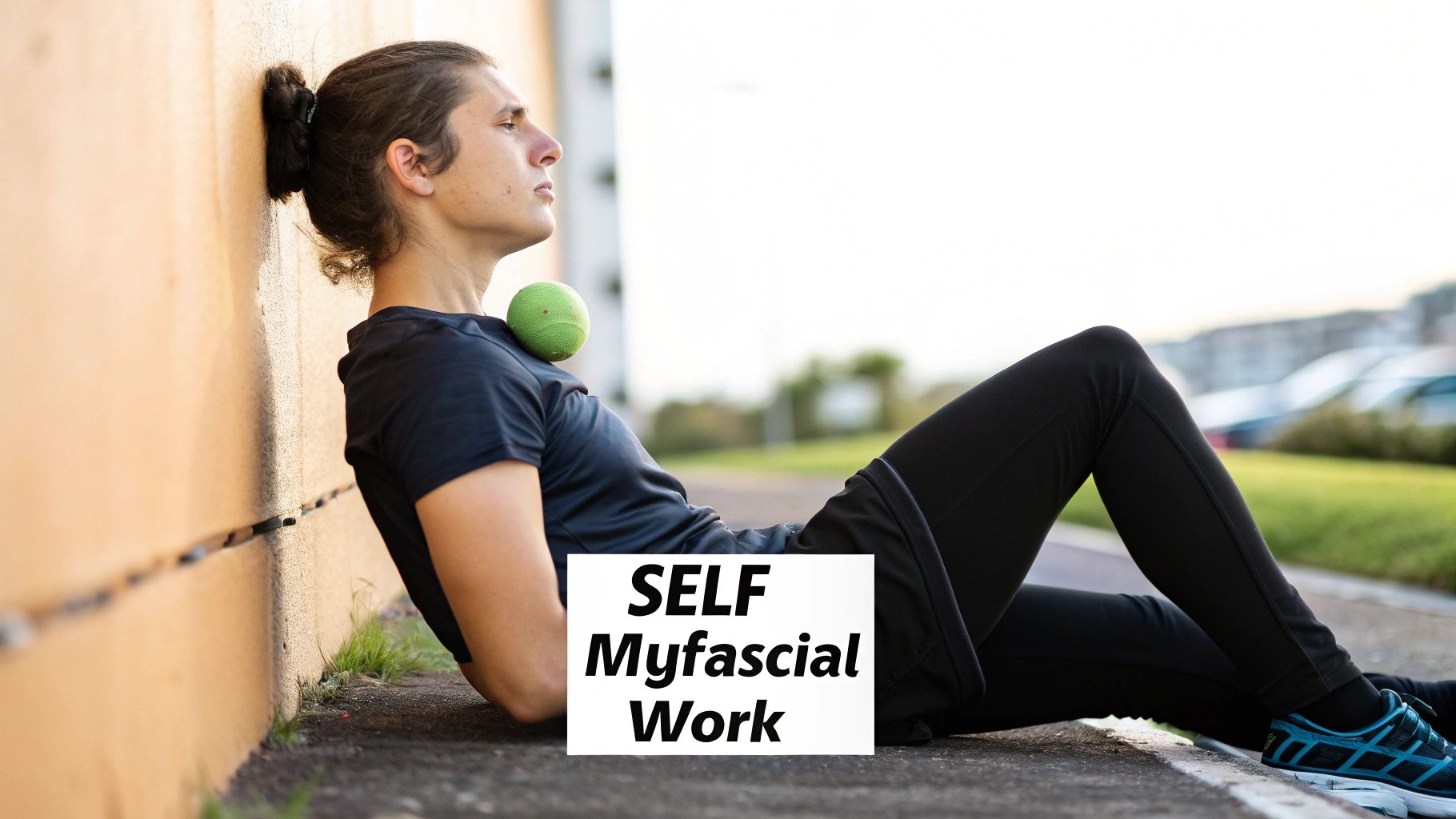
It’s one thing to understand the science behind myofascial release, but what really matters is how it feels in your own body. This isn't just theory; it’s a therapy that delivers real, tangible improvements, helping you move from a state of constant discomfort to one of genuine ease. We're not just talking about temporary relief, but about restoring your body's natural balance.
For so many people, the biggest win is a dramatic reduction in chronic pain. Conditions that just won't quit—like fibromyalgia, tension headaches, and nagging low back pain—often have a strong fascial component. By releasing the deep-seated restrictions that pinch nerves and pull on muscles, this therapy can turn down the volume on those persistent pain signals that get in the way of your life.
This is particularly true for anyone dealing with the postural strain of modern life. All those hours spent slumped over a desk can cause the fascia in your neck, shoulders, and hips to shorten and tighten, pulling you into that familiar forward hunch. Myofascial release works to lengthen these exact tissues, helping you stand taller and sit more comfortably without even thinking about it.
Unlocking Greater Freedom of Movement
One of the first things people notice is a profound improvement in their range of motion. When your fascia is tight and restricted, it’s like trying to move while wearing a jacket that’s two sizes too small. Every movement feels stiff and requires far too much effort. Freeing up these adhesions lets your muscles and joints glide past each other the way they were designed to.
By restoring the natural slide and glide between fascial layers, myofascial release therapy helps you move with more ease and less tension. This translates to deeper squats, a fuller golf swing, or simply being able to reach the top shelf without wincing.
This can be a complete game-changer, especially if your job or lifestyle involves repetitive motions or long periods of sitting. If you're struggling with discomfort from being at a desk all day, you can find other effective strategies to reduce back pain from prolonged sitting that work well alongside this therapy to build a more resilient body.
Boosting Athletic Performance and Recovery
For athletes and active people, healthy fascia isn't just a nice-to-have; it's essential. It’s the key to powerful, efficient movement and staying off the sidelines. Myofascial release can give you a real edge by targeting a few critical areas:
- Accelerated Muscle Recovery: The therapy boosts circulation to tired tissues, helping to flush out the metabolic byproducts that cause soreness. This means you can bounce back faster between tough workouts.
- Enhanced Performance: When your muscles aren't being held back by tight fascia, they can contract more powerfully and efficiently. This can lead to real, measurable improvements in strength, speed, and overall athletic output.
- Injury Prevention: By releasing imbalances and adhesions, you correct faulty movement patterns before they can turn into strains, tears, or other serious injuries.
Whether you're an office worker looking for relief from a stiff neck or a runner chasing a new personal best, myofascial release offers a clear path to a more functional life. While it's a unique practice, it shares a common goal with other wellness techniques. If you're exploring ways to manage discomfort, our guide to pain relief massage therapy can offer more insight into other effective hands-on approaches.
Choosing Your Myofascial Release Method
So, you’re ready to tackle those tight spots and fascial restrictions. Great. You’ve got two main routes you can go down: working with a trained professional or taking matters into your own hands with some at-home tools.
Both paths are incredibly valuable. One gives you expert guidance and precision, while the other offers everyday convenience and control. Honestly, the best approach isn’t always an either/or choice. For many people, a smart combination of both delivers the most profound and lasting relief. Let's break down what each option looks like.
Working with a Myofascial Release Professional
Going to a certified professional—like a physical therapist or a licensed massage therapist who specializes in this work—is the gold standard for dealing with complex or stubborn issues. Think of it as calling in an expert mechanic for your body.
During a session, a therapist uses their hands, knuckles, or even elbows to apply slow, sustained pressure to those sticky, restricted areas. Their fingers are trained to feel for the subtle changes in tissue texture, hunting down adhesions you probably don't even know exist. This skilled touch is what makes all the difference.
A pro has a whole toolbox of techniques they can tailor specifically to you:
- Direct Myofascial Release: This is the classic approach. The therapist sinks deep into a restriction with steady pressure and holds it, waiting for the tissue to finally let go. It's incredibly effective for breaking up those really stubborn knots and trigger points.
- Indirect Myofascial Release: A much gentler method where the therapist applies a light stretch, allowing your body's own reflexes to unwind the tension naturally. It coaxes the fascia to release rather than forcing it.
Best of all, a therapist can connect the dots. They can figure out why your shoulder pain is actually coming from your tight pecs, addressing the root cause instead of just chasing the symptoms around.
Self-Myofascial Release at Home
Self-myofascial release, or SMR, is all about empowering you to take care of your own tissues. This is your daily maintenance plan, perfect for managing general soreness, boosting flexibility, and keeping the benefits of your professional sessions going strong.
It’s your at-home kit for keeping your fascia happy and healthy. The most popular tools of the trade are probably already familiar:
- Foam Rollers: Your go-to for big muscle groups like the quads, hamstrings, and back.
- Therapy Balls: Perfect for zeroing in on smaller, trickier spots like the arches of your feet, your hips, or between your shoulder blades.
- Massage Guns: These use percussion (rapid pulsing) to break up tension and flood the area with blood flow.
The real magic of SMR is consistency. A professional can hit the reset button, but it’s the daily self-care that prevents new restrictions from setting up shop and keeps you feeling mobile and fluid.
A Head-to-Head Comparison
To help you figure out where to start, it's useful to see how professional therapy and SMR stack up against each other. They each have their strengths, and understanding them will help you build the right strategy for your body and your goals.
Comparing Professional Therapy vs. Self-Myofascial Release
| Aspect | Professional Therapy | Self-Myofascial Release (SMR) |
|---|---|---|
| Precision | Extremely high. A trained therapist can identify and treat specific fascial restrictions with expert accuracy. | Variable. Your ability to target the right spot depends on your own anatomical knowledge and body awareness. |
| Cost | Higher per session. You are paying for the therapist's time, expertise, and diagnostic skill. | Lower initial investment. Once you purchase a tool like a foam roller, it can be used indefinitely. |
| Convenience | Requires an appointment. You need to schedule sessions and travel to a clinic or spa. | Highly convenient. Can be done anytime, anywhere, making it perfect for daily maintenance or pre-workout warm-ups. |
| Best For | Complex or chronic pain, diagnosing referred pain, and creating a foundational treatment plan. | General soreness, daily maintenance, improving flexibility, and post-workout recovery. |
Ultimately, there’s no wrong choice here—both paths lead to a healthier fascial system. A professional can give you a clean slate and teach you where to focus your efforts, while SMR gives you the power to maintain those amazing results every single day.
When to Seek Professional Guidance
While self-myofascial release is fantastic for day-to-day upkeep, some situations just call for the skilled hands and diagnostic eye of a trained professional. Think of it this way: your foam roller is like a daily tune-up for your car, but professional myofascial release therapy is the deep-dive work done by a master mechanic who can find and fix the root of a tricky problem.
Knowing when to graduate from your living room floor to a therapist's table is crucial for your safety and for getting the results you're after. A certified pro can trace complex pain patterns and apply targeted treatments you simply can't replicate by yourself.
Finding a Qualified Practitioner
When you decide it's time for professional help, finding someone with the right credentials is a must. Not all massage therapists are trained in the specific, slow, sustained-pressure techniques that make this therapy so effective. You'll want to look for practitioners who have specialized training and certifications under their belt.
Your best bet is often one of the following:
- A Licensed Physical Therapist who has direct experience and coursework in myofascial release.
- A Certified Massage Therapist with advanced, dedicated training in myofascial techniques.
- An Osteopathic Physician who uses manual therapies as a core part of their practice.
Don't be shy about asking about their training and experience, especially with issues like yours. A good practitioner will have a solid grasp of the fascial system and know how to work with its restrictions safely and effectively.
A huge part of a professional session is the practitioner's ability to "listen" to your tissue. They can actually feel how your fascia is responding to pressure, changing their approach in real-time to get the best possible release. That’s a level of feedback you just can't get on your own.
This chart breaks down how the focused approach of myofascial release stacks up against traditional massage, showing just how effective it can be in a clinical setting.
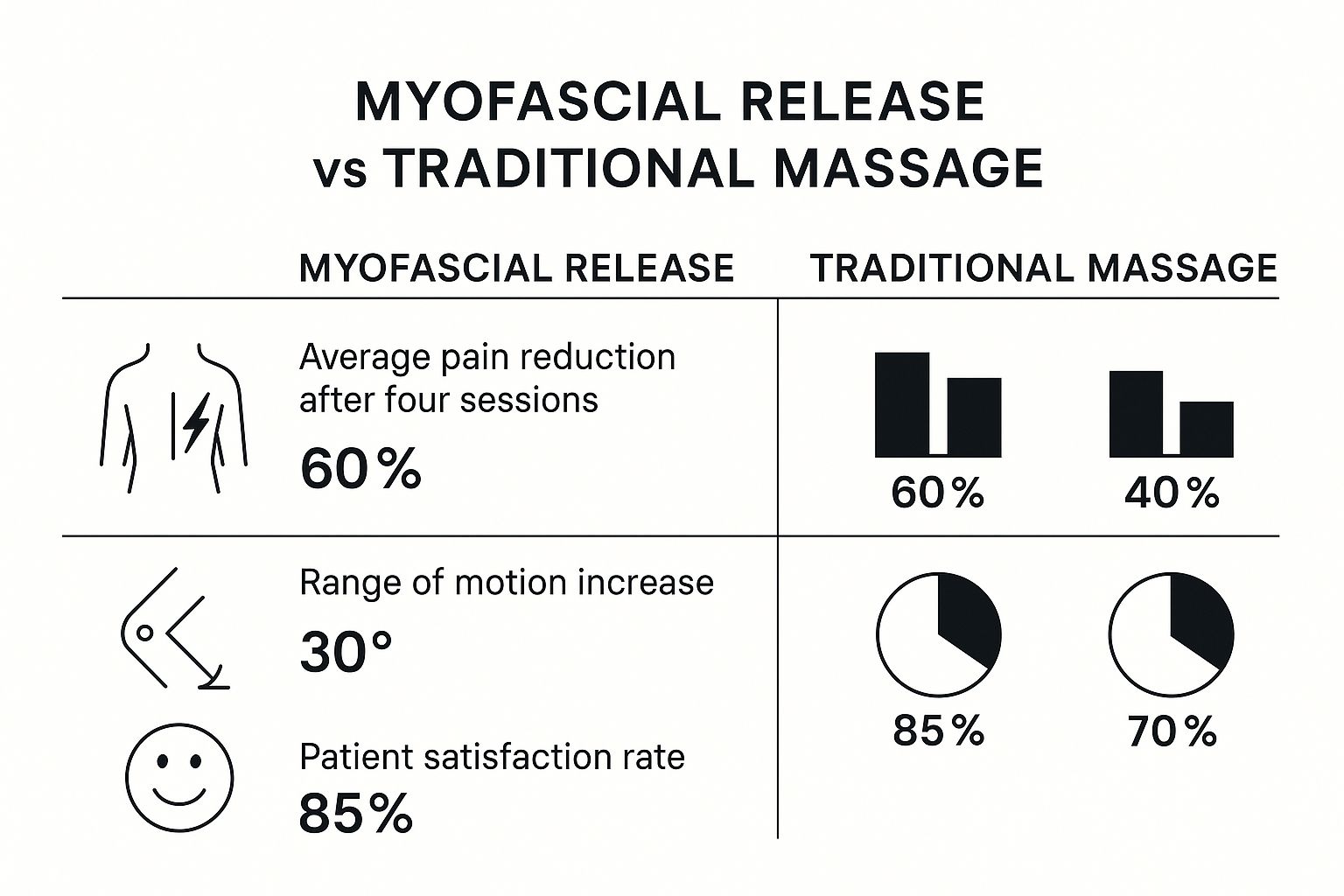
The data really highlights how the targeted nature of myofascial release often delivers bigger wins when it comes to reducing pain and improving mobility.
When to Avoid This Therapy
As great as it is, myofascial release therapy isn't for everyone or for every situation. Applying that kind of deep, sustained pressure can do more harm than good in certain cases. It's critical to avoid this therapy directly over any areas with:
- Open wounds, infections, or skin that is very fragile.
- Recent fractures or acute injuries that are still in the healing phase.
- Deep Vein Thrombosis (DVT) or a history of blood clots.
- Tumors or cancerous lesions.
Always be upfront and share your complete medical history with your practitioner before you start. This allows them to create a safe treatment plan and helps you know the difference between a normal, therapeutic sensation and a warning sign to stop.
Got Questions? We've Got Answers
It's smart to have questions when you're looking into a new type of bodywork like myofascial release. Let's tackle some of the most common ones so you know exactly what to expect on your path to feeling better.
Key Differences And Expectations
How Is This Different From Deep Tissue Massage?
That’s a great question, as they can both feel pretty intense. Think of it this way: a deep tissue massage is like a laser beam, focusing strong pressure on a specific, tight muscle knot.
Myofascial release, on the other hand, is more like slowly stretching a tangled net. It uses gentle, sustained pressure across a broader area to release the entire web of fascia. The goal is less about hammering out a single knot and more about restoring freedom of movement to the whole system.
How Soon Will I Feel Results?
Many people walk out of their very first session feeling looser and with a noticeable drop in their pain levels. It can be that quick.
But for those stubborn, long-term issues, real, lasting change comes from consistency. A series of sessions over a few weeks gives your body’s tissues the time they need to truly adapt, rehydrate, and learn a new, healthier pattern.
A quick heads-up: You'll likely feel some significant pressure or a "good hurt" sensation during the treatment, especially where you're holding a lot of tension. It should never be excruciating, though. Open communication with your therapist is key—they need your feedback to keep you comfortable and safe.
Can I Do Self-Myofascial Release Daily?
For general upkeep, absolutely. Using a foam roller or a ball for some gentle self-release can be a fantastic daily habit to keep things moving smoothly.
When it comes to the more intense sessions, though, give your body a break. Spacing these out allows your fascia to properly recover, rehydrate, and adjust to the changes you've made. This is how you get the benefits without causing unnecessary soreness or bruising.
At La Moon Massage and Facial, our skilled therapists specialize in targeted wellness treatments designed to soothe your mind and body. Book your premium massage therapy session today and take the first step toward lasting relief.
How to Treat Tennis Elbow Fast and Effectively
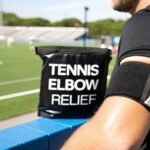
When you first feel that sharp, persistent pain on the outside of your elbow, your gut reaction might be to ignore it and push through. Don't. That pain is your body's alarm bell, signaling that the tendons connecting your forearm muscles to your elbow are inflamed, overworked, and need a break.
This isn’t just a "tennis" problem, despite the name. I’ve seen it in office workers from constant typing, gardeners after a long weekend, and even new parents from lifting a baby. The first 48 to 72 hours are absolutely critical—what you do right away will set the tone for your entire recovery.
The First-Aid Plan: Immediate Steps for Relief
Your top priority is to calm the inflammation. Think of it as putting out a small fire before it spreads. This is where the time-tested R.I.C.E. method comes into play. It’s not a permanent fix, but it's the essential first response to manage the acute pain and stop the tendon damage from getting worse.
Here’s exactly what you need to do:
- Rest: This is non-negotiable. Stop doing the activity that hurts. Whether it’s typing, lifting, or gripping, give that arm a complete break. Continuing to push it will only deepen the micro-tears in the tendon.
- Ice: Grab a cold pack or even a bag of frozen peas, wrap it in a light towel, and apply it to the most painful spot for 15-20 minutes at a time. Do this several times throughout the day, especially after any accidental strain. The cold helps constrict blood vessels, which is fantastic for reducing swelling and dulling the pain.
- Compression: A simple elastic compression bandage can be a huge help. Wrap it snugly—but not too tightly—around your forearm, starting just below the elbow. This provides gentle support and helps prevent fluid from building up. If your hand starts to tingle or feel cold, it's too tight.
- Elevation: Whenever you're sitting or resting, try to prop your arm up on pillows so your elbow is above the level of your heart. It sounds simple, but using gravity to your advantage helps drain excess fluid and further reduces swelling.
This image lays out the journey from that initial twinge of pain to a structured recovery plan.

It’s a great visual reminder that healing happens in stages. You have to patiently work through the initial rest phase before moving on to rehabilitation.
Quick Actions vs. Lasting Recovery
It's easy to confuse immediate relief with a long-term solution. The R.I.C.E. method is for damage control, while true recovery involves strengthening and prevention. This table breaks down the difference.
| Care Strategy | Primary Goal | Key Actions |
|---|---|---|
| Quick Actions | Reduce acute pain and inflammation | Rest, Ice, Compression, Elevation |
| Lasting Recovery | Heal tendon and prevent re-injury | Stretching, Strengthening exercises, Massage, Form correction |
Think of it this way: Quick actions stop the problem from getting worse. Lasting recovery makes sure it doesn't happen again.
Setting Realistic Expectations for Healing
It's crucial to understand that tennis elbow (medically, lateral epicondylitis) takes time to heal. These initial conservative steps are the cornerstone of treatment, but you need to be patient.
According to an in-depth medical review of treatment strategies, most people see significant improvement over several months, with many feeling better within 12 months by sticking to a consistent care plan. The initial phase is all about calming things down so your body can actually start the repair process.
My Key Advice: For the first few days, your only job is damage control. Focus entirely on rest and ice. Resist the urge to start stretching or strengthening until that initial, sharp inflammation has settled.
You wouldn't try to repave a road with cars still driving on it. First, you have to put up the "road closed" signs. R.I.C.E. is your "road closed" sign, giving your tendon the protected space it needs to begin healing. A few days of disciplined rest now can save you months of nagging pain down the line.
Proven At-Home Remedies to Manage Daily Pain
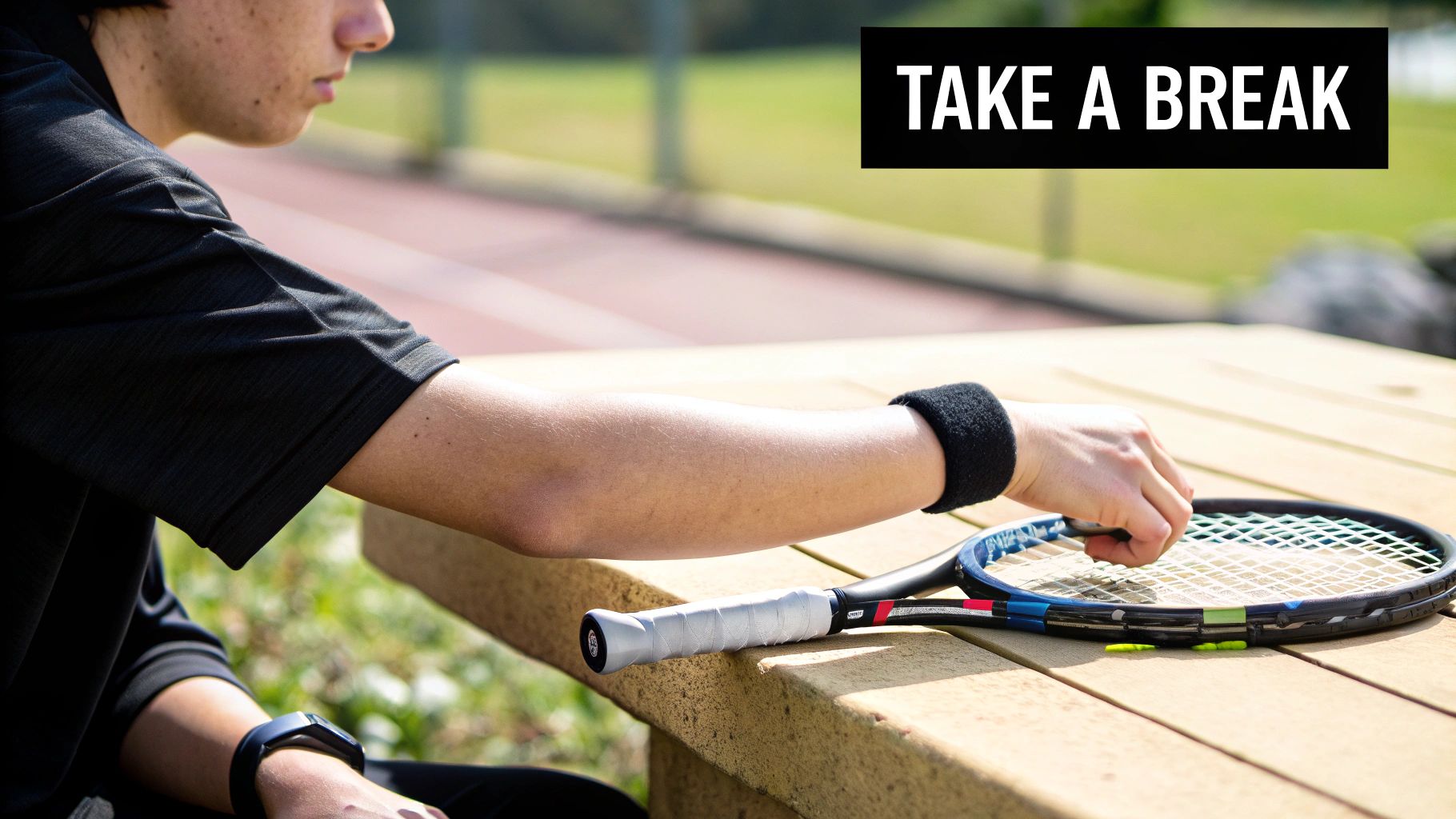
Once you’ve settled down the initial, angry inflammation with rest and ice, it's time to shift gears. The next phase is all about smart, daily management—building a personal toolkit of at-home strategies to keep that dull ache from ruining your day. Learning how to treat tennis elbow isn't a one-and-done deal; it's about weaving these simple habits into your routine.
It’s not just what you do, but when you do it. Take the classic heat vs. ice debate. It’s not a simple choice, because they serve completely different purposes. Using them strategically can make a world of difference in your comfort and long-term recovery. This is where you learn to manage your symptoms so your body can actually heal.
The Strategic Use of Ice and Heat
Think of ice and heat as two different specialists for two different problems. Getting this right is key to managing your elbow pain from one day to the next.
- Ice After Activity: Always, always use ice after any activity that strains your forearm. This could be a workout, a few hours of gardening, or even a long day at the keyboard. Applying a cold pack for 15 minutes calms down any new inflammation and tells that angry tendon to settle down before it flares up.
- Heat Before Stretching: Before you start any gentle stretching or strengthening, grab a heating pad. Applying heat for 15-20 minutes boosts blood flow to the forearm, helping to relax those tight, overworked muscles. This makes the tissue more pliable, so you get a much better, safer stretch without causing more irritation.
A crucial rule of thumb: never apply heat to an injury that's actively swollen and throbbing. You'll just make the inflammation worse. Save heat for those moments when your muscles just feel stiff and need to loosen up.
Topical Treatments for Targeted Relief
While popping an ibuprofen can take the edge off, it affects your whole body. Topical anti-inflammatory gels or creams are a much more direct approach, delivering relief right where you need it. This focus helps minimize the risk of the systemic side effects that can come with oral pain relievers.
In fact, clinical guidelines often suggest a "watchful waiting" approach, combined with the short-term use of these topicals. Research gives high marks to topical NSAIDs for short-term pain relief, making them a solid part of any conservative treatment plan.
Pro Tip: When you apply a topical gel, don't just slather it on. Gently massage it into that tender spot on the outside of your elbow until it’s fully absorbed. This not only helps the medicine work its way in but also doubles as a mini-massage to ease muscle tension.
Combining these remedies can really amplify your results. If you're dealing with all-over muscle soreness, you might also want to check out our guide on the benefits of massage for muscle pain to add another layer to your recovery plan.
The Game-Changing Role of a Forearm Brace
A simple forearm brace or strap might just be the most valuable tool in your arsenal. It’s not about immobilizing your arm; it works by applying targeted pressure just below your elbow.
This pressure cleverly changes the angle at which your tendon pulls on the bone, redirecting the stressful forces away from the inflamed area. Think of it as a "dummy tendon" that takes the hit for you during activities like gripping, lifting, or typing.
Here’s how to get the most out of it:
- Wear it during aggravating activities. I found it was a lifesaver when working on my laptop or doing chores like carrying groceries.
- Get the position right. It should be snug, but not cutting off your circulation. Place it about one finger-width below the most painful point on your elbow.
- Don't wear it 24/7. Your muscles still need to do their job to stay strong. Use the brace for support during specific tasks, but take it off when you're resting.
This simple device gives the extensor carpi radialis brevis (ECRB) tendon—the main culprit in tennis elbow—a chance to rest even while you're moving. That’s the secret to treating tennis elbow without having to put your life on hold.
Essential Stretches and Exercises for Recovery

Once you’ve gotten the initial inflammation and pain under control, it’s time to shift gears. This is where the real work—and the real healing—begins. We need to focus on rebuilding strength and getting flexibility back into those overworked forearm tendons through active recovery.
This isn’t about jumping straight back into your old routine. Instead, think of it as a careful, deliberate process of re-introducing movement. We'll start with gentle stretches to ease the tension and then gradually add some light resistance work. The goal is to remodel and strengthen the injured tissue so it can handle daily demands again.
From my own experience with nagging tennis elbow, this was the phase that made all the difference. The most important rule? Always listen to your body. A little discomfort is okay, but sharp pain is your signal to stop.
Gentle Stretches to Begin Your Healing
First things first: stretching. The extensor muscles along the top of your forearm have become incredibly tight from overuse, and our initial job is to gently lengthen them. The best place to start is with the classic wrist extensor stretch. It’s simple, you don’t need any equipment, and you can do it just about anywhere.

Take a look at the image above—notice how the arm is held straight while the other hand gently guides the wrist downward. This exact position targets those forearm extensor muscles that attach right at that painful spot on your elbow.
Here’s how to do it right:
- Hold your affected arm straight out, palm facing the floor.
- Let your wrist bend down so your fingers point toward the ground.
- With your other hand, gently pull the stretching hand toward you.
- You’re looking for a mild to moderate pull on top of your forearm. If it hurts, ease up.
- Hold the stretch for 20-30 seconds, then release. Repeat this 3-5 times.
Try to work this stretch into your day several times, especially before you do anything that might involve gripping or lifting. It's the perfect warm-up for the strengthening work we'll get into next.
A Crucial Insight: I learned the hard way that consistency beats intensity. Doing this gentle stretch for a few minutes multiple times a day brought far more relief than one long, aggressive session that just left my elbow feeling angry and irritated.
Progressing to Strength-Building Exercises
Once stretching feels comfortable and that initial, sharp pain has faded, it's time to start building back some strength. You have to start small here. We’re not trying to become bodybuilders; we're trying to encourage the tendon to heal in a stronger, more resilient way. Weak grip strength is a hallmark of tennis elbow, so restoring it is a top priority.
Here are a couple of my go-to exercises that are incredibly effective.
1. Reverse Wrist Curls (with a Soup Can)
This move directly works the extensor muscles. You don't need a fancy dumbbell—a can of soup or a small water bottle provides the perfect amount of light resistance to start.
- Sit down and rest your forearm on your thigh, with your palm facing down.
- Hold the can and let your wrist hang just past your knee.
- Slowly lower the can as far as is comfortable, then just as slowly, raise it back up.
- The key is a smooth, controlled motion. Aim for 3 sets of 10-15 repetitions.
If you feel any sharp pain, stop immediately. It just means your elbow needs a few more days of stretching before it's ready for this.
2. The Tyler Twist (with a FlexBar)
This exercise is famous in the rehab world for a reason. Using a simple tool called a FlexBar, it creates an "eccentric contraction," which means the muscle gets longer while it's under tension. This specific type of movement is a powerhouse for healing stubborn tendon injuries.
- Hold the FlexBar vertically with the hand of your sore arm, wrist bent backward (extended).
- Grab the top of the bar with your good hand, palm facing away from you.
- Twist the bar by turning your top hand toward you.
- Keeping the twist, extend both arms straight out in front of you.
- Now for the magic: slowly untwist the bar by letting the wrist of your injured arm flex forward. This controlled release is the most important part.
- Shoot for 3 sets of 15 repetitions each day.
This unique movement was a complete game-changer for my own recovery. It targets the tendon in a way that truly promotes healing.
Finally, while these specific moves are crucial, don't forget the bigger picture. Maintaining overall fitness is key, as a healthy body is better at healing itself. You can find some great general exercise guidance to help you stay active without making your elbow worse. The trick is to keep moving without aggravating the injury.
When to Consider Professional Medical Treatments
Sometimes, despite your best efforts with ice, stretches, and a brace, the stubborn pain of tennis elbow just refuses to back down. If you've tried all the home remedies and the ache is still hanging around after a few weeks, don't see it as a failure. Think of it as a clear signal from your body that it’s time to call in the professionals.
Walking into a doctor's office or a physical therapy clinic shouldn’t feel intimidating. It’s simply upgrading your recovery toolkit. You're moving beyond the basics to tap into specialized strategies that can finally break the pain cycle and kickstart real, lasting healing. Knowing what to expect empowers you to have a productive conversation and choose the right path forward.
What to Expect from Physical Therapy
For most people, physical therapy is one of the most effective routes to recovery. This is so much more than just being handed a worksheet of exercises. A good physical therapist is like a biomechanics detective, carefully analyzing your movements, posture, and strength to uncover the root cause of your pain.
A typical session is a hands-on, dynamic process that often includes:
- Manual Therapy: This is where the therapist gets to work directly on the problem area. They might use specialized massage techniques to break down tough scar tissue in the tendon or gentle joint mobilizations to restore full movement in your wrist and elbow. It’s a level of targeted relief you just can’t achieve on your own.
- A Tailored Exercise Plan: They’ll do more than just show you an exercise; they'll ensure you’re doing it perfectly. From eccentric movements like the Tyler Twist to strengthening exercises for your shoulder and wrist, proper form is everything.
- Smarter Movement Strategies: Your therapist will help you spot the everyday habits—like how you grip your phone or position your arm at your desk—that are secretly making things worse. Then, they’ll teach you better ways to move.
For many athletes and active individuals, targeted massage is a huge part of the puzzle. To see how it fits into a broader recovery plan, check out our guide on massage for sports injuries.
A Clear Look at Corticosteroid Injections
If your pain is intense and unrelenting, your doctor might bring up the option of a corticosteroid injection. These shots deliver a powerful anti-inflammatory right to the site of the injury, and the relief can be fast and dramatic. For someone sidelined by pain, it can feel like a lifesaver.
But it’s important to have an honest conversation about the bigger picture. The short-term relief is undeniable, but the evidence for long-term healing is a bit more complicated. Injections are fantastic at calming down inflammation, but they don't actually fix the underlying tendon damage.
Research has shown that while injections can be a useful tool, they might not be the best long-term play. One study found that while 69% of patients did well with injections within a year, physical therapy had a much higher success rate at 91%. Interestingly, even a "wait and see" approach had an 83% success rate, highlighting the body's incredible ability to heal. You can dig into the data in this comparative study on tennis elbow treatments.
This tells us that while a shot can provide a much-needed window of relief, an active approach like physical therapy is often the key to a more sustainable, long-term fix.
Exploring Newer Treatment Options
What happens when even the standard treatments don't cut it? Fortunately, medical science is always evolving, offering new hope for those stubborn cases of tennis elbow. If your recovery has stalled, your doctor might discuss a few of these newer, more advanced options.
Two treatments that are gaining a lot of ground are:
- Platelet-Rich Plasma (PRP) Injections: This procedure uses your body's own healing power. A small amount of your blood is drawn and spun in a centrifuge to concentrate the platelets, which are packed with natural growth factors. This powerful solution is then injected back into the damaged tendon to stimulate a robust healing response.
- Extracorporeal Shockwave Therapy (ESWT): This is a non-invasive treatment where a special device sends high-energy acoustic waves to the injured tissue. It sounds intense, but the goal is to create micro-trauma that essentially jump-starts your body’s repair mechanisms, helping to reduce pain and improve function over time.
These approaches mark a shift toward regenerative medicine—focusing on actually repairing the tissue instead of just managing the symptoms. By understanding all your options, from physical therapy to these newer techniques, you can work with your doctor to build the best plan to finally put tennis elbow behind you.
Lifestyle Adjustments to Prevent Future Flare-Ups

Getting rid of the immediate pain is one thing, but true recovery means making sure it doesn't come back. Once you've moved past the acute stage, your focus needs to shift from treatment to prevention. This is all about making small, sustainable changes to your daily life that will have a huge impact on your elbow's long-term health.
This isn’t about some massive life overhaul. You don't have to quit your job or give up the sports you love. It’s simply about learning to move smarter and protect your body from unnecessary strain.
Reinforce Your Workspace Ergonomics
For so many of us, the desk is ground zero for repetitive strain. Each mouse click and keystroke can contribute to the problem, so if your workspace isn't set up correctly, it could be the very reason your tennis elbow keeps acting up. Creating an ergonomic setup is one of the most powerful preventative moves you can make.
I’ve personally used these adjustments to escape the daily strain of a desk job:
- Mouse and Keyboard Position: Your keyboard and mouse should be positioned so your forearms are parallel to the floor. You want to avoid bending your wrists up or down. A vertical mouse was a game-changer for me, as it keeps your wrist in a more neutral "handshake" position.
- Chair Height and Armrests: Adjust your chair so your feet can rest flat on the floor with your knees at a 90-degree angle. The armrests should gently support your elbows, taking the load off your shoulders without making you hunch.
These simple fixes drastically reduce the constant tension on your forearm extensors—the exact muscles at the heart of tennis elbow. For a more comprehensive, full-body approach, check out our guide on https://blog.lamoondayspa.com/preventing-repetitive-strain-injuries/ for more detailed strategies.
Master Proper Form in Everyday Activities
Prevention doesn't stop when you leave the office. The way you lift groceries, work in the garden, or even swing a racket plays a massive role in keeping your elbows healthy. It all comes down to being mindful of your body mechanics, whatever you're doing.
Think about your daily tasks and run through this mental checklist:
- Lifting: When you pick something up, whether it's a bag of dog food or a small child, keep the object close to your body. Let your larger bicep muscles do the heavy lifting instead of extending your arm and forcing your smaller forearm muscles to take the brunt of the weight.
- Gardening or Manual Work: Look for tools with thicker, padded grips. This reduces how tightly you need to squeeze. Also, remember to take frequent breaks and switch hands to give each side a rest.
- Sports: If you’re a racket sports player, it's worth getting a pro to check your form. A simple issue like an incorrect grip size or a flawed backhand technique can place tremendous stress right on your elbow.
Key Takeaway: The goal is to distribute force across larger, stronger muscle groups. Don't let it all funnel into the delicate tendons of your elbow. This principle is your secret weapon for nearly any physical activity.
The Importance of Warm-Ups and Overall Health
Never, ever jump into an activity cold, especially one that’s given you trouble before. A simple 5-minute warm-up is your best line of defense against re-injury. Before you start gardening or head to the tennis court, do some light cardio, like jogging in place, to get your blood flowing. Follow that up with the same gentle wrist stretches you used during your recovery.
Finally, don't underestimate the power of your general well-being. Your body’s ability to repair itself is directly tied to your overall health. Things like proper hydration and a balanced diet provide the essential building blocks your body needs to maintain strong, resilient tendons. Getting enough rest is also non-negotiable; understanding the impact of sleep on overall health is a critical piece of the healing puzzle. These foundational habits are the bedrock of lasting prevention.
Your Top Questions About Tennis Elbow, Answered
When you're dealing with a nagging injury like tennis elbow, it's natural to have a lot of questions. Getting clear, practical answers can give you peace of mind and, more importantly, help you stick to a recovery plan that actually works. Let's tackle some of the most common questions I hear from people trying to heal their elbow pain.
How Long Does Tennis Elbow Really Take to Heal?
This is always the first thing people ask, and the honest answer is: it depends. With a consistent at-home plan—I'm talking rest, smart icing, and the right gentle exercises—most people start feeling a real difference in about 4 to 6 weeks.
But getting back to 100%, especially if you've been ignoring the pain for a while, can take a lot longer, sometimes anywhere from 6 to 12 months. Patience and consistency are everything. The biggest mistake I see is people jumping back into their old activities the second the pain subsides. That's a surefire way to end up right back where you started.
My Advice: Think of healing in phases, not as a single finish line. Your first job is to calm the pain down. The second is to rebuild strength and flexibility. If you respect each phase, you'll actually get better faster in the long run.
When Should I Give Up and See a Doctor for Elbow Pain?
While you can manage most cases of tennis elbow at home, there are definitely times when you need a professional opinion. It’s time to book an appointment with a doctor if you notice any of these red flags:
- The pain is severe and just not getting better with basic home care.
- You’re feeling numbness or a constant tingling in your hand or arm.
- You’ve been doing all the right things for 2-3 weeks with zero improvement.
- You can't do simple things like hold a coffee cup or open a door without pain.
A proper diagnosis is critical. A doctor can rule out other issues that can masquerade as tennis elbow, like a pinched nerve in your neck or even arthritis. This is also your gateway to proven treatments like physical therapy, which has an incredibly high success rate for this condition.
Can I Still Work Out with Tennis Elbow?
Yes, absolutely—but you have to be smart about it. The golden rule is simple: if it causes that specific, sharp pain in your elbow, don't do it. Targeted stretches and strengthening exercises for your forearm aren't just okay; they're a vital part of your recovery.
As for your general fitness, this is a great chance to modify your routine. Focus on things that don't strain your wrists and forearms. Some great options include:
- Running or hitting the elliptical
- Cycling (just be sure to keep a relaxed grip on the handlebars)
- Lower body days with squats and lunges
- Plenty of core work
When you do get back to your sport or lifting weights, ease into it. Start with shorter sessions and lighter loads. Most importantly, use this as an opportunity to really look at your form or technique. Bad form is often the root cause of the injury, and fixing it is the best way to keep it from coming back.
Is Heat or Ice Better for Tennis Elbow?
This is a fantastic question because the answer isn't one or the other—it's both. The key is knowing when to use each one. They play very different roles in your recovery.
Reach for Ice When:
- The pain is new and sharp. For the first few days of an injury or right after a flare-up, ice is your go-to.
- Right after an activity. Spent the afternoon gardening? Played a set of tennis? Ice your elbow for 15 minutes as soon as you're done to shut down inflammation before it starts.
- You can see swelling. Ice helps constrict blood vessels, which reduces swelling and helps numb the pain.
Use Heat When:
- You're dealing with chronic stiffness. For that dull, lingering ache in a tendon that isn't actively swollen, a little heat can feel amazing.
- Before you stretch or exercise. Applying a warm compress for 15-20 minutes beforehand will boost blood flow and loosen up tight muscles, getting them ready for gentle movement.
Just remember never to put heat on a fresh, swollen injury—it will only make things worse. A simple way to think about it is: Ice for acute pain and swelling, heat for chronic stiffness and warm-ups.
Dealing with persistent soreness can be frustrating, but the right therapeutic approach can make a world of difference. At La Moon Massage and Facial, we specialize in massage therapy designed to address muscle tightness and promote recovery for athletes and anyone dealing with bodily aches. Discover how our targeted wellness treatments can support your healing journey by visiting us at La Moon Day Spa.
8 Essential Mobility Exercises for Athletes in 2025
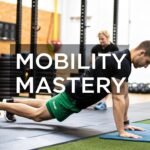
In the competitive world of athletics, peak performance isn't just about raw strength or speed; it's about the quality of movement. While traditional static stretching has its place, modern sports science emphasizes a more crucial element for unlocking your potential: mobility. True mobility is the ability to actively move a joint through its full, functional range of motion with complete control. It's the key to generating power efficiently, preventing common injuries, and recovering faster from intense training sessions.
This comprehensive guide moves beyond generic advice to explore eight essential categories of mobility exercises for athletes. We will delve into the specific science, practical application, and targeted techniques used by elite performers to maintain their edge. From dynamic warm-ups that prime the body for explosive action to advanced PNF techniques and corrective exercises that rewire faulty movement patterns, this plan is your roadmap to superior athleticism. Of course, to truly unlock your full athletic potential, it's not just about the exercises; ensuring the proper assembly of your fitness equipment is a crucial, foundational step for safe and effective training.
By integrating these strategies, you'll address the root causes of soreness, stiffness, and performance plateaus. Prepare to transform your approach to training, build a more resilient body, and unlock new levels of performance you never thought possible. This listicle will provide actionable insights into:
- Dynamic Stretching and Movement Preparation
- Myofascial Release and Foam Rolling
- PNF (Proprioceptive Neuromuscular Facilitation) Stretching
- Joint Mobilization and Articular Movements
- Active Isolated Stretching (AIS)
- Movement Flow and Mobility Sequences
- Corrective Exercise and Movement Pattern Training
- Breathing-Based Mobility and Parasympathetic Training
1. Dynamic Stretching and Movement Preparation
Forget static, held stretches before a workout. The modern approach to preparing your body for peak performance is dynamic stretching, a method focused on active, controlled movements through a full range of motion. This technique acts as a crucial bridge between rest and athletic activity, effectively "waking up" your neuromuscular system. Unlike static stretching, which can temporarily decrease power output, dynamic movements increase core temperature, lubricate joints, and improve blood flow to the muscles you're about to use. It’s one of the most fundamental mobility exercises for athletes because it prepares the body for the specific demands of a sport or training session.
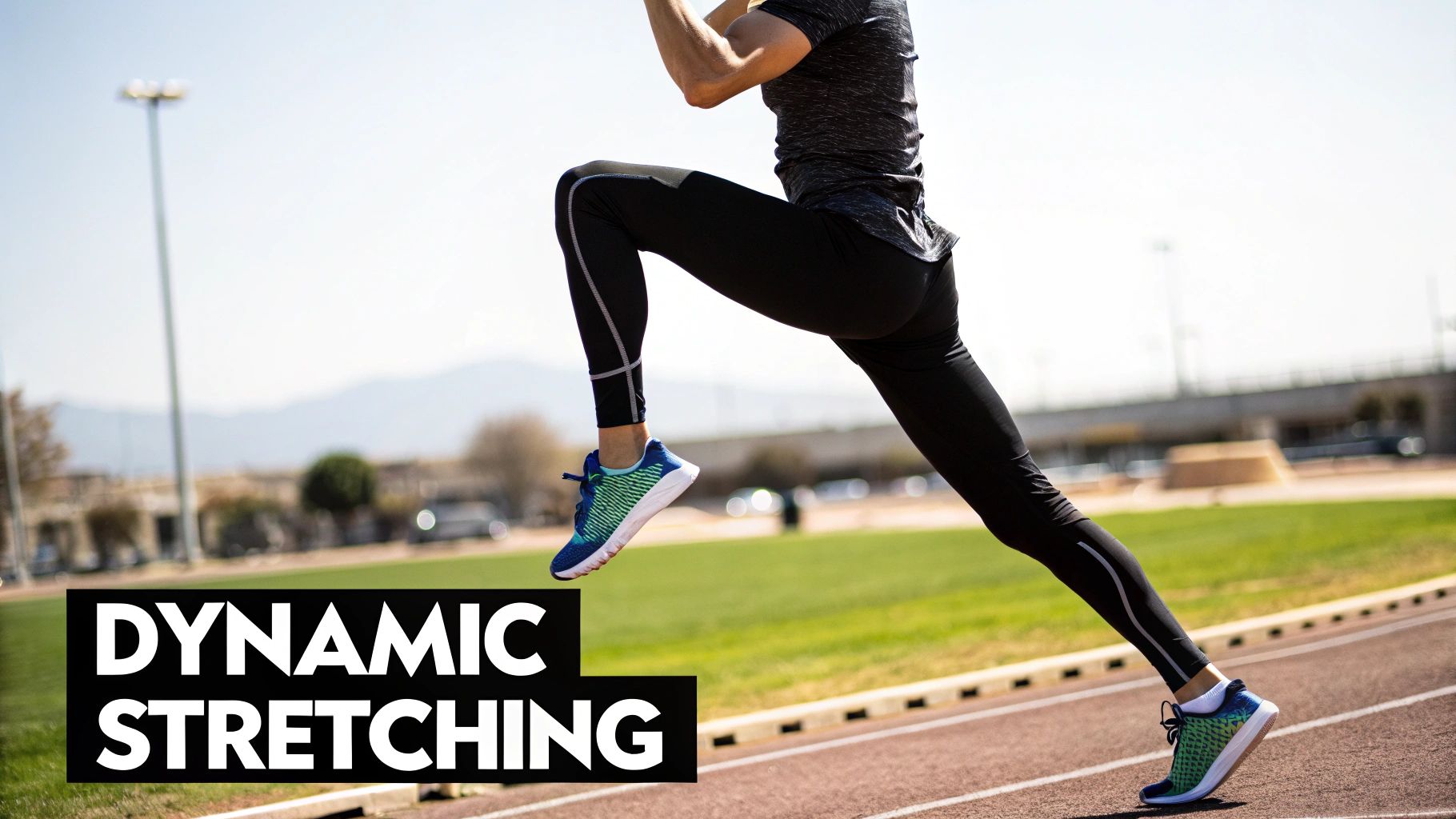
Pioneered by figures like performance coach Vern Gambetta and physical therapist Gray Cook, this approach emphasizes movement quality over simply holding a position. It’s about rehearsing the patterns you’ll use in your sport, which enhances coordination and activates the correct muscle firing sequences.
Why It's Essential for Athletes
Dynamic movement preparation is a non-negotiable for any serious athlete. It primes the body for explosive and agile actions by improving elasticity in muscles and connective tissues. This preparation reduces the risk of common injuries like muscle strains and tears that often occur when an athlete goes from zero to one hundred without a proper warm-up.
Key Insight: The goal of a pre-activity routine isn't just to get "loose." It's to enhance nervous system readiness and activate sport-specific motor patterns, turning on the right muscles at the right time.
How to Implement Dynamic Stretching
The key is to mirror the movements of your specific sport. A comprehensive warm-up should last 10-15 minutes and progress from general, simple movements to more complex, sport-specific ones.
- Soccer Players: Perform walking lunges with a torso twist to mimic kicking and changing direction. Add high knees and butt kicks to prepare for sprinting.
- Tennis Players: Use arm circles (both forward and backward) and trunk rotations to prepare the shoulders and core for powerful serves and groundstrokes.
- Track Athletes: A-skips and B-skips are classic drills to reinforce proper running mechanics and activate the hip flexors and hamstrings.
- Weightlifters: Cat-Cow stretches, hip circles, and torso twists mobilize the spine and hips before heavy lifting.
Start each movement with a smaller range of motion and gradually increase the amplitude and speed. Perform 10-15 repetitions for each exercise, focusing on controlled, fluid movements rather than jerky or ballistic actions.
2. Myofascial Release and Foam Rolling
Beyond stretching, maintaining healthy muscle tissue is critical for optimal movement. Myofascial release is a form of self-massage that targets the fascia: the web of connective tissue that encases your muscles, bones, and organs. Using tools like foam rollers, massage balls, and percussion devices, athletes can apply direct pressure to stiff, knotted areas, helping to break up adhesions, improve blood flow, and restore tissue pliability. This technique is a cornerstone among mobility exercises for athletes because it directly addresses tissue quality, which is the foundation of healthy movement.
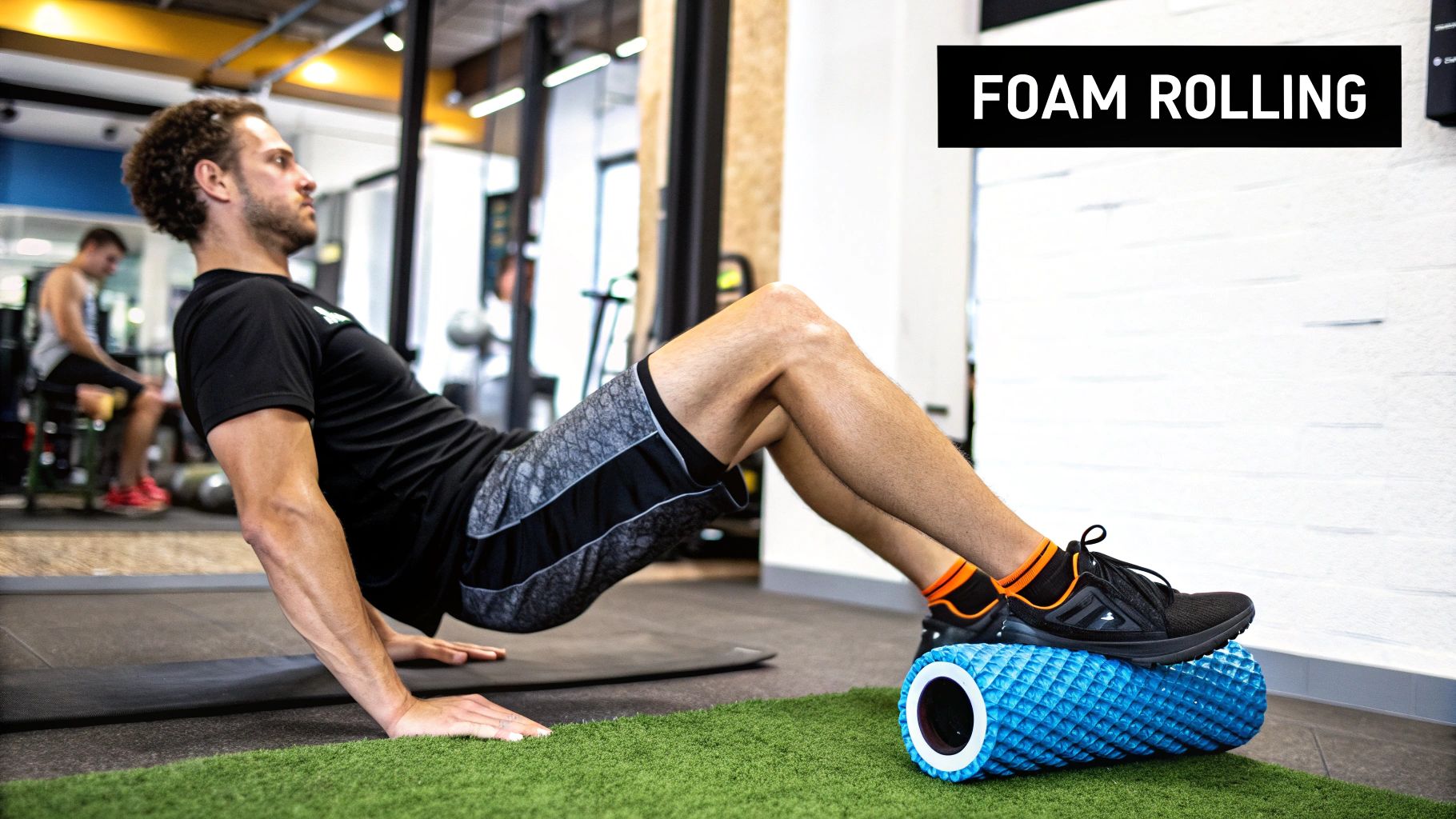
The concept was popularized by pioneers like physical therapist Kelly Starrett and strength coach Mike Boyle, who championed self-care techniques to empower athletes to manage their own tissue health. By improving the slide and glide between fascial layers, this practice can alleviate soreness, increase range of motion, and enhance overall recovery between intense training sessions. You can learn more about how a massage for muscle recovery on blog.lamoondayspa.com can complement these techniques.
Why It's Essential for Athletes
Intense training can cause micro-trauma and inflammation, leading to adhesions or "knots" in the fascia. These restrictions can limit flexibility, alter movement mechanics, and increase the risk of injury. Myofascial release helps iron out these trigger points, allowing muscles to contract and lengthen more efficiently. It's an indispensable tool for recovery, helping to reduce delayed onset muscle soreness (DOMS) and prepare the body for the next workout.
Key Insight: Myofascial release isn't about crushing your muscles. It's a targeted conversation with your nervous system, encouraging tight tissues to relax and let go, which restores proper function and reduces pain signals.
How to Implement Myofascial Release
The goal is to apply slow, sustained pressure to targeted muscle groups. This can be done before a workout to increase tissue readiness or after a workout to kickstart the recovery process.
- Marathon Runners: Use a foam roller post-race on the IT band and quadriceps to alleviate common areas of tightness from repetitive motion.
- Cyclists: A massage stick is perfect for targeting the quadriceps and calves, two muscle groups that bear a heavy load during long rides.
- NBA Players: Many players use foam rollers during breaks or halftime to keep their leg muscles loose and responsive.
- CrossFit Athletes: A lacrosse ball is excellent for targeted work on smaller, hard-to-reach areas like the bottom of the feet (plantar fascia) or the piriformis in the glutes.
When you find a tender spot, pause on it for 30-60 seconds, breathing deeply, until you feel the tension start to release. Roll slowly, about one inch per second, and avoid rolling directly over joints or bones. Staying hydrated after a session can also help flush metabolic byproducts released from the tissues.
3. PNF (Proprioceptive Neuromuscular Facilitation) Stretching
Proprioceptive Neuromuscular Facilitation (PNF) is an advanced flexibility technique that leverages the body's neuromuscular reflexes to achieve rapid gains in range of motion. It’s a powerful method that involves a specific sequence of passive stretching and muscle contractions to "trick" the nervous system into relaxing a muscle more deeply than it would with other stretching methods. This technique is one of the most effective mobility exercises for athletes looking to overcome stubborn flexibility plateaus.
Originally developed in clinical settings for rehabilitation by Dr. Herman Kabat, PNF was later refined by physical therapists Margaret Knott and Dorothy Voss. Its principles have been widely adopted in elite sports because it produces significant and often immediate improvements in mobility by targeting the Golgi tendon organ, a sensory receptor that signals the muscle to relax after a sustained contraction.
Why It's Essential for Athletes
For athletes who require extreme ranges of motion, PNF is a game-changer. It allows for a deeper stretch by overriding the protective stretch reflex that normally limits muscle lengthening. This is critical for preventing injuries associated with explosive movements that push joints to their end range, such as a high kick in martial arts or a deep lunge in gymnastics. The result is not just greater flexibility but also enhanced muscular control at the new end ranges.
Key Insight: PNF isn't just about passive flexibility. The isometric contraction phase actively engages and strengthens the muscle at its lengthened position, improving functional, usable range of motion.
How to Implement PNF Stretching
PNF is most effective when performed with a skilled partner after a thorough warm-up, though some variations can be done solo using bands or straps. The most common method is the "contract-relax" technique, which follows a simple yet precise protocol.
- Gymnasts: Use PNF with a partner to deepen splits and improve hip flexor flexibility, crucial for leaps and holds.
- Martial Artists: Employ PNF for the hamstrings and adductors to increase the height and speed of high kicks without risking muscle pulls.
- Baseball Pitchers: Can carefully use PNF on the posterior shoulder capsule to enhance external rotation, a key component of throwing velocity.
- Dancers: Enhance hamstring and hip mobility for movements like the arabesque, using a partner to guide the leg through the PNF sequence.
The "contract-relax" method involves a clear, three-step process. This infographic illustrates the fundamental workflow of a PNF stretch.
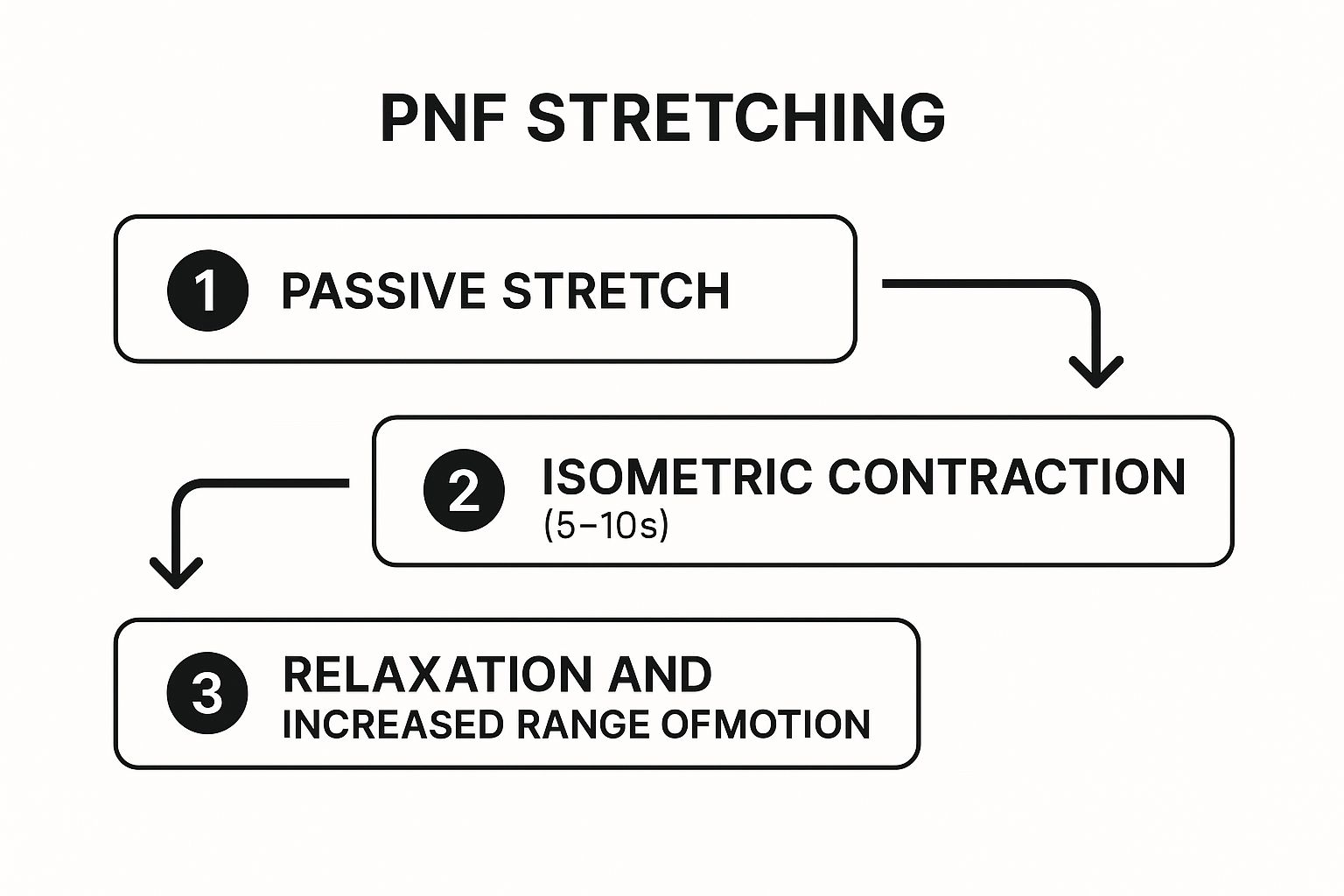
This sequence works by using an isometric contraction to trigger a post-contraction relaxation response, allowing the muscle to lengthen further during the final passive stretch. When implementing, contract the target muscle at about 50-75% of your maximum effort for 5-10 seconds, and always communicate clearly with your partner to avoid injury.
4. Joint Mobilization and Articular Movements
While muscle flexibility is critical, true mobility hinges on the health and function of the joints themselves. Joint mobilization focuses on improving the quality of movement within a specific joint through controlled, therapeutic motions. This technique directly addresses restrictions in the joint capsule, improves the circulation of synovial fluid (the joint's natural lubricant), and restores proper arthrokinematics, which is how the joint surfaces glide, roll, and spin against each other. It’s one of the more clinical mobility exercises for athletes because it targets the root of many movement limitations.
This approach was advanced by manual therapy pioneers like Freddy Kaltenborn and Geoffrey Maitland, who developed systems to grade and apply specific movements to restore joint play. More modern concepts, such as Brian Mulligan's "mobilization with movement," integrate these passive techniques with active patient movement, making them highly relevant for athletic recovery and performance.
Why It's Essential for Athletes
Repetitive stress, impact, and even periods of inactivity can cause joint capsules to stiffen and restrict normal motion. When a joint can't move properly, the body creates compensation patterns, forcing other muscles and joints to work overtime. This cascade often leads to overuse injuries, muscle imbalances, and inefficient movement. Joint mobilization directly intervenes to break this cycle, ensuring joints like the ankle, hip, and shoulder can move freely and function as designed.
Key Insight: Optimal mobility isn't just about stretching muscles. It's about restoring the fundamental, subtle "joint play" that allows for smooth, efficient, and pain-free movement through a full range of motion.
How to Implement Joint Mobilization
While many advanced techniques are performed by qualified professionals like physical therapists or chiropractors, athletes can use self-mobilization techniques with tools like bands and rollers. These methods often involve applying gentle, oscillating movements to a joint at its end range.
- Swimmers and Pitchers: Use a resistance band to perform shoulder capsule mobilizations. Anchor the band low and wrap it around the upper humerus to create a gentle downward and outward pull while moving the arm through various ranges.
- Runners and Lifters: Ankle mobility is key. Place a heavy resistance band around the front of the ankle (tibia/fibula) and anchor it behind you. Lunge forward to drive the knee over the toe, using the band to help the talus bone glide backward, a key movement for deep squats and efficient running.
- Golfers and Rotational Athletes: Thoracic spine mobility can be improved by lying with a foam roller perpendicular to your spine. Gently roll up and down your mid-back, performing small crunches or reaching your arms overhead to encourage extension in each vertebral segment.
Always start with gentle, pain-free movements and gradually increase the intensity. These techniques are most effective when paired with active range-of-motion exercises immediately afterward to "lock in" the new mobility.
5. Active Isolated Stretching (AIS)
A departure from traditional static stretching, Active Isolated Stretching (AIS) is a dynamic method that leverages your body's own reflexes to achieve greater flexibility safely. The technique involves actively contracting the muscle opposite to the one being stretched, holding the stretch for only one to two seconds, and repeating the movement for multiple repetitions. This process works with a physiological principle called reciprocal inhibition, where activating one muscle (the agonist) signals its opposing muscle (the antagonist) to relax, allowing for a deeper stretch without triggering the body's protective stretch reflex.
Developed and popularized by kinesiotherapist Aaron Mattes, this approach is lauded by flexibility experts like Jim and Phil Wharton and is used in Olympic training centers worldwide. AIS is considered one of the more advanced mobility exercises for athletes because it enhances the flow of oxygenated blood to the tissues, removes metabolic waste, and re-educates the muscles to operate in a greater range of motion.
Why It's Essential for Athletes
AIS provides a targeted approach to improving flexibility in specific muscles that are often tight and restrictive in athletes. By avoiding prolonged holds, it prevents the decrease in blood flow and localized ischemia that can occur with static stretching. This makes it an excellent tool for increasing mobility and promoting recovery without compromising muscle strength or power output before a competition.
Key Insight: The magic of AIS is its respect for the body's nervous system. Instead of fighting against the muscle's natural protective mechanisms, it coaxes the muscle into relaxing, allowing for true gains in flexibility and range of motion.
How to Implement Active Isolated Stretching
Successful AIS requires focus on breathing and precise, controlled movements. You should perform 8-12 repetitions for each stretch, holding each for only 1-2 seconds at the peak of the movement. A light assistance rope can be used to gently guide the limb a little further at the end of the range of motion, but the primary movement should come from your own muscle contraction.
- Track and Field Athletes: To target the hamstrings, lie on your back and actively lift one leg toward the ceiling using your hip flexors and quadriceps. At the top, gently use a rope to pull the leg slightly further for 1-2 seconds before returning to the start.
- Tennis Players: For improved shoulder external rotation, lie on your side with your top arm bent at 90 degrees. Actively rotate the arm backward, and then gently use your other hand to press it slightly further toward the floor.
- Martial Artists: To enhance hip flexibility for high kicks, stand and actively lift your knee towards your chest, then use your hands to gently assist the last bit of movement, focusing on isolating the hip joint.
- Cyclists: Address tight hip flexors by kneeling in a lunge position. Squeeze the glute of the back leg to actively push the hip forward into a stretch, hold briefly, and release.
Always warm up with light cardio before performing AIS. The key is to breathe out during the exertion/stretching phase and breathe in as you return to the starting position.
6. Movement Flow and Mobility Sequences
Moving beyond isolated drills, movement flow combines multiple mobility exercises into seamless, choreographed sequences. This approach addresses multiple joints and movement patterns simultaneously, creating a dynamic routine that challenges not just your range of motion but also your coordination and motor control. These flowing routines, often influenced by yoga, martial arts, and dance, create continuous movement that improves mind-body connection and full-body integration.
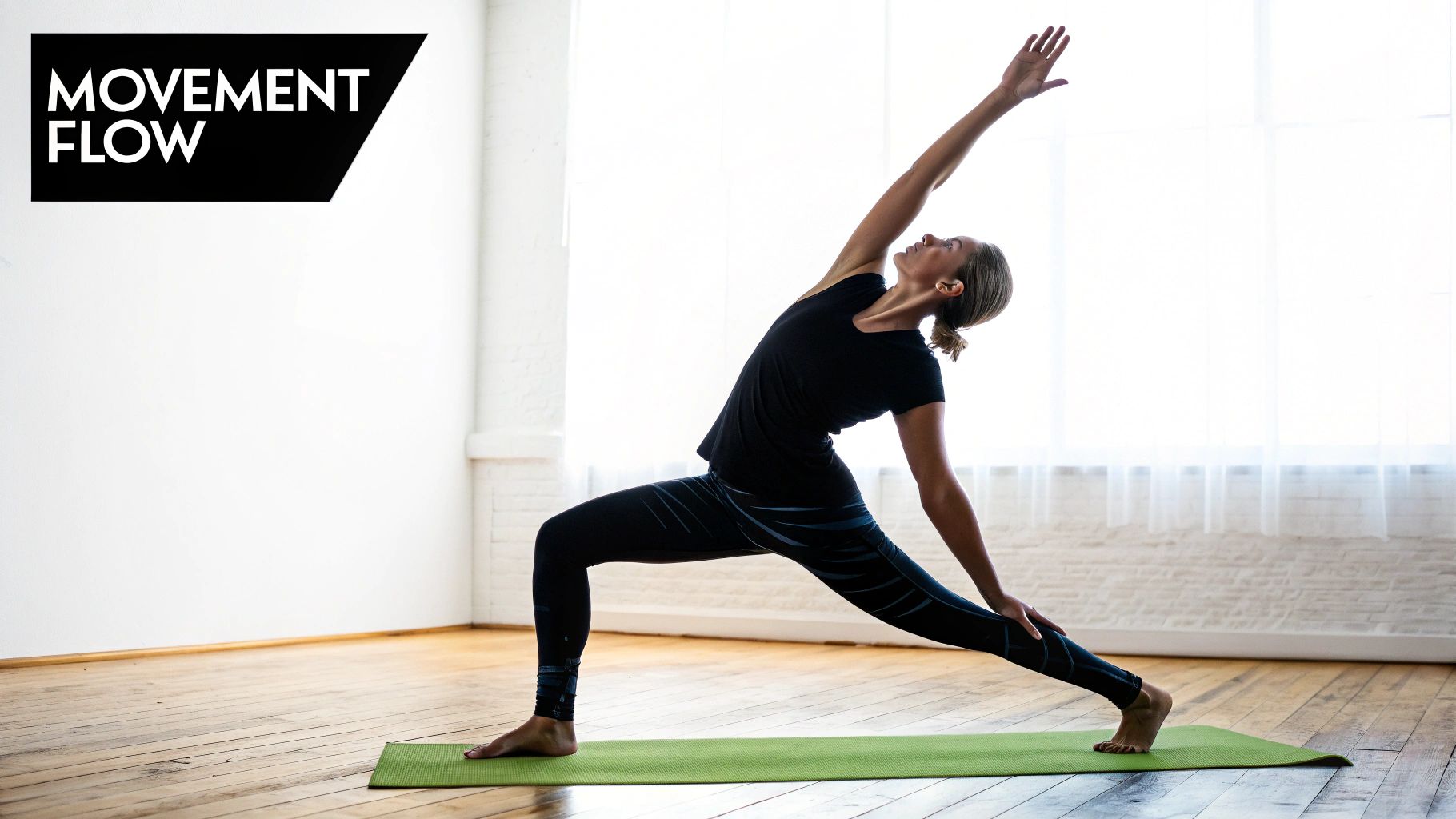
This method has been popularized by modern movement pioneers like Ido Portal, Mike Fitch (Animal Flow), and the founders of GMB Fitness and Original Strength. Their work emphasizes that athletic ability isn't just about strength or flexibility in isolation; it's about the ability to transition smoothly and efficiently between different positions and actions. This makes movement flow one of the most comprehensive mobility exercises for athletes available.
Why It's Essential for Athletes
Movement flow develops a unique quality of "movement intelligence" that isolated drills can miss. It trains the body to link different ranges of motion together, which is exactly what happens in the unpredictable environment of a sport. By moving fluidly on the ground and through different planes of motion, athletes build resilience in their joints and connective tissues, improve proprioception, and develop a more intuitive understanding of their body's capabilities.
Key Insight: Athleticism is expressed in transitions: from sprinting to jumping, from defending to attacking. Movement flow directly trains your ability to control these transitions, making your movements more graceful, efficient, and less prone to injury.
How to Implement Movement Flow
The goal is to link familiar movements into a continuous, unbroken chain. To integrate continuous movement with breathwork, dynamic practices like Vinyasa Yoga can be highly effective in building fluid mobility sequences. Begin with a simple 2-3 move sequence and gradually add more complexity as you gain confidence.
- MMA Fighters: Often use "Animal Flow" patterns like the Beast, Crab, and Ape to build ground-based strength and agility, transitioning between positions to mimic grappling scenarios.
- Basketball Players: Can combine a deep squat, a thoracic spine rotation, and a hip-opener like the 90/90 stretch into a fluid warm-up that prepares the hips and spine for multidirectional play.
- General Athleticism: A great starting point is the "Squat to Stand with T-Spine Rotation." From a standing position, hinge at the hips to grab your toes, pull yourself down into a deep squat, release one hand to rotate and reach for the ceiling, return to the squat, and repeat on the other side before standing back up.
- Martial Arts: Forms (kata) are the original movement flows, teaching athletes to link blocks, strikes, and stances in a pre-arranged sequence that builds motor control and discipline.
Focus on the quality of movement and the smoothness of the transitions rather than the speed. Breathe rhythmically and deliberately throughout the flow. These sequences are excellent for warm-ups, cool-downs, or as dedicated mobility sessions on recovery days.
7. Corrective Exercise and Movement Pattern Training
While general mobility drills are beneficial, corrective exercise takes a more targeted approach. This method focuses on identifying and fixing specific movement dysfunctions, muscle imbalances, and compensation patterns that undermine performance and increase injury risk. It moves beyond simply stretching or mobilizing and delves into retraining the body to move efficiently and correctly. It’s one of the most advanced forms of mobility exercises for athletes because it addresses the root cause of movement limitations rather than just the symptoms.
Pioneered by experts like physical therapist Gray Cook (developer of the Functional Movement Screen or FMS), spine specialist Stuart McGill, and movement scientist Shirley Sahrmann, this approach uses systematic assessment to prescribe highly specific exercises. The goal is to restore proper muscle activation sequences, enhance joint stability, and engrain optimal movement patterns, effectively rebuilding an athlete's functional foundation.
Why It's Essential for Athletes
Athletes often develop compensatory patterns to work around minor injuries, poor mechanics, or muscle imbalances. These compensations can lead to chronic pain, performance plateaus, and major injuries down the line. Corrective exercise is crucial for identifying these hidden weaknesses and asymmetries before they become a significant problem. By addressing the underlying dysfunction, athletes can unlock new levels of performance and significantly improve their long-term durability. It is a key strategy for preventing repetitive strain injuries that are common in sports.
Key Insight: Peak performance isn't just about strength and speed; it's about movement quality. Corrective exercise fine-tunes the body's "software" (neuromuscular control) to ensure the "hardware" (muscles and joints) functions optimally and safely.
How to Implement Corrective Exercise
Implementation should always start with an assessment from a qualified professional, like a physical therapist or a certified corrective exercise specialist. They can use tools like the FMS to identify your specific limitations.
- Golfers with limited T-Spine Rotation: May be prescribed exercises like quadruped thoracic rotations or half-kneeling windmills to improve their swing mechanics and reduce strain on the lower back.
- Cyclists with Anterior Pelvic Tilt: Might perform glute bridges, planks, and dead bugs to strengthen the core and glutes, correcting a posture that often leads to low back pain.
- Baseball Players with Shoulder Dyskinesia: Often receive targeted exercises to strengthen the serratus anterior and lower trapezius muscles, restoring proper scapular movement for a healthier, more powerful throw.
- Weightlifters with "Butt Wink" in Squats: May work on ankle mobility drills and hip flexor stretches to allow for deeper, safer squats without spinal flexion.
The focus must always be on perfect form and control, not on weight or repetitions. These exercises are often integrated as part of a warm-up or cool-down routine. Regular reassessment is vital to track progress and adjust the program as movement patterns improve.
8. Breathing-Based Mobility and Parasympathetic Training
Mobility is not just about physical flexibility; it's deeply connected to the state of your nervous system. Breathing-based mobility taps into this connection, combining specific breathing patterns with movements to unlock greater range of motion. This approach intentionally shifts the body into a parasympathetic "rest and digest" state, which signals muscles to relax, reduces perceived threat, and allows for deeper, safer stretches. It stands as one of the most transformative mobility exercises for athletes because it addresses the neurological root of tightness, not just the physical symptom.
Pioneered in modern athletic contexts by figures like Wim Hof and Brian MacKenzie, this technique draws from ancient practices like yoga and martial arts. The core principle is that controlled, diaphragmatic breathing can down-regulate the sympathetic "fight or flight" response that causes muscles to guard and tighten, especially after intense training or in response to pain.
Why It's Essential for Athletes
Athletes often live in a high-stress, sympathetically-driven state. This chronic tension can create mobility restrictions that are resistant to conventional stretching. Breathing-based mobility directly counteracts this by teaching the nervous system to feel safe in new ranges of motion. It enhances tissue extensibility, accelerates recovery, and improves an athlete's overall resilience to stress. Furthermore, integrating practices that specifically focus on respiratory control can significantly enhance an athlete's ability to relax muscles and improve range of motion; discover more about the power of breathwork to release stress and tension.
Key Insight: True mobility gains are often limited by the nervous system's protective instincts. By using the breath to calm this system, you can access ranges of motion that were previously neurologically "locked."
How to Implement Breathing-Based Mobility
The goal is to sync your breath with your movement, using the exhale to deepen the stretch and promote relaxation. This method is ideal for post-workout cool-downs or dedicated recovery sessions.
- Endurance Athletes: Use Pranayama techniques like a 4-second inhale and an 8-second exhale while holding a deep hip flexor stretch to release tension from running or cycling.
- Combat Sports Athletes: Practice Russian Systema breathing (inhaling through the nose, exhaling through the mouth) during joint mobility drills to stay relaxed under pressure.
- Team Sport Athletes: Incorporate box breathing (4-second inhale, 4-second hold, 4-second exhale, 4-second hold) before static stretching to calm the nervous system after a game.
- General Recovery: Adapt the Wim Hof Method by performing deep breathing cycles before a mobility session to increase pain tolerance and reduce inflammation. For those looking into more comprehensive methods, learn more about holistic pain management approaches on lamoondayspa.com.
Start by practicing diaphragmatic breathing alone, focusing on expanding your belly on the inhale. Then, integrate it into simple stretches, aiming for slow, controlled exhalations that are twice as long as your inhales. This is a practice of patience and awareness.
Mobility Exercises for Athletes: 8-Method Comparison
| Technique | Implementation Complexity 🔄 | Resource Requirements ⚡ | Expected Outcomes 📊 | Ideal Use Cases 💡 | Key Advantages ⭐ |
|---|---|---|---|---|---|
| Dynamic Stretching and Movement Preparation | Moderate – requires proper technique and progression | Minimal – bodyweight, time commitment | Immediate performance boost, injury risk reduction | Pre-activity warm-up, sport-specific readiness | Enhances neuromuscular activation and blood flow |
| Myofascial Release and Foam Rolling | Low to Moderate – needs technique knowledge | Low – foam rollers, balls, portable tools | Tissue quality improvement, reduces DOMS | Recovery, between training sessions, portable | Cost-effective, self-administered, improves circulation |
| PNF (Proprioceptive Neuromuscular Facilitation) Stretching | High – partner/equipment needed, protocol based | Moderate – partner or equipment | Significant and immediate flexibility gains | Flexibility improvement, rehab, advanced training | Most effective for flexibility, combines strength and stretch |
| Joint Mobilization and Articular Movements | High – requires advanced anatomical knowledge | Low to Moderate – professional guidance | Improved joint mobility and arthrokinematics | Rehab, joint restriction, therapeutic settings | Direct joint restriction treatment, restores movement quality |
| Active Isolated Stretching (AIS) | Moderate – requires specific technique learning | Low to Moderate – possibly ropes/straps | Progressive flexibility gains, avoids stretch reflex | Pre-competition, independent use | Combines strength and flexibility, avoids muscle guard reflex |
| Movement Flow and Mobility Sequences | Moderate to High – coordination and mobility needed | Minimal – bodyweight | Full-body mobility, coordination, cardiovascular benefits | Athletes seeking flow, mobility with cardio | Versatile, improves motor control and mind-body connection |
| Corrective Exercise and Movement Pattern Training | High – requires professional assessment | Moderate to High – equipment and guidance | Correction of movement dysfunctions, injury prevention | Addressing imbalances, rehab, long-term training | Individualized, addresses root causes, measurable progress |
| Breathing-Based Mobility and Parasympathetic Training | Moderate – learning proper breathing techniques | Minimal – no equipment | Enhanced relaxation, stretch effectiveness, recovery | Recovery, stress reduction, mindful mobility | Improves nervous system function and tissue extensibility |
Integrating Mobility into Your Regimen for Lasting Success
The journey through the eight essential pillars of athletic mobility, from dynamic warm-ups to breathing-based recovery, reveals a fundamental truth: mobility is not a single action but an integrated system. We have explored a comprehensive toolkit designed to unlock your body's full potential, and the power now lies in how you apply these principles. The days of treating mobility as an afterthought are over. For the modern athlete, it is the intelligent framework that supports every lift, every sprint, and every recovery day.
The core takeaway is that a reactive approach to mobility, waiting for pain or stiffness to appear, is a losing strategy. A proactive, structured plan is what separates good athletes from great ones. This means understanding that the mobility exercises for athletes detailed in this article are not just isolated drills but interconnected components of a larger performance puzzle.
From Knowledge to Action: Building Your Mobility Blueprint
Translating this knowledge into a tangible routine is your critical next step. Let’s move from theory to practice by outlining a strategic approach to implementation. Avoid the common pitfall of trying to do everything at once. Instead, build your routine progressively, layering techniques as you gain confidence and awareness.
Your Week 1-2 Action Plan: The Foundation
- Pre-Workout (Daily): Dedicate 10-15 minutes to Dynamic Stretching and Movement Preparation. Focus on movements that mimic your upcoming workout, like leg swings before a run or T-spine rotations before an upper body day.
- Post-Workout/Recovery (3-4 times per week): Spend 10 minutes on Myofascial Release. Use a foam roller on major muscle groups you just worked, like the quads, hamstrings, glutes, and lats. This is your non-negotiable recovery baseline.
Your Week 3-4 Action Plan: Targeted Intervention
- Introduce Specificity: Identify one or two key areas of restriction. Are your hips consistently tight? Do your shoulders feel locked up? Dedicate two sessions this week to a more targeted approach.
- Implement Advanced Techniques: For your identified problem areas, experiment with Active Isolated Stretching (AIS) or PNF Stretching. For example, use a PNF hamstring stretch with a partner or strap to address chronic tightness that foam rolling alone isn't solving.
- Incorporate Flow: On a designated rest day, try a 15-minute Movement Flow Sequence. This helps connect individual joint mobility into a more fluid, athletic pattern, improving coordination and body awareness.
Elevating Your Game: The Long-Term Vision
Once you have established a consistent foundation, the goal shifts toward optimization and longevity. This is where you begin to fine-tune your approach, turning general mobility work into a precision instrument for performance enhancement.
Think of your body as a high-performance vehicle. Regular, basic maintenance (dynamic stretching, foam rolling) keeps it running. However, to truly optimize its output, you need periodic, expert-level diagnostics and tune-ups. This is where professional guidance becomes invaluable.
Key Insight: The most elite athletes don't just work hard; they work smart. They leverage expert assessments to identify and address subtle imbalances and movement dysfunctions before they become performance-limiting injuries.
This advanced stage involves integrating Corrective Exercise and Movement Pattern Training based on a professional assessment. A coach or physical therapist can identify, for example, that your tight hips are actually a result of poor core stabilization. They can then prescribe specific corrective exercises, like bird-dog or dead bug variations, to fix the root cause. Simultaneously, integrating Breathing-Based Mobility into your cool-downs will train your nervous system to shift from a high-stress "fight-or-flight" state to a restorative "rest-and-digest" state, dramatically accelerating recovery.
Mastering these mobility exercises for athletes is a long-term commitment that pays dividends in performance, resilience, and career longevity. It's the silent work done away from the crowds that builds a truly unbreakable athletic foundation.
To complement your dedicated mobility work and accelerate recovery, consider professional bodywork. The hands-on techniques used in sports massage can release deep-seated tension and fascial restrictions that even the best mobility drills can't reach. At La Moon Massage and Facial, our licensed therapists in Houston specialize in sports recovery and deep tissue massage to help you unlock your body's full potential and stay at the top of your game. La Moon Massage and Facial
Your Guide to Effective After Massage Care
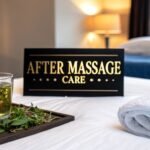
You just walked out of your massage feeling relaxed and renewed, but what you do next is just as important as the session itself. Think of your post-massage routine as the crucial second half of your treatment—it’s what helps lock in the benefits and prevents that next-day soreness.
Why Your Post-Massage Routine Matters
The work your therapist did on the table is only the beginning. The real, lasting changes happen in the hours that follow. Skipping this part is like leaving a great workout without a cool-down; you can undo a lot of the good work and find yourself stiff and sore.
The main goal here is to help your body do what it does best: heal. During a massage, especially a deep tissue session, your therapist is breaking up knots and adhesions. This process releases metabolic waste that was trapped in your muscle tissue. A good after-care routine helps your body flush all that out, so you wake up feeling refreshed, not achy.
It’s clear more people are catching on to the real health benefits of massage. The global massage therapy market is on track to hit USD 29.53 billion by 2030. This boom is driven by people like you—in fact, 61% of clients get massages for medical reasons like pain relief, and 56% do it for mental health benefits like managing stress. You can dive deeper into these numbers with this massage therapy market research.
The Pillars of Post-Massage Success
Getting the most out of your massage isn't complicated. It really just comes down to a few simple, common-sense practices that give your body the space to absorb the therapeutic work.
Here’s a quick reference table to keep the essentials top of mind.
Quick Guide to After Massage Care
| Action | Why It's Important |
|---|---|
| Hydrate | Flushes metabolic byproducts and rehydrates muscle tissue. |
| Rest | Allows your nervous system to calm down and your muscles to recover. |
| Gentle Movement | Prevents stiffness and promotes healthy blood flow. |
| Listen to Your Body | Avoids overexertion and lets your body guide its own recovery pace. |
Let's break down exactly what that looks like.
- Hydration: Water is your best friend after a massage. It’s the vehicle your body uses to transport and eliminate all the gunk that was just released from your muscles.
- Rest: Your nervous system just went through a major reset. Give it—and your muscles—a break. This isn't the time to hit the gym or tackle a big project.
- Gentle Movement: A slow walk or some light, easy stretching is perfect. It keeps blood flowing, which aids recovery, but without putting any new strain on your muscles.
By embracing these simple steps, you're no longer just passively receiving treatment. You're becoming an active partner in your own wellness, making sure that one hour on the table translates into lasting relief and health.
Hydration: Your First and Best Recovery Tool
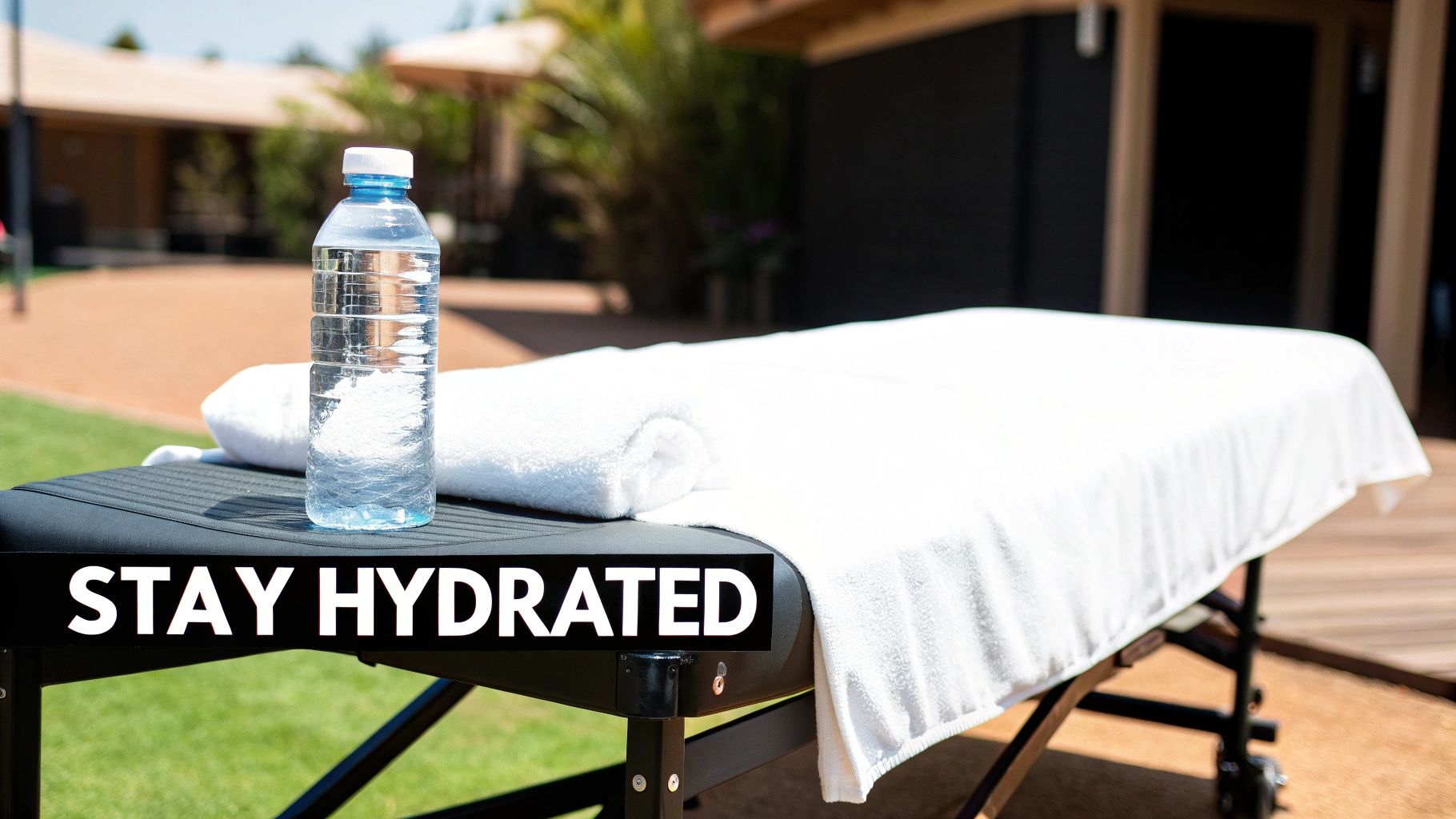
Think of water as the unsung hero of your post-massage recovery. When your therapist works on those tight muscles and stubborn knots, they're not just relaxing you—they're releasing metabolic waste that has been stuck deep in your tissues.
Your main job after the massage is to help your body get rid of those byproducts. Water is what makes this happen. Staying properly hydrated helps your lymphatic system and kidneys process and flush everything out. This simple step can make a huge difference in preventing that next-day soreness or sluggish feeling.
What to Drink (and What to Avoid)
It’s not just about drinking more; it's about drinking smarter. A few extra glasses of water is a great start, but you can get even more out of your hydration strategy.
- Go for Warmth: Instead of ice-cold water, try sipping on warm water or a soothing, caffeine-free herbal tea. Peppermint or chamomile are fantastic choices that can enhance that feeling of relaxation.
- Skip the Wrong Drinks: It's tempting to grab a coffee or a glass of wine, but this is a common mistake. Both are diuretics, which means they'll dehydrate you and work directly against your recovery, sometimes even making muscle soreness worse.
- Explore Other Healthy Options: While water is king, other beverages can support your wellness goals. For instance, drinking matcha offers hydration along with other benefits that complement your post-massage state of calm.
This growing focus on wellness is a big reason the massage industry is booming. Projections show the market expanding from USD 72.5 billion to USD 126.8 billion between 2025 and 2035. It’s a clear sign that people are investing more in their proactive health.
Key Takeaway: What you drink after your massage directly impacts how well your body recovers. Prioritizing water and avoiding dehydrating drinks is one of the easiest and most effective ways to extend the benefits of your session.
For athletes or anyone who receives more intense bodywork like deep tissue, hydration is non-negotiable for muscle repair. If you're someone who gets deeper treatments regularly, our guide on https://blog.lamoondayspa.com/sports-massage-therapy-your-recovery-game-changer/ offers more specific advice.
How to Handle Post-Massage Soreness
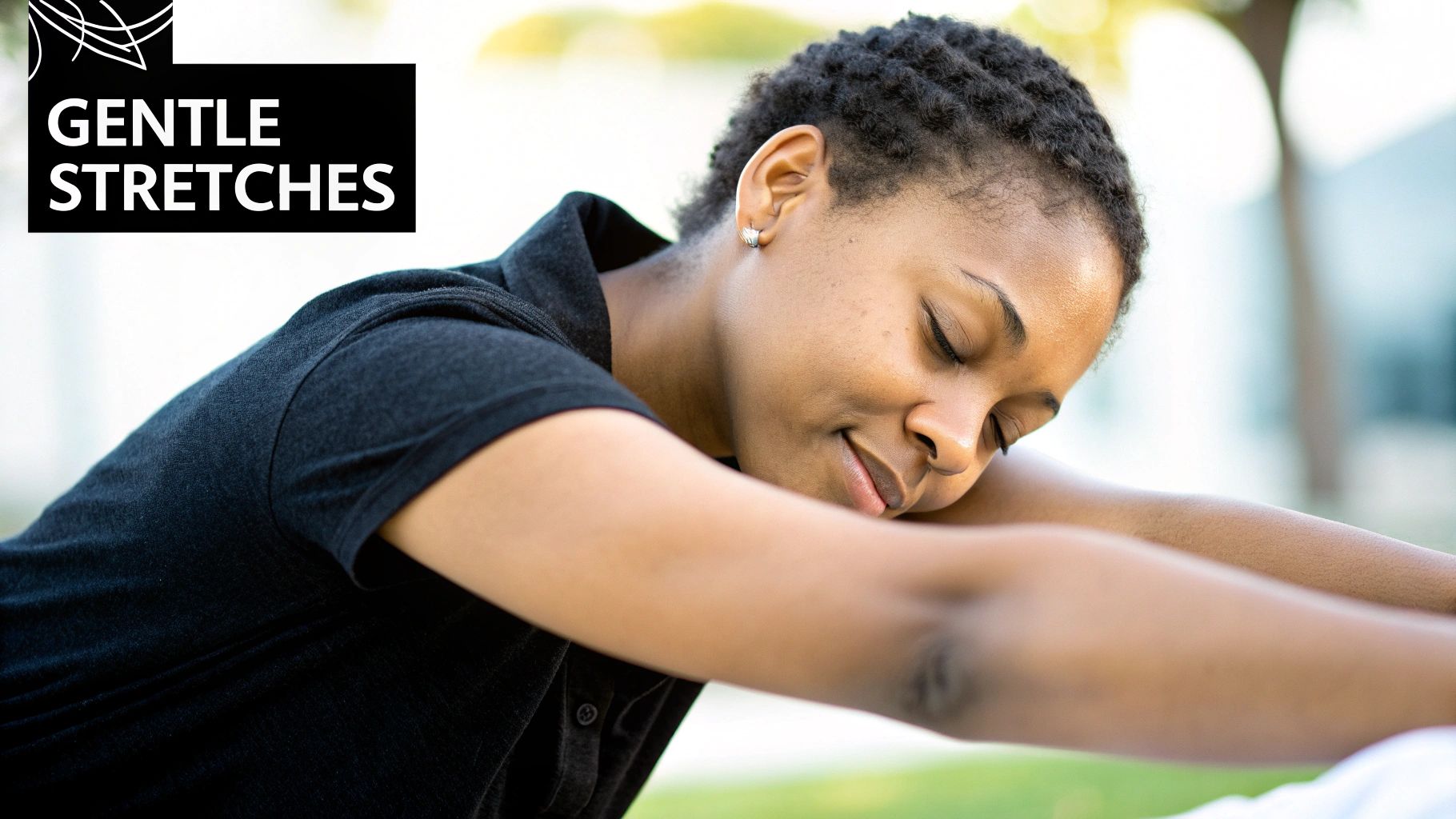
If you're feeling a bit tender after your massage, don't worry. That slight soreness is perfectly normal, especially if you had a deep tissue session. I like to tell my clients to think of it like the feeling you get after a really good workout—it’s a sign that your therapist successfully got into those deep layers of chronic tension and tight muscle fibers. It's a temporary discomfort that’s actually part of the healing process.
This is especially common with deep tissue massage, which has become incredibly popular for its powerful results. The market for this specific service was valued at a staggering USD 5.2 billion in 2024 and is projected to almost double by 2033. It's clear that more and more people are turning to it for relief from long-term pain and sports-related issues. You can actually see the full data on the growth of the deep tissue massage market for yourself.
The good news is that managing this soreness is straightforward and can even boost your recovery.
Your Soreness-Soothing Toolkit
Think of your post-massage care as having a toolkit. When you have the right tools ready, you can give your body exactly what it needs. Your two most effective tools are often heat and cold, and the secret is knowing which one to use and when.
One of the best things you can do right away is draw a warm bath. The heat gently coaxes your muscles into further relaxation and boosts circulation, helping to flush out all the metabolic waste that your massage just released from your tissues.
For an extra boost, I always recommend adding about two cups of Epsom salts to your bath. The magnesium sulfate is a natural muscle relaxant that gets absorbed through your skin, helping to soothe any leftover tightness or achiness.
When to Use Heat Versus Cold
Choosing between a warm compress and a cold pack can make a world of difference in how you feel. It's not a one-size-fits-all solution.
- Heat for General Soreness: When you're dealing with that overall, dull achiness, warmth is your best friend. A heating pad or a warm, steamy bath will encourage blood flow and relaxation.
- Cold for Acute Inflammation: If you notice a specific spot that feels particularly sharp or inflamed, that’s when you should reach for a cold pack. Apply it for about 15-20 minutes at a time to help reduce local swelling and gently numb the area, just like you would for a minor injury.
By simply listening to your body and using these remedies, you can turn any post-massage tenderness into a comfortable, easy step on your path to feeling fantastic. For a closer look at how this all fits into the bigger picture of recovery, check out our guide on using massage for muscle recovery.
Finding Your Balance: Movement and Rest After Your Massage
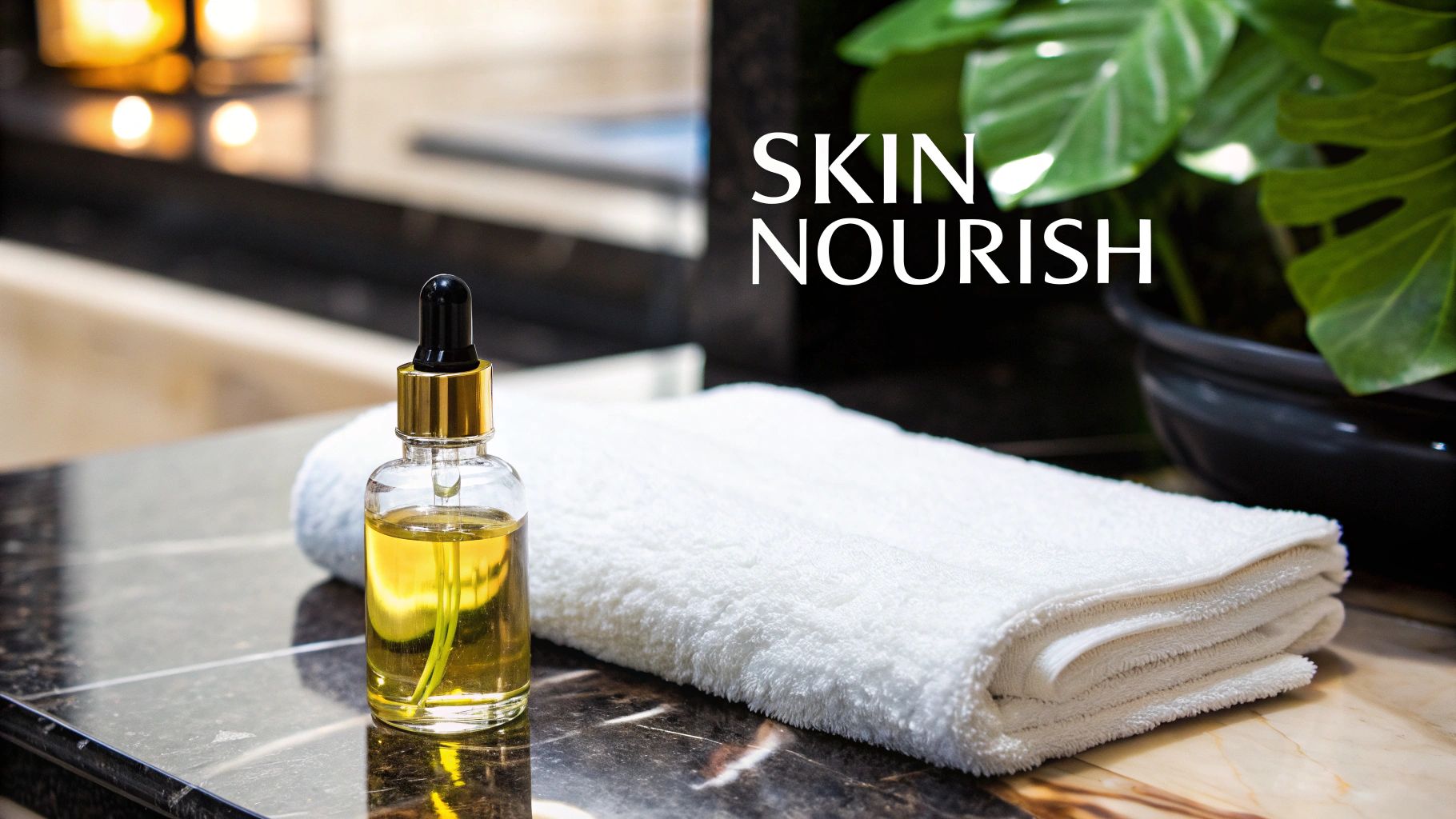
So, your massage is over, and you're floating on a cloud. The big question now is, what next? Do you curl up on the sofa for the rest of the day or head out for a walk? I’ve found that the best approach is a thoughtful mix of both. It’s all about finding that perfect harmony between gentle activity and truly restorative rest.
One of the most common mistakes people make is launching right back into a high-intensity routine. Your muscles have just been encouraged to relax and let go, leaving them more pliable and vulnerable to strain. Hitting the gym for a heavy lifting session or going for a hard run can quickly reverse all the wonderful therapeutic work you just invested in.
Instead, think of movement as a gentle encore to your massage. Light activity is fantastic for encouraging circulation, which is exactly what your muscles need. It helps bring fresh, oxygenated blood to the tissues and aids in clearing out any lingering metabolic byproducts, which is key to preventing that post-massage stiffness.
Smart Movement and Strategic Stillness
The secret is to choose activities that feel supportive, not strenuous. Pushing yourself through a grueling workout is completely counterproductive. On the flip side, being a complete couch potato for the rest of the day isn't ideal either.
A good post-massage movement plan could be as simple as this:
- A Slow, Mindful Walk: A 15-20 minute stroll around the block is perfect. Pay attention to your breathing and just notice how your body feels with each step.
- Gentle Stretching: Think easy, flowing movements. The goal here is to maintain the new mobility you've gained, not to push for new flexibility records. Hold stretches softly without any strain.
"Resting post-massage limits external stimuli that may reintroduce stress or tension."
This is a crucial point. Your nervous system has just received a major reset. Giving it a break from the usual noise and demands of life allows it to fully absorb the benefits of the massage.
Embracing stillness is just as important as gentle movement. Consider this your official permission slip to take it easy! A 20-minute nap, some quiet time with a good book, or even just sitting peacefully without any screens can make a huge difference. This downtime is where the real magic happens, helping your body repair and your mind clear, solidifying the profound effects of your session.
5 Ways To Make Your Massage Benefits Last Longer
Getting a massage feels incredible, but the real magic happens when you can make that feeling stick around. The goal isn't just temporary relief; it's about weaving that sense of ease into your everyday life. This is where your long-term after massage care comes in. Think of it as protecting your investment and keeping that chronic tension from creeping back in.
For instance, so many of us are stuck at a desk all day, which is a notorious cause of neck and shoulder pain. By simply becoming more aware of your posture—shoulders back, monitor at eye level—you're actively working against the very knots your therapist just spent an hour releasing. It's this kind of proactive thinking that makes every massage more effective than the last.
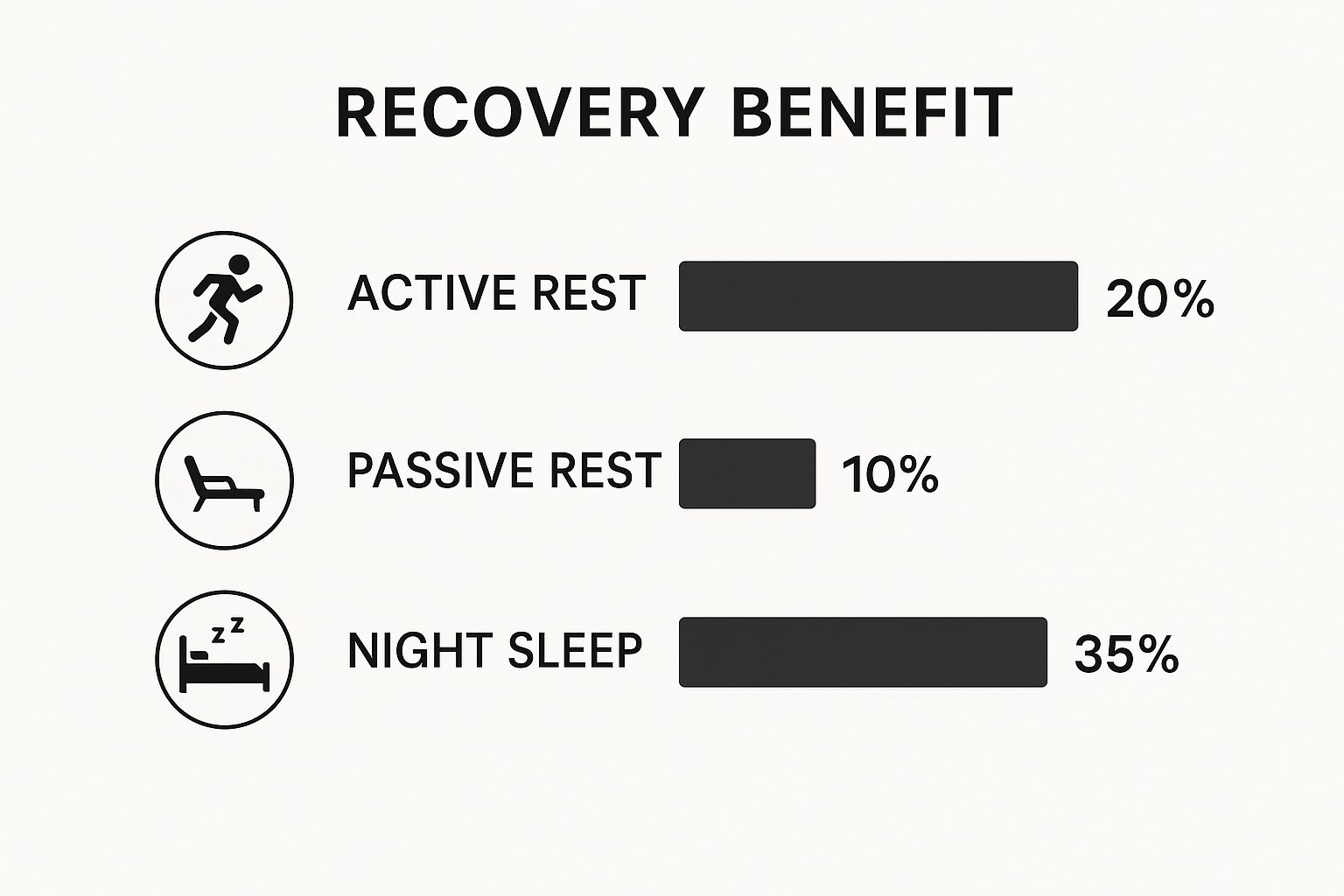
Weave Wellness Into Your Daily Routine
You don't need a massive lifestyle overhaul to hold onto those post-massage benefits. It's the small, consistent actions that really count. Just a few smart tweaks can make a world of difference in how you feel between sessions.
Here are a few ideas to get you started:
- Take a Five-Minute Stretch Break: Whether you do it first thing in the morning or as a midday reset, a few gentle stretches for your neck, shoulders, and lower back can do wonders for keeping stiffness at bay.
- Eat to Reduce Inflammation: Simple dietary choices matter. Foods rich in omega-3s (like salmon and walnuts) and vibrant, colorful vegetables can help calm systemic inflammation, which supports your body's recovery on a deeper level.
- Use Heat to Enhance Relaxation: A warm bath or a heating pad on a sore spot is always a good idea. For a truly immersive experience, you could even explore a comprehensive wood-fired hot tub wellness guide to take that relaxation to the next level.
The little things you do every day can either support or sabotage the work done on the massage table. It's helpful to see what habits are working for you and which ones might be working against you.
Habits That Help vs. Habits That Hinder Your Massage Results
| Helpful Habits (Prolong Benefits) | Hindering Habits (Counteract Benefits) |
|---|---|
| Mindful Movement: Gentle stretching or walking. | Overtraining: Hitting the gym too hard right after. |
| Hydration: Drinking plenty of water all day. | Dehydration: Too much caffeine or alcohol. |
| Ergonomic Workspace: Chair, desk, and monitor set up properly. | Poor Posture: Slouching over a phone or laptop. |
| Stress Management: Deep breathing, meditation, or hobbies. | Chronic Stress: Letting tension build up without release. |
By focusing on the "Helpful Habits" column, you move from just receiving a massage to actively participating in your own wellness journey.
This shift in mindset is what leads to profound, long-term change. You’re teaching your body how to maintain that relaxed, aligned state on its own. Every session then becomes a building block, not just a reset button.
For a deeper dive, check out our complete guide on post-massage care for more actionable tips to keep you feeling fantastic.
Common Questions About Post-Massage Care
It's completely normal to have questions after a great massage. Knowing what to expect and how to handle your body's response is key to maximizing the benefits. Let's walk through some of the most common things people ask me after they get off the table.
How Long Should I Wait to Exercise After a Massage?
I always tell my clients to give their bodies a full 24-hour break before hitting the gym or going for a hard run. Think of it this way: your muscles have just been expertly loosened and lengthened. They're in a relaxed state, which makes them more vulnerable to pulls or strains if you push them too hard, too fast.
Instead of your usual workout, consider a gentle walk or some light, restorative stretching. This keeps your blood flowing without undoing all the therapeutic work we just did. After that 24-hour window, you can ease back into your normal fitness routine. Just be sure to listen to your body.
Is It Normal to Feel Emotional or Tired?
Absolutely. This is a very common and natural reaction. A massage does more than just work on your muscles—it has a profound effect on your nervous system. We're actively shifting your body out of a high-alert "fight-or-flight" mode and into a calm "rest-and-digest" state.
This transition can sometimes bring stored emotions to the surface right along with the physical tension. It’s actually a good sign that your body is releasing things on a much deeper level. Feeling tired is also just your body’s way of saying, "Thank you, now let's rest and soak this in."
What if I'm Still Sore After 48 Hours?
A little bit of muscle tenderness for a day or two is standard, especially if you had a deep tissue massage. It’s similar to the feeling you get after a good workout. However, if you're experiencing significant soreness that lingers beyond 48 hours, that's your cue to give your therapist a call.
Pain that sticks around could mean a specific area was a bit overstimulated, or it might point to an underlying issue that we can address differently next time. Open communication is everything—it helps us fine-tune your treatment for the best possible results in the future.
Can I Get a Massage if I Am Feeling Sick?
My advice is always to reschedule if you're feeling under the weather. A massage boosts your circulation, which sounds great, but when you're sick, it can actually circulate the infection through your system more quickly and make you feel much worse.
Plus, coming in sick puts your therapist at risk of catching whatever you have. It's much better to let your body focus all its energy on fighting off the illness. We'll be ready for you when you're feeling healthy again!
Ready to make massage a regular part of your wellness routine? The expert therapists at La Moon Massage and Facial in Houston are here to help you achieve lasting relief and relaxation. Book your next session with us today
Hot Stone Massage vs Swedish Massage: Which Is Best for You?
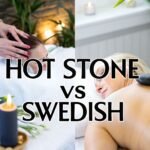
Trying to choose between a hot stone and a Swedish massage? It’s a common question, and the answer really boils down to what you want to get out of your session.
Think of it this way: Swedish massage is your go-to classic for full-body relaxation. It relies on a therapist's skilled hands to improve circulation and melt away general stress. On the other hand, hot stone massage brings in the element of heat, using warmed stones to sink deeper into the muscle tissue and release that really stubborn, deep-seated tension.
Hot Stone vs. Swedish Massage: A Quick Comparison
Booking a massage is an investment in your well-being, so you want to make sure the treatment matches your goals. Knowing the fundamental differences between these two popular styles is key to getting the most benefit, whether you're after gentle relief from a stressful week or need something more focused to work out the kinks.
Ultimately, the right choice depends on your personal needs and how the massage fits into a comprehensive self-care routine. One is all about broad, soothing strokes, while the other uses targeted thermal energy to get right to the source of muscle tightness.
Key Differences at a Glance
Let's break down the main distinctions in technique, the feel of the pressure, and what each massage is best suited for. This should help clarify which one is calling your name.
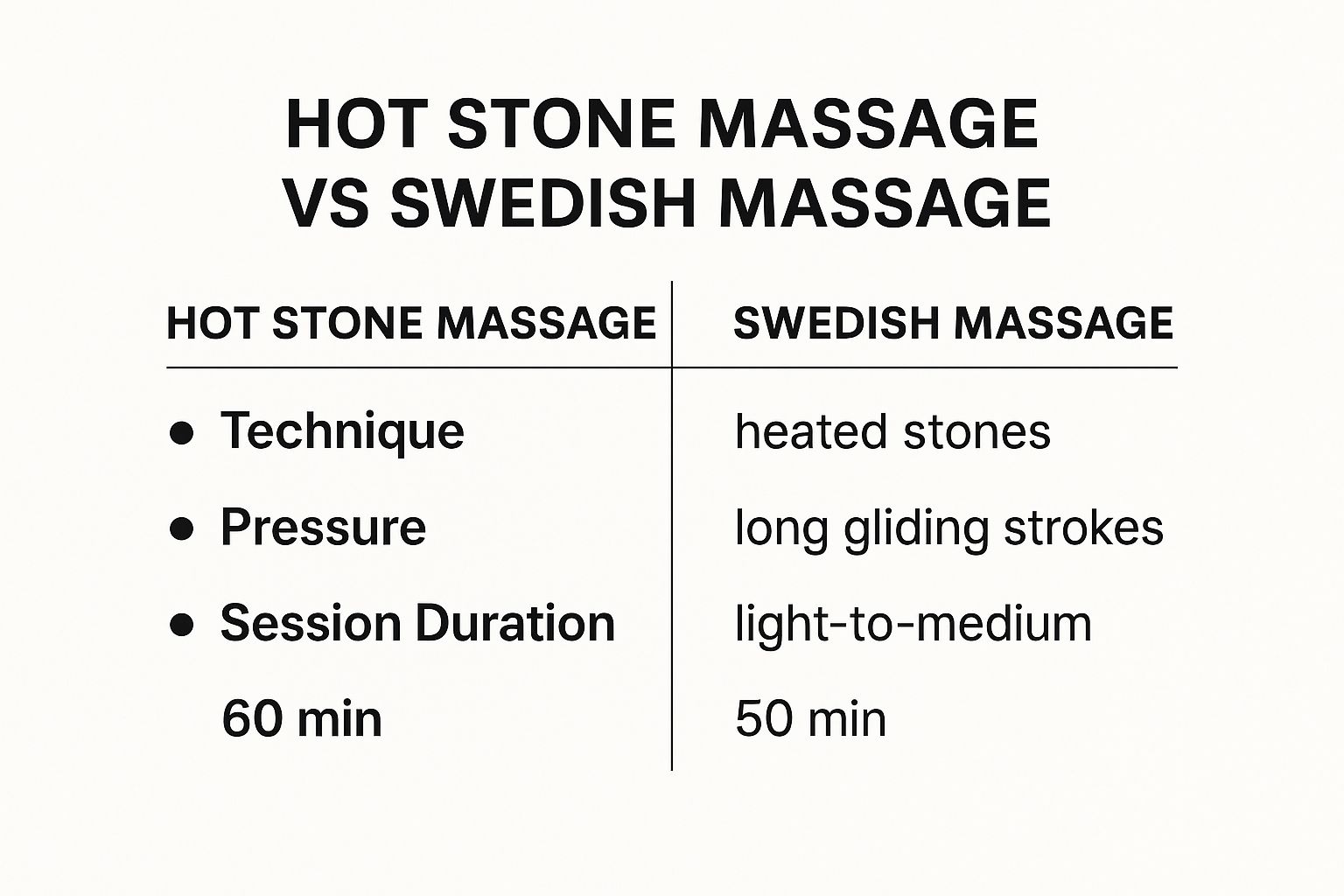
The image above gives you a great visual, showing that while both massages are deeply relaxing, a hot stone session often feels more intense due to the penetrating heat and may require a bit more time to perform thoroughly.
To make it even simpler, here’s a table that lays everything out side-by-side.
Hot Stone vs Swedish Massage At a Glance
This table offers a direct comparison of the core characteristics of hot stone and Swedish massage, helping you quickly identify the best fit for your needs.
| Feature | Swedish Massage | Hot Stone Massage |
|---|---|---|
| Primary Goal | General relaxation, stress reduction, and improved circulation. | Deep muscle relaxation, easing significant tension, and pain relief. |
| Core Technique | Long, gliding strokes (effleurage), kneading, friction, and tapping. | Heated, smooth stones placed on the body and used as massage tools. |
| Sensation | Soothing and rhythmic pressure from the therapist's hands. | Penetrating warmth combined with the weight and pressure of the stones. |
| Ideal For | First-timers, stress management, and overall full-body wellness. | Chronic pain, muscle stiffness, and anyone who loves heat therapy. |
Both of these styles are cornerstones of bodywork. You can explore more about the overarching goals of treatment by learning about https://blog.lamoondayspa.com/what-is-therapeutic-massage/ in our detailed guide. The real question to ask yourself is: do you need the gentle, restorative flow of a Swedish session, or are your muscles crying out for the deep, focused heat of hot stones?
Understanding the Classic Swedish Massage
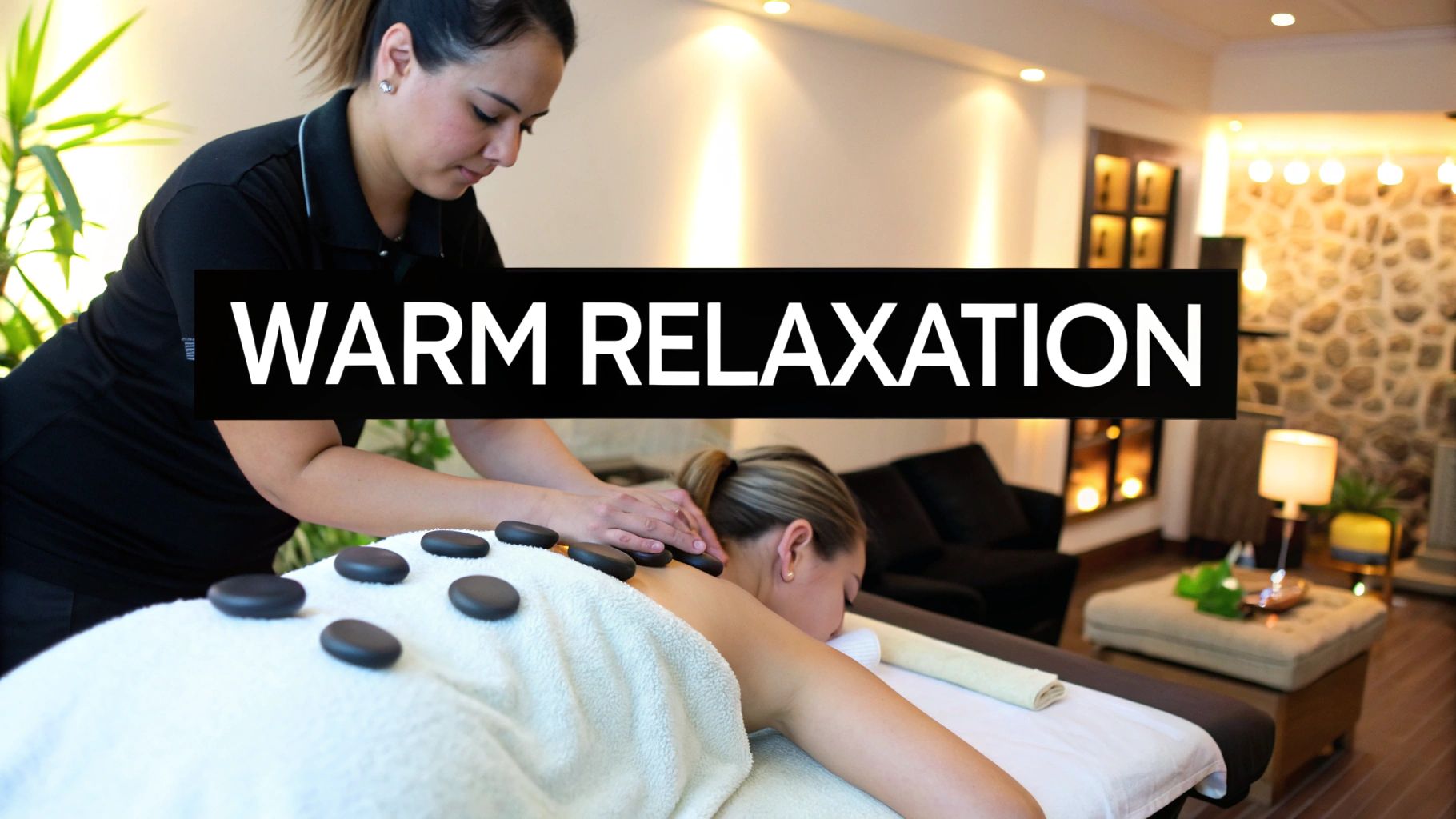
When you imagine a classic, full-body massage, you’re almost certainly picturing a Swedish massage. It’s the cornerstone of most Western massage therapies, having been developed back in the early 19th century. For many, it's the go-to choice for a first massage experience or for simply melting away everyday stress.
The entire session is built around a system of five core strokes. A skilled therapist weaves these movements together, creating a rhythmic and flowing session that treats the body as an interconnected whole. This is a key difference from a hot stone massage, which uses thermal energy to coax muscles into relaxing. Swedish massage, on the other hand, relies purely on the therapist's hands-on expertise to manipulate soft tissue.
The Five Foundational Strokes
To really get what makes Swedish massage so effective for general relaxation, you need to understand its building blocks. This also helps clarify its unique place in the hot stone massage vs Swedish massage comparison. Each stroke has a distinct job to do.
- Effleurage: Think of these as the long, smooth, gliding strokes that ease you into and out of the massage. With light to moderate pressure, effleurage warms up the muscle tissue, gets the blood moving, and calms the nervous system, setting the stage for deeper work.
- Petrissage: This is where the kneading, rolling, and lifting comes in. Petrissage targets those stubborn knots and tight spots, helping to flush out toxins and make muscles more pliable. It’s that satisfying feeling of a muscle being gently squeezed and released.
- Tapotement: A series of rhythmic, percussive taps using the edge of the hand, cupped hands, or fingertips. Don't let the name fool you—it’s surprisingly invigorating! These quick, stimulating movements are fantastic for waking up tired muscles and energizing the body.
- Friction: This involves deep, circular movements that create heat and work to break down adhesions, which we all know as "knots." This stroke is designed to get into the deeper layers of muscle where tension often gets stuck.
- Vibration: Using their hands or fingertips, the therapist applies a rapid shaking or trembling movement over a specific muscle group. Vibration is incredible for loosening up tight muscles and has a profoundly soothing effect on the nerves.
A key differentiator of Swedish massage is its focus on improving venous return—the flow of blood back to the heart. The sequence and direction of the strokes are intentionally designed to mirror the body's circulatory system, enhancing oxygen delivery to the muscles and promoting systemic relaxation.
By masterfully combining these five strokes, a therapist delivers a session that is both deeply relaxing and genuinely restorative. The gentle effleurage strokes quiet the mind, while petrissage and friction work out the physical kinks. This structured, hands-on approach is what makes it so effective for reducing muscle soreness, lowering stress hormones like cortisol, and leaving you feeling refreshed and centered. It's the gold standard for traditional therapeutic touch, defined by rhythm and flow rather than the penetrating heat of stones.
Exploring the Power of Hot Stone Therapy
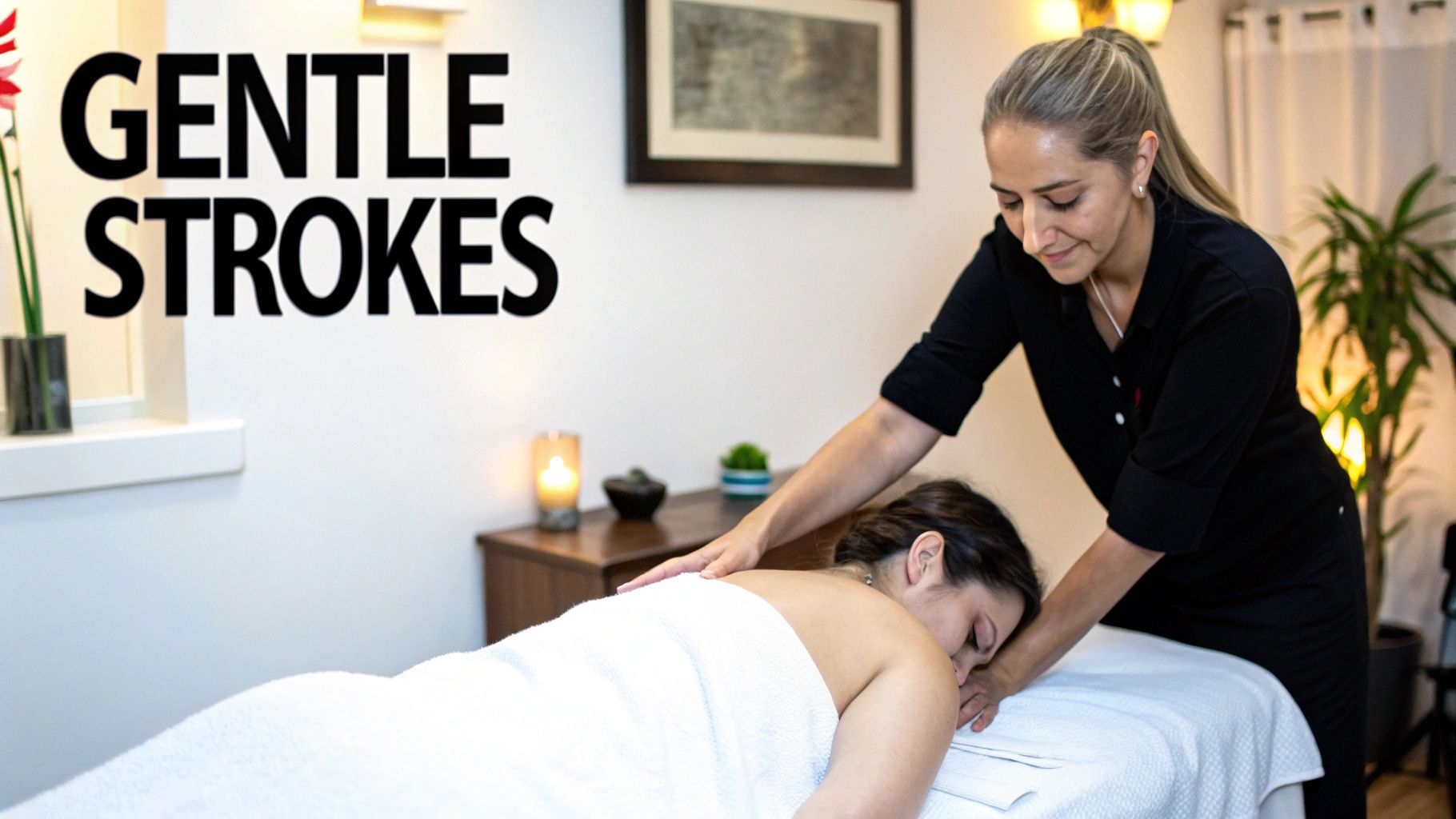
While a Swedish massage is built entirely on the therapist’s hands, a hot stone massage brings a powerful thermal element into the mix. This isn't just about placing warm rocks on your back for comfort; it’s a strategic therapy designed for deep, targeted muscle release.
The tools of the trade are smooth, heated basalt stones. This specific type of volcanic rock is fantastic at holding onto heat. During a session, these stones play two key roles. Some are placed on specific energy points—like along the spine or in the palms—to deliver a steady, penetrating warmth. Others become an extension of the therapist's hands, used to glide over your muscles and work out knots with the added benefit of heat.
The Science of Deep Heat
The real magic of hot stone therapy is how it softens muscle tissue before the hands-on work even begins. The warmth from the stones pulls more blood to the area, flooding it with oxygen and encouraging the healing process to kick in. This pre-warming means your therapist can get to the deeper layers of muscle tissue with much less pressure.
For anyone dealing with chronic knots or stubborn stiffness, this is a huge advantage. It allows the therapist to break down that deep-seated tension more effectively, and often with less discomfort than you might expect from a traditional deep tissue massage. The heat does the initial heavy lifting, making the muscles pliable and ready for detailed work.
A key takeaway in the hot stone massage vs Swedish massage debate is the dual benefit of hot stones: they provide profound mental relaxation from the soothing warmth while simultaneously delivering a more intense, targeted physical release for stubborn muscle pain.
It’s this powerful combination of heat and pressure that truly sets it apart. While both Swedish and hot stone massage will help you relax, hot stone therapy offers a more potent solution for those struggling with long-term muscle problems.
Historical Context and Modern Application
Swedish massage has roots stretching back to the 19th century, but hot stone massage is a more modern therapy that really took off in the 1990s. It builds on classic massage principles but integrates heated tools to amplify the results. This evolution was born from a need for deeper heat penetration to manage chronic muscle pain more effectively.
In fact, a UK survey found that 67% of participants felt hot stone massage was more effective than Swedish techniques for achieving long-term pain relief. That’s a powerful testament to its unique approach. You can dive deeper into how these therapies stack up by exploring the differences between hot stone and Swedish massage.
A Head-to-Head Look at the Therapeutic Benefits
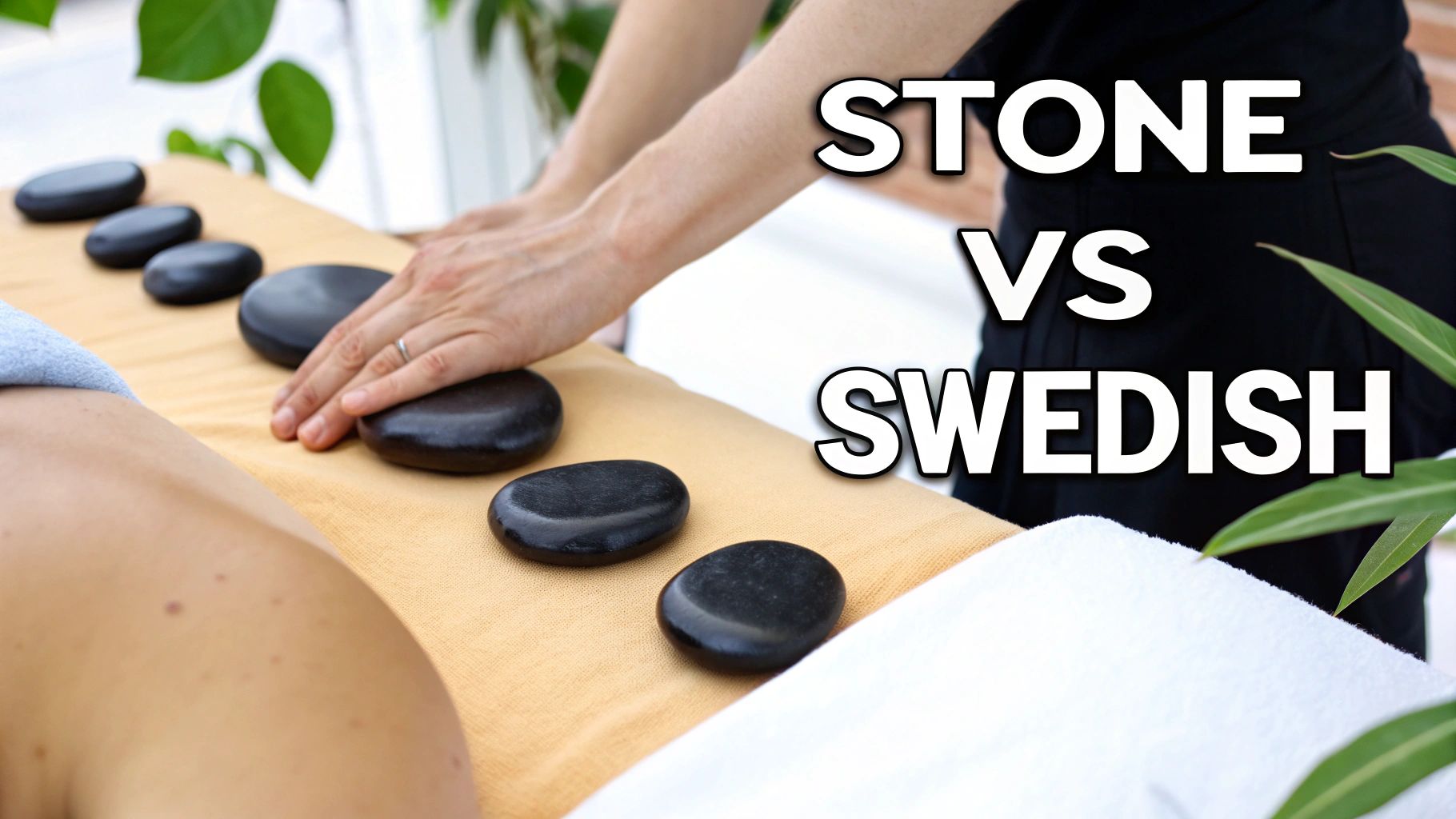
When you get down to it, the real difference between a hot stone massage and a Swedish massage isn't just about the tools—it's about the therapeutic results. Both can leave you feeling worlds better, but they get you there through very different means. To pick the right one, you have to match your personal wellness goals to what each massage truly excels at.
A Swedish massage is like a reset button for your central nervous system. Its magic lies in the rhythmic, flowing strokes that are designed to soothe and calm. The primary win here is a serious dent in your psychological stress. By encouraging your body to lower cortisol levels, that predictable, gentle pressure ushers in a profound sense of tranquility. It's my go-to recommendation for anyone feeling the effects of mental burnout or general anxiety.
A hot stone massage, on the other hand, brings in a powerful ally: heat. That thermal energy allows the therapist to achieve a much deeper physical release. The warmth from the stones sinks into muscle tissue far more effectively than hands alone, making it a superstar for tackling those stubborn, deep-seated knots and persistent stiffness that just won't seem to go away.
Stress Relief and Mental Relaxation
While both massages are fantastic for relaxation, they don't quite scratch the same itch. Think of a Swedish massage as a "mental vacation." Its entire focus on long, gliding strokes and gentle kneading is geared toward releasing stress trapped in the body, promoting a state of pure, unadulterated calm.
Hot stone massage delivers its relaxation through a completely different channel. The penetrating warmth is incredibly comforting, creating a cocoon-like effect that feels deeply grounding. For people who have a hard time "switching off" their brain, the focused sensation of the hot stones can be a powerful anchor, pulling their attention away from racing thoughts.
Key takeaway: If you’re looking for pure, nervous-system-soothing relaxation, Swedish massage usually wins. But for a feeling of deep, grounded comfort that melts away muscle tension at the same time, hot stone is the way to go.
Chronic Pain and Muscle Tension
This is where the two therapies really part ways. If you're struggling with persistent pain, especially from conditions like fibromyalgia or arthritis (always with a doctor's okay!), hot stone massage often has a distinct advantage. The targeted heat cranks up blood flow to sore spots, which helps dial down inflammation and ease discomfort more effectively.
A Swedish massage is certainly beneficial for the general muscle soreness and tension we all get from life. It’s great. However, it might not have the firepower to break down the dense adhesions and trigger points that are the root cause of chronic pain. A therapist can always apply more pressure, but without that preparatory heat, it can be less comfortable and, frankly, less effective for those deeply embedded issues.
| Benefit | Swedish Massage | Hot Stone Massage |
|---|---|---|
| Stress Relief | Top-tier for calming the nervous system and easing mental chatter. | Excellent for deep, comforting warmth and physical grounding. |
| Chronic Pain | Good for general soreness and milder, widespread pain. | Superior for targeted relief of deep knots and chronic conditions. |
| Flexibility | Improves flexibility by lengthening and relaxing surface muscles. | Enhances flexibility by warming connective tissues for a deeper stretch. |
| Sports Recovery | Ideal for flushing lactic acid and reducing post-workout soreness. | Better for addressing specific, deep muscle injuries or chronic tightness. |
Flexibility and Athletic Recovery
For athletes or really anyone looking to improve their range of motion, both massages bring something valuable to the table. A Swedish massage is fantastic for lengthening tight muscles and boosting circulation—both of which are critical for recovery and staying limber.
But a hot stone massage can take that a step further. By warming up the fascia and connective tissues, it makes the muscles much more pliable. This allows the therapist to work deeper and achieve a more lasting release of the tension that might be holding back your movement.
When it comes to athletic recovery, your choice really depends on the mission. Need a general recovery session to reduce soreness after a brutal workout? A Swedish massage is perfect. But if you’re dealing with a more specific problem, like a nagging tight hamstring or an old shoulder impingement, the focused heat of a hot stone massage can provide much more direct relief.
Athletes might also want to explore our guide comparing sports massage vs regular massage to find the absolute best fit for their training demands.
Hot Stone or Swedish? Making the Right Call
Deciding between a hot stone massage and a Swedish massage really boils down to what your body and mind are asking for at that moment. It's not about which one is "better" overall, but which one is right for you, right now.
Think of it this way: are you looking for a targeted strike against a stubborn knot, or do you need a full-body reset to quiet the noise? One provides deep, focused heat, while the other offers a sweeping sense of calm. Your body knows the answer; you just have to listen.
Choose Hot Stone for Deep, Stubborn Tension
If you carry your stress in specific spots—like those rock-hard knots in your shoulders from sitting at a desk all day—a hot stone massage is probably your best bet. This is where it truly shines. The penetrating warmth from the smooth basalt stones sinks deep into the muscle, loosening things up from the inside out. This allows your therapist to work more deeply and effectively without having to apply intense, sometimes uncomfortable, pressure.
Hot stone therapy is a fantastic choice for:
- Chronic Muscle Stiffness: Perfect for that lower back that always aches or those neck and shoulder muscles that feel permanently clenched.
- Pinpointed Pain Relief: When you can put a finger on a specific spot and say, "The problem is right here."
- Soothing Anxiety: The weight and warmth of the stones have a grounding effect that can be incredibly calming for a busy mind.
Go with Swedish for General Relaxation and Stress Relief
Feeling overwhelmed, a bit sensitive to touch, or just trying massage for the first time? The classic Swedish massage is your go-to. It’s the foundational massage for a reason. Its long, gliding strokes and gentle kneading are designed to soothe your entire nervous system and boost circulation from head to toe.
For anyone new to massage or simply seeking a mental escape, a Swedish massage is the gold standard. It’s less about attacking specific knots and more about melting away overall stress, leaving you with a sense of profound tranquility.
This style is ideal when you need:
- A Gentle Introduction: It’s the perfect first massage, helping you get comfortable with the process and pressure.
- Total Stress Decompression: The best choice for unwinding after a mentally draining week or project.
- Improved Circulation: The rhythmic, sweeping strokes are fantastic for getting your blood flowing and feeling refreshed.
Important Health Considerations Before You Book
While hot stone massage is wonderfully therapeutic, the addition of heat means it isn't for everyone. It’s absolutely essential to consider your health history, as applying direct heat can be risky for certain conditions.
You should avoid hot stone massage or speak with your doctor beforehand if you have any of the following:
- High Blood Pressure: The heat widens blood vessels, which can impact your blood pressure.
- Diabetes: Nerve damage (neuropathy) is a common complication that can impair your ability to feel heat, putting you at risk for burns.
- Pregnancy: While specialized prenatal massage is highly recommended, most therapists avoid applying direct, concentrated heat from stones.
- Varicose Veins: Heat can increase inflammation and discomfort in areas with varicose veins.
In any of these cases, a Swedish massage is almost always the safer, more comfortable option. The most important thing you can do is have an open conversation with your massage therapist. Being transparent about your health ensures they can tailor the session perfectly to you, so you can walk away feeling better, not worse.
What to Expect During Your Session
Walking into a massage room for the first time can feel a little mysterious, but knowing what’s ahead makes all the difference. No matter if you've chosen a hot stone or Swedish massage, your appointment will always start with a quick, confidential chat with your therapist. This is your chance to talk about your goals, point out any sore spots, and mention any health conditions.
Once you’ve talked it over, your therapist will step out, giving you privacy to undress to your comfort level and get settled on the table under a sheet. Professional draping is standard practice, meaning only the part of your body being worked on will be uncovered. Your comfort is the top priority, so don't be shy about speaking up if you need the pressure adjusted, the music changed, or the room temperature tweaked.
The Swedish Massage Experience
For a classic Swedish massage, the therapist will apply oil or lotion to your skin. This allows their hands to move in long, smooth, gliding strokes—a technique called effleurage that warms up your muscles.
You'll then feel a sequence of more targeted techniques, like the kneading and squeezing of petrissage, designed to work out knots and tension. The entire experience is defined by the therapist's skilled, hands-on approach, creating a rhythmic and incredibly relaxing flow.
The Hot Stone Massage Experience
A hot stone massage brings heat into the equation. Your therapist will use smooth, heated basalt stones in two ways: placing them on specific points of your body and using them as extensions of their own hands to massage your muscles.
The defining sensation is the deep, penetrating warmth of the stones as they glide over your body, combined with the therapist's pressure. It's a truly unique feeling.
The magic of a hot stone massage is the dual sensation of weight and heat. The stones are heated to a precise temperature, usually between 120-130°F, which is hot enough to melt away tension but never uncomfortably so.
Therapists are experts at managing the heat, always testing the stones themselves before placing them on your skin. This allows for deep muscle relaxation with less intense pressure, as the heat does a lot of the initial work to soften the tissue. This is a huge differentiator when comparing hot stone massage vs Swedish massage.
Because of its ability to provide targeted relief, hot stone is a fantastic option for customized wellness plans. If you're an athlete, understanding how different therapies can accelerate your recovery is key. You can dive deeper into this topic in our guide on massage for athletes. Ultimately, open communication ensures your session is exactly what you need, leaving you feeling comfortable, refreshed, and completely relaxed.
How to Avoid Sports Injuries: Expert Tips for Safe Training
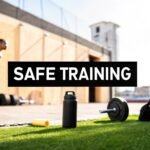
When it comes to sports, the best defense against injury is a good offense. This isn't about being aggressive on the field; it's about being proactive with your body before you even start playing. A truly effective strategy is a blend of smart preparation, disciplined technique, and intentional recovery. It’s about building a body that’s not just strong, but genuinely resilient to the unique demands of your sport.
Building a Proactive Injury Prevention Mindset
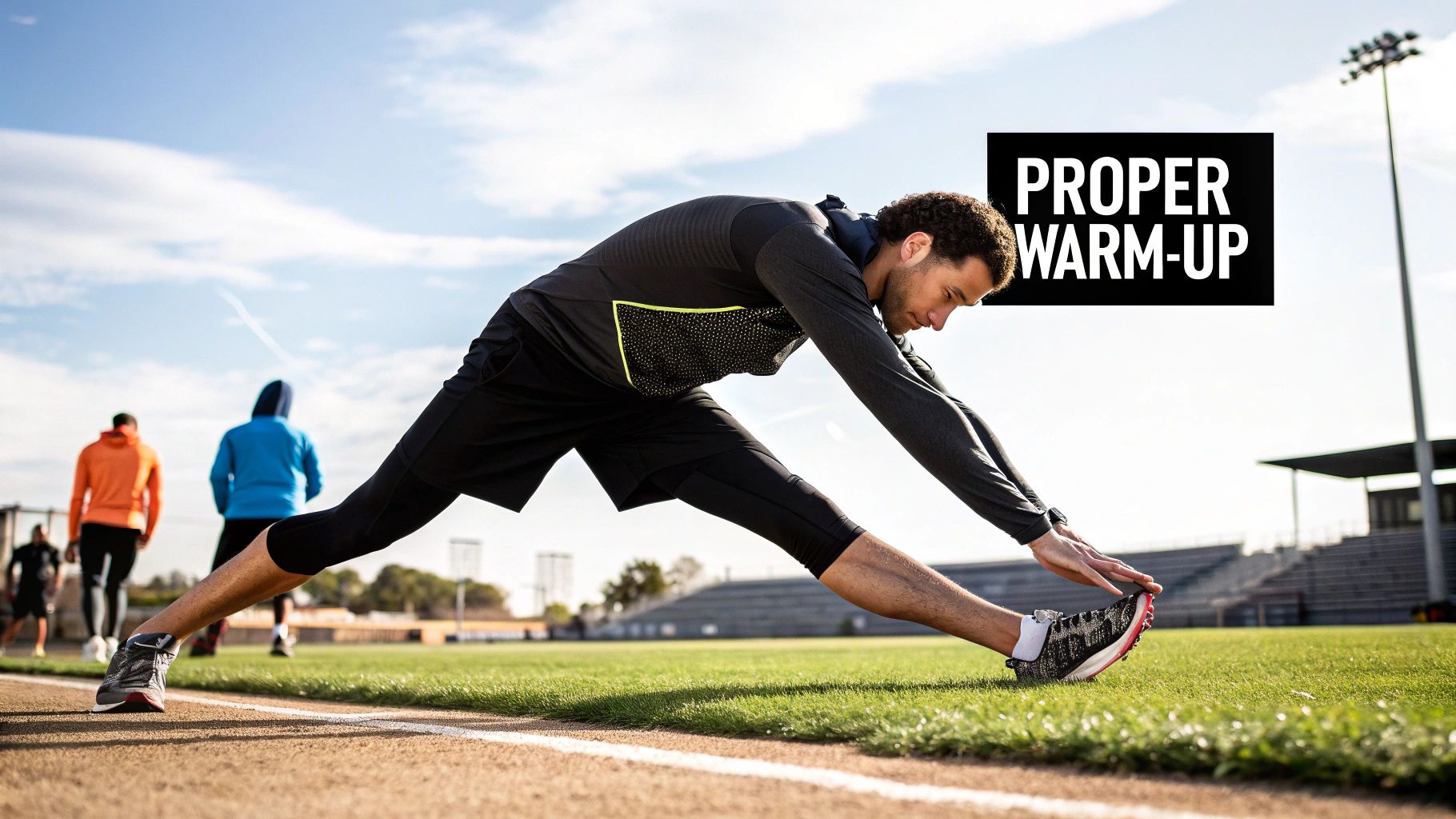
The real secret to staying in the game isn't avoiding activity—it's preparing your body for it with purpose. I’ve seen countless athletes fall into the reactive trap, only addressing a problem once the pain starts. This section is all about shifting that mindset. We'll focus on how to make physical preparation an ongoing process that not only keeps you healthy but can actually elevate your performance.
Think of this proactive approach as the most valuable piece of equipment you own. It’s not a checklist you tick off before the season starts; it’s a continuous cycle of smart choices that you make every single day.
Adopting the Athlete's Perspective
Elite athletes live by a simple truth: availability is their best ability. You can't perform if you're sidelined. They don't just train for power and speed; they train for resilience. Injury prevention is woven into the very fabric of their routine, from their morning meal to their post-session cooldown.
This perspective is especially critical when your activity level changes. After a break—whether it's an off-season or just a busy couple of weeks—your body is far more vulnerable. Just look at the data. After a historic dip in sports injuries during 2020, emergency departments saw a 20% surge in 2021 as people jumped back into their activities. This starkly illustrates the danger of returning to play without rebuilding your foundation. You can dig deeper into how sports participation impacts injuries with data from the National Safety Council's injury facts.
The goal is to make your body so well-prepared that it can handle the stress of your sport without breaking down. It's about building physiological armor through consistent, intelligent effort.
Core Pillars of a Resilient Body
A proactive mindset isn't just a vague idea; it's built on a few core pillars that support each other. If you neglect one, you create a weak link in the chain that leaves you exposed to injury.
To keep things clear, here’s a quick-reference table that breaks down these essential components.
Core Pillars of Injury Prevention at a Glance
| Pillar | Key Focus | Primary Benefit |
|---|---|---|
| Dynamic Preparation | Actively warming up the exact muscles and movement patterns used in your sport, moving beyond outdated static stretches. | Increases blood flow, improves mobility, and primes the nervous system for specific actions, reducing the risk of strains. |
| Technical Mastery | Concentrating on proper form to distribute force correctly across joints and muscles, avoiding overload on any single area. | Enhances efficiency, improves performance, and significantly cuts down on chronic and acute injuries caused by poor mechanics. |
| Strategic Recovery | Treating rest, sleep, and nutrition as active parts of training that repair tissue, reduce inflammation, and refuel the body. | Accelerates muscle repair, restores energy systems, and prevents the cumulative fatigue that often leads to breakdown. |
By mastering these pillars, you create a powerful, synergistic effect. Each element strengthens the others, turning what might seem like a chore into your greatest performance advantage. You’re not just avoiding injury—you’re building a more efficient, robust, and capable body.
Mastering Your Warm-Up and Cool-Down Routine
When people ask how to avoid sports injuries, the first thing that usually comes to mind is the old advice to "stretch before you play." While the intention is good, we know a lot more now. A truly effective routine is about much more than a few quick, static stretches. It's about thoughtfully preparing your body for the demands ahead and then guiding it back to a state of rest.
Think of the warm-up and cool-down as the bookends of your workout. They're your first line of defense against injury. Skipping them is like starting a car in freezing weather and immediately flooring it—you’re just asking for a breakdown.
The Power of a Dynamic Warm-Up
Forget those old-school gym class stretches where you'd hold a hamstring stretch for 30 seconds. Before you start any activity, your body craves movement, not static holds. A dynamic warm-up is all about actively moving your muscles and joints through their full range of motion. This is a game-changer for injury prevention.
This active approach gets your core temperature up, pushes blood flow to the muscles you're about to use, and wakes up your nervous system. You're not just passively pulling on a cold muscle; you're actively priming it for the real-world movements of your sport.
- For Soccer Players: Instead of a simple quad stretch, try leg swings (forward and side-to-side) and walking lunges with a torso twist. These movements get your hips, hamstrings, and core ready for the explosive kicking and sharp cuts you'll be doing on the field.
- For Swimmers: Grab some light resistance bands for pull-aparts and shoulder rotations. This fires up the small, crucial stabilizer muscles in your rotator cuff, setting you up for a powerful, pain-free stroke.
- For Runners: Focus on drills like high knees, butt kicks, and even just walking on your heels and then your toes. These improve your running form and warm up all the key muscles in your lower legs.
The principle is simple: your warm-up should look like a low-intensity version of your sport. It shouldn’t feel like a chore, but rather the beginning of your session, gradually ramping things up.
Why the Cool-Down Is Not Optional
When you finish your main workout or competition, your body is buzzing in a high-stress state. The cool-down is your chance to immediately kickstart the recovery process. This isn't just about catching your breath; it's an active process of helping your body clear out metabolic byproducts, like lactic acid, that accumulate during intense effort.
This image shows exactly where the warm-up and cool-down fit into the big picture.
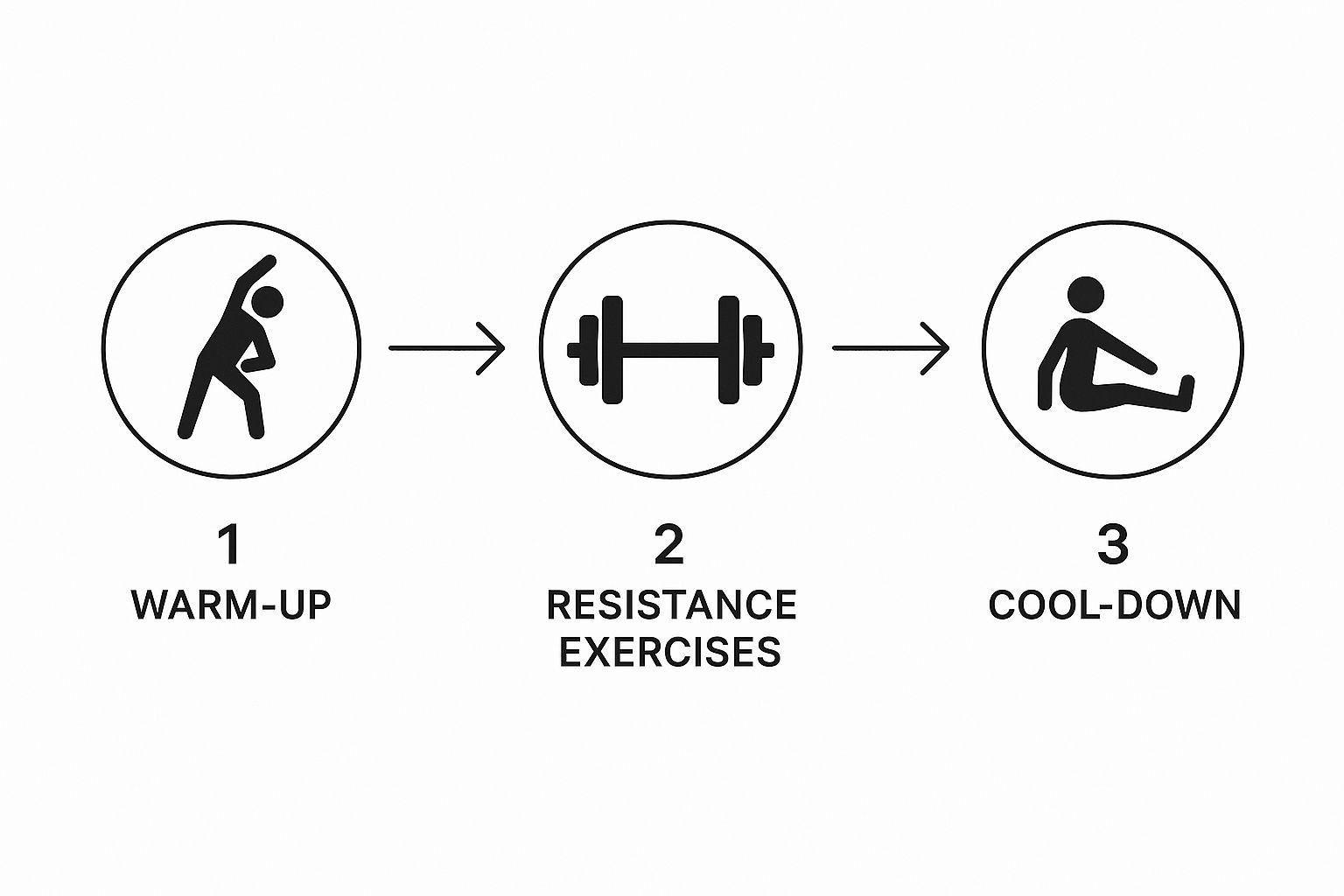
As you can see, they aren't just add-ons. They’re essential pieces of the entire training cycle.
A simple 5-10 minute cool-down of light cardio—like a slow jog or easy cycling—is incredibly effective. This is the perfect time for static stretching. Now that your muscles are warm and pliable, holding gentle stretches for 20-30 seconds can actually improve your long-term flexibility, reduce that next-day soreness, and get you ready for a stronger performance next time.
Perfecting Technique and Choosing the Right Gear

So, you've nailed your warm-up. That's fantastic, but it's really only half the battle. Now we need to talk about how you're moving and what you're wearing while you do it.
Think about it this way: your body is like a high-performance machine. Even with the engine perfectly warmed up, if the alignment is off, you’re going to get uneven wear on the tires and strain the suspension. Your technique and gear are your body’s alignment.
When your form is on point, the stress of your workout gets distributed evenly across your muscles and joints. This prevents any one area from getting overloaded, which is one of the biggest keys to avoiding those nagging, chronic injuries that sneak up on you over time.
Why Your Form Is Non-Negotiable
Let's be blunt: bad technique is a fast track to an injury you could have avoided. A small, seemingly harmless flaw in your form, when repeated over and over, is a recipe for pain and damage. It’s almost always the little things we don't notice that cause the biggest headaches down the line.
Just look at these common examples:
- The Weightlifter's Squat: Ever see someone's knees buckle inward when they squat? That puts a ton of unnecessary strain on the knee ligaments. It might seem minor, but it's a direct route to chronic knee pain or a nasty sprain.
- The Runner's Gait: If a runner overstrides, they're essentially slamming on the brakes with every single footfall. That jarring impact shoots right up the leg, and before they know it, they're dealing with shin splints or even stress fractures.
The best way to check your form is to get an outside perspective. Ask a qualified coach to take a look, or just prop up your phone and record yourself. You’ll probably be surprised at what you see.
Fixing these mechanical hiccups is absolutely fundamental if you want to stay active for the long haul. It doesn't just cut down your injury risk; it also makes you more efficient, which means better performance. And once your form is dialed in, a targeted https://blog.lamoondayspa.com/massage-for-athletes/ can be a game-changer for working out any lingering muscle tension from old bad habits.
Your Gear Is Your First Layer of Protection
The right equipment is your partner in crime for injury prevention. This isn't about buying the most expensive, flashy gear on the shelf. It's about getting equipment that fits you and is right for your sport. The right fit can be the difference between walking off a minor trip and being sidelined for the season.
Footwear That Fits Your Function
For pretty much any sport on your feet, your shoes are the foundation. They need to give you the right kind of support for the movements you're making. A basketball player needs solid ankle support for quick side-to-side cuts, while a runner needs cushioning tailored to their specific gait, whether they're a neutral runner or an overpronator.
Protective Gear That Actually Protects
In contact sports, things like helmets, pads, and mouthguards are non-negotiable. A properly fitted helmet can reduce the severity of a concussion by as much as 30%. It needs to be snug—so snug that when you turn your head, the helmet moves with it.
Even smaller details, like your clothing, matter. Learning some proven strategies for preventing chafing can save you from serious discomfort that can take you out of the game. Think of your gear as your armor. Make sure it fits right and does its job.
Fueling Your Body for Peak Performance and Repair
We often think about stretches and proper form when it comes to avoiding sports injuries, but what you put into your body is just as foundational. Think of your nutrition and hydration as the actual building blocks your body uses for energy, muscle repair, and overall resilience. Without the right fuel in the tank, even the most finely-tuned athletic machine will eventually sputter and break down.
Your diet is essentially your body's internal repair crew. The macronutrients—protein, carbohydrates, and fats—are the core of this team. Protein is absolutely critical for mending the microscopic tears in your muscles that happen during any tough workout; that's how you build strength. Carbohydrates are your go-to energy source, powering you through those demanding sessions. Meanwhile, healthy fats play a vital role in supporting hormone function and keeping inflammation in check.
Strategic Fueling for Resilience
It's not just what you eat, but when you eat it. Nailing your nutrient timing can give your recovery a serious boost. A great rule of thumb is to get 20-30 grams of protein within an hour after your workout. This timing helps maximize muscle protein synthesis—the scientific term for the rebuilding process that makes your muscles stronger.
For energy that lasts, focus on complex carbs like oats, brown rice, or sweet potatoes a couple of hours before you train. Unlike a sugary snack that gives you a quick spike and an even quicker crash, these foods release energy slowly and steadily. You'll avoid hitting that dreaded mid-workout wall.
Of course, nutrition is just one piece of the puzzle. Targeted exercises are a cornerstone of preventing injuries and improving performance. For example, golfers can build sport-specific strength and maintain crucial flexibility by incorporating essential golf fitness exercises for seniors.
Proper hydration is non-negotiable. I can't stress this enough. Even a small drop in your hydration levels can seriously hamper muscle function, slow your reaction time, and dramatically increase your risk of cramps and strains.
A simple, practical guideline is to drink half your body weight in ounces of water each day. So, if you weigh 160 pounds, you should be aiming for about 80 ounces of water daily—and that's before you even account for the fluids you lose through sweat during exercise.
The Role of Electrolytes and Modern Medicine
When you sweat, you're losing more than just water. You’re also losing critical electrolytes like sodium and potassium, which are essential for everything from muscle contractions to nerve signals. If your workout stretches beyond an hour, you need to think about replacing them. You don't always have to reach for a sugary sports drink, either. Natural sources like bananas, avocados, and even plain yogurt are fantastic for replenishment.
This growing emphasis on smart fueling and recovery is backed by some incredible advancements in sports medicine. The global sports medicine market was valued at USD 6.29 billion and continues to grow, which shows just how much we've learned about keeping athletes healthy. This field is responsible for everything from advanced orthopedic devices to regenerative therapies that help athletes get back in the game faster and stay there longer.
Embracing Rest and Smart Recovery Strategies
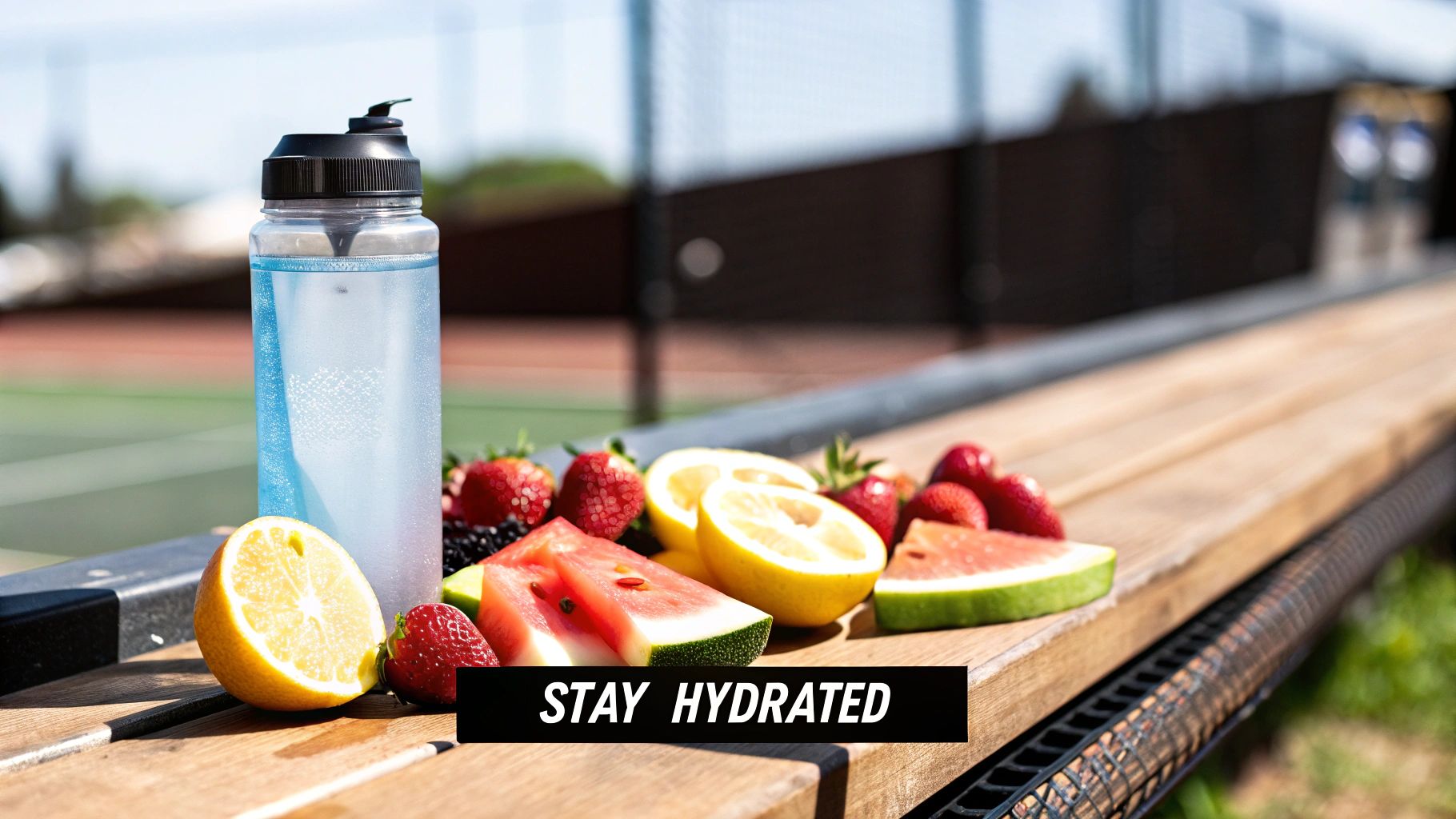
True athletic resilience isn't just built in the gym or on the field; it’s forged during the hours you spend recovering. It's a common mistake for athletes to see rest as a sign of weakness or just wasted time. The reality is, it's during these crucial recovery periods that your body actually adapts, repairs tissue, and gets stronger. Skipping out on rest is a fast track to burnout and injury.
It helps to think of rest as an active part of your training. That's a huge mindset shift. Your muscles don't grow while you're lifting weights—they grow afterward. Your endurance doesn't build while you're running, but when your body adapts to the stress you've put on it. And that adaptation only happens with enough downtime.
Prioritizing Sleep for Physical Repair
Sleep is probably the most powerful recovery tool you have, and it's completely free. While you're sleeping, your body is hard at work repairing the damage from your training. It releases growth hormone, which is absolutely essential for muscle repair, and it works to keep hormones like cortisol—your main stress hormone—in check. Cutting sleep short basically pulls the plug on this whole process.
In fact, studies have shown that athletes who get less than six hours of sleep a night are 70% more likely to get injured. This isn't just about feeling a little tired. You're literally robbing your body of its best chance to heal and rebuild. A consistent sleep schedule has to be a non-negotiable part of any serious training plan.
Your body sends clear signals when it's not recovering. Learning to distinguish between productive muscle soreness and the sharp, persistent pain of an impending injury is a skill that can save your season. Listen to those warning signs.
Active Recovery and Listening to Your Body
Rest days don't always have to mean lying on the couch. Active recovery is all about low-intensity activities that get blood flowing to your muscles. This helps flush out metabolic waste and reduce soreness without piling on more stress.
Think about weaving some of these into your routine:
- Foam Rolling: Great for targeting tight spots and muscle knots. It really helps with flexibility and easing tension.
- Dynamic Stretching: Gentle, flowing movements are perfect for maintaining mobility on your off days.
- Low-Intensity Cardio: A light walk, a relaxed swim, or an easy spin on a bike can do wonders for recovery.
These methods are fantastic for daily maintenance. For deeper, more targeted work, exploring the benefits of sports massage can help release chronic tension and sort out specific problem areas before they turn into full-blown injuries.
Ultimately, the goal is to create a sustainable training cycle with planned periods of high intensity balanced by smart, deliberate recovery. This whole concept, known as periodization, is the key to dodging overtraining syndrome and making sure you stay healthy for the long run.
Using Technology to See Injuries Coming
Welcome to the future of staying healthy in sports, where data is now one of your best lines of defense. For as long as I can remember, deciding when to push harder or when to pull back was mostly a gut feeling. But now, we have technology that gives us a clear, objective look at what's happening inside our bodies, completely changing how we train and helping us stay on the field.
Modern wearables—think smartwatches, fitness bands, and even sophisticated GPS trackers—are constantly monitoring crucial metrics. They track your training load (how much stress you're putting on your body), the intensity of that strain, and how well you're actually recovering. These devices turn that vague feeling of being "a bit tired" into hard data you can use to make smarter decisions.
This move toward data-backed prevention is a huge deal, and it's a big part of how we avoid sports injuries today. The global market for this kind of sports injury prediction tech was valued at USD 2.1 billion and is expected to grow to USD 2.74 billion. That growth is happening because more and more athletes and coaches are realizing how valuable these tools are.
Turning Data Into Action
Of course, just having a mountain of data doesn't do you any good. The key is knowing what to do with it. Many wearables give you a "readiness" or "recovery" score, which is a neat little summary of your sleep quality, heart rate variability (HRV), and recent training stress.
A Pro Tip From Experience: A consistently low recovery score is your body's biggest warning sign. It's a data-driven alarm bell telling you that you're not adapting to your training, and you might be heading for overtraining or, worse, an injury.
Let’s look at a real-world example. A soccer player might feel perfectly fine after a tough week of practice. But their GPS data could reveal they’ve covered way more high-intensity distance than they normally do. Armed with that knowledge, a coach can decide to dial back the next training session a bit. This simple adjustment could prevent a hamstring strain that was just waiting to happen.
To get the most out of this approach, you need the right tools. It's worth exploring options like the best soccer GPS tracking systems that the pros rely on. By replacing guesswork with smart, data-informed science, you can train more effectively and build a body that's ready for anything.
Common Questions About Preventing Sports Injuries
Even when you do everything right, questions are bound to come up. It's totally normal. Knowing how to interpret what your body is telling you, what to do about those little aches, and understanding your own unique risk factors are all key to staying in the game long-term. Let's dig into some of the most common things athletes ask.
How Do I Know if I Am Overtraining?
There’s a big difference between feeling wiped out after a tough session and being chronically exhausted. Overtraining is what happens when you consistently push your body harder than it can recover. It's not just about one workout; it's a cumulative effect, and your body will definitely send you signals when you're crossing the line.
Look out for these classic red flags:
- Persistent Fatigue: You just feel drained, even after what should have been a good night's sleep.
- Performance Dips: You're putting in the work, but your times are getting slower, or you can't lift what you used to.
- Mood Changes: You might find yourself more irritable, anxious, or just unable to focus.
If this sounds like you, it’s a clear sign from your body to pump the brakes. It's time to schedule more rest and active recovery.
Ignoring these warnings is a surefire way to end up burned out or injured. Listening to your body isn't a sign of weakness—it's the smartest thing an athlete can do.
Are Some People More Prone to Injury?
Absolutely. Some factors definitely increase your risk. Your personal injury history is a huge one. If you've sprained an ankle before, that joint is often more vulnerable to future sprains, especially if it wasn't fully rehabilitated.
Your individual biomechanics also matter a lot—things like having flat feet, high arches, or how your hips are aligned can create stress patterns that lead to injury. Even genetics can play a part in your ligament flexibility or tissue makeup. While you can't change your genes, knowing your body's tendencies means you can be proactive with targeted strengthening and technique work to protect those vulnerable spots.
What Should I Do Immediately After a Minor Injury?
For those minor tweaks, sprains, or strains, the go-to protocol is P.O.L.I.C.E. It’s a modern take on R.I.C.E. that helps kickstart the healing process right away.
- Protection: Stop what you're doing and protect the injured area from more stress.
- Optimal Loading: This is a big change from old advice. Instead of total rest, gentle, pain-free movement actually encourages better healing.
- Ice: Apply a cold pack for 15-20 minutes at a time to help manage inflammation.
- Compression: A simple elastic bandage can help control swelling.
- Elevation: Whenever possible, raise the injured limb above the level of your heart.
This immediate first aid is vital, but you also have to know when to call in a professional. If the pain is severe, the swelling is significant, or you can't put any weight on it, it's time to see a doctor. For those nagging issues that just won't go away, a professional massage for sports injuries can be a game-changer for breaking up scar tissue and speeding up recovery.
At La Moon Massage and Facial, we specialize in therapeutic treatments that help athletes recover faster, ease muscle tension, and stay in peak condition. Experience premium massage and wellness services designed to soothe your mind and body.
What to Do Before a Massage: 6 Tips for 2025
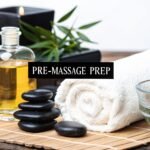
A massage is a significant investment in your well-being, a dedicated time to unwind, heal, and rejuvenate. But did you know that the benefits of your session begin long before you step into the treatment room? Proper preparation is the key to transforming a good massage into an extraordinary one. By taking a few simple, strategic steps beforehand, you can enhance muscle pliability, deepen your relaxation, and ensure your therapist can provide the most effective treatment possible.
This guide outlines the essential actions to take, moving beyond the obvious to provide detailed, actionable insights. Whether you're a seasoned athlete managing soreness or planning your first session at a premium day spa like La Moon Massage and Facial in Houston, understanding what to do before a massage will elevate your entire experience. These practical tips ensure you receive the maximum therapeutic value for your mind and body, preparing you to fully embrace the healing process from the moment you arrive. Let's explore the pre-massage game plan that guarantees peak relaxation and recovery.
1. Hydrate Properly 24 Hours Before
Proper hydration is one of the most impactful yet simple steps you can take when considering what to do before a massage. Think of your muscles and connective tissues (fascia) as a dense network of sponges. When well-hydrated, these sponges are plump, supple, and pliable. This allows your massage therapist to work more deeply and effectively, releasing knots and adhesions with greater ease and less discomfort for you.
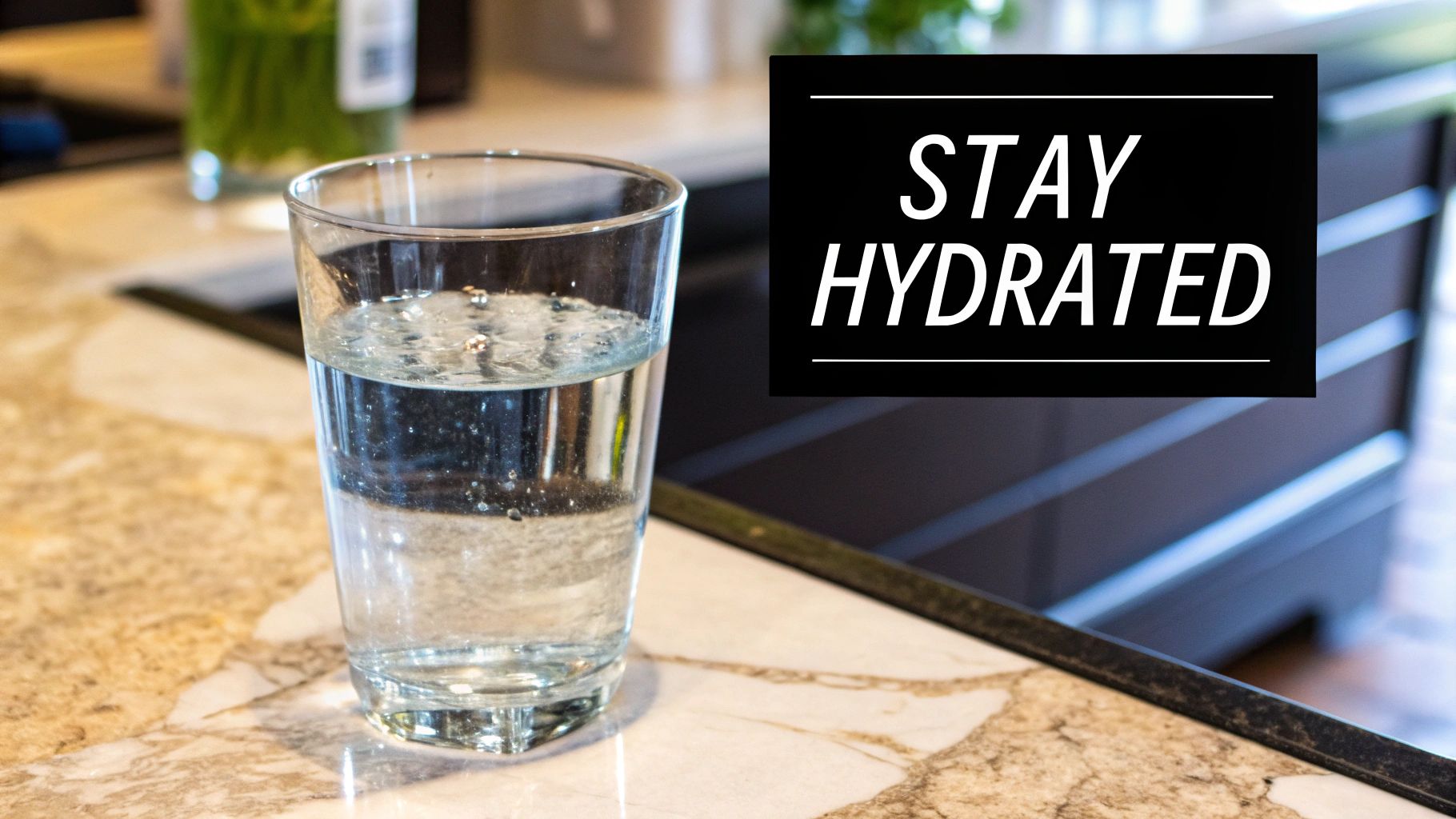
Conversely, dehydrated muscle tissue is tight, stiff, and brittle. Attempting to manipulate these constricted tissues can be less productive and may even feel more painful, as the muscles resist the therapist's pressure. Hydrating properly helps flush metabolic waste that can accumulate in muscles, reducing post-massage soreness and enhancing the detoxifying effects of the treatment.
Why It's Crucial for Different Massage Types
The importance of pre-massage hydration is amplified depending on the type of bodywork you are receiving.
- For Deep Tissue Massage: Athletes and individuals with chronic muscle tension often seek deep tissue work. Proper hydration is non-negotiable here. It softens the fascia, allowing the therapist to access deeper muscle layers without causing excessive pain or potential micro-tears in the tissue.
- For Sports Massage: If you’re getting a sports massage to prepare for an event or recover from intense training, hydration is key to muscle elasticity and function. Well-hydrated muscles are less prone to cramping and injury.
- For General Relaxation: Even for a Swedish or relaxation massage, being hydrated enhances the experience by making your skin more receptive to oils and lotions and improving overall circulation, which amplifies the feeling of well-being. To maximize these benefits, you can explore how to achieve proper hydration for your skin, as it's key for overall wellness and prepares your body for the massage.
Key Insight: Hydration doesn't just prepare your muscles; it also helps your body process and eliminate the toxins that are released from your tissues during the massage. This can significantly reduce next-day soreness.
Actionable Hydration Plan
To ensure you're optimally hydrated, follow a structured approach.
- The 24-Hour Rule: Begin intentionally increasing your water intake the day before your appointment. Aim for 8-10 glasses of water spread throughout the day.
- Taper Off: Avoid drinking a large amount of water within the two hours leading up to your session. This prevents the need for a mid-massage bathroom break, which can disrupt your state of relaxation.
- Check Your Urine: The clearest indicator of your hydration status is your urine color. Aim for a light, pale yellow. Dark yellow or amber is a sign you need to drink more water.
- Consider Electrolytes: If you've been exercising heavily or sweating a lot, consider adding an electrolyte powder or a low-sugar sports drink to one of your glasses of water. This replenishes essential minerals like potassium and sodium that are lost through sweat.
2. Avoid Heavy Meals 2-3 Hours Prior
Timing your meals correctly is a critical part of what to do before a massage to ensure maximum comfort and relaxation. Consuming a large meal shortly before your session forces your body to direct significant blood flow and energy toward digestion. This internal activity directly competes with the goals of massage therapy, which aims to promote relaxation, improve circulation to your muscles, and calm your nervous system.

Lying face down on a massage table with a full stomach can cause physical discomfort, bloating, and indigestion, making it difficult to relax and breathe deeply. Instead of your body focusing on healing and releasing tension, it's preoccupied with processing food. This can detract from the therapeutic benefits, leaving you feeling more sluggish than rejuvenated.
Why It's Crucial for Different Massage Types
The impact of pre-massage eating varies, but it's a key consideration across all modalities.
- For Abdominal Massage: This is the most critical scenario. Any recent meal can make direct work on the abdominal area uncomfortable or even impossible. Therapists focusing on visceral manipulation or digestive health will specifically require you to fast for several hours.
- For Deep Tissue and Sports Massage: These intense modalities require your muscles to be relaxed and receptive. A full stomach can cause systemic inflammation and pull resources away from the muscles, making them less pliable and potentially increasing discomfort during deep pressure work.
- For Relaxation or Hot Stone Massage: The goal here is to achieve a deep state of calm. Digestive processes can create internal "noise," like gurgling sounds and feelings of fullness, that keep you mentally and physically distracted, preventing you from fully immersing yourself in the experience.
Key Insight: A full stomach can elevate your heart rate and body temperature as it digests. This can interfere with the parasympathetic "rest and digest" state that massage is designed to induce, limiting the overall effectiveness of your treatment.
Actionable Meal-Timing Plan
To avoid discomfort and enhance your massage, follow this simple eating schedule.
- The 2-3 Hour Rule: Plan to eat your last substantial meal at least two to three hours before your scheduled appointment. This gives your body ample time to complete the most demanding phase of digestion.
- Opt for a Light Snack: If you feel hungry closer to your session, a light, easily digestible snack about 60 minutes prior is perfectly acceptable. Think of a small piece of fruit, a handful of almonds, or a simple granola bar.
- Avoid Problematic Foods: On the day of your massage, steer clear of foods known to cause gas and bloating. This includes beans, lentils, broccoli, cabbage, and carbonated beverages. Also, avoid heavy, greasy, or fried foods that are slow to digest.
- Listen to Your Body: Don't arrive starving, as a rumbling stomach and low blood sugar can also be distracting. The goal is to arrive feeling neutral and comfortable, not overly full or famished.
3. Communicate Health Conditions and Concerns
Open and honest communication with your massage therapist is not just a courtesy; it's a critical component of a safe and effective treatment. Your therapist is a trained professional, but they aren't a mind reader. Sharing your health history, current conditions, injuries, and even anxieties allows them to tailor the session specifically to your body's needs, ensuring you get the maximum benefit while avoiding any potential harm.
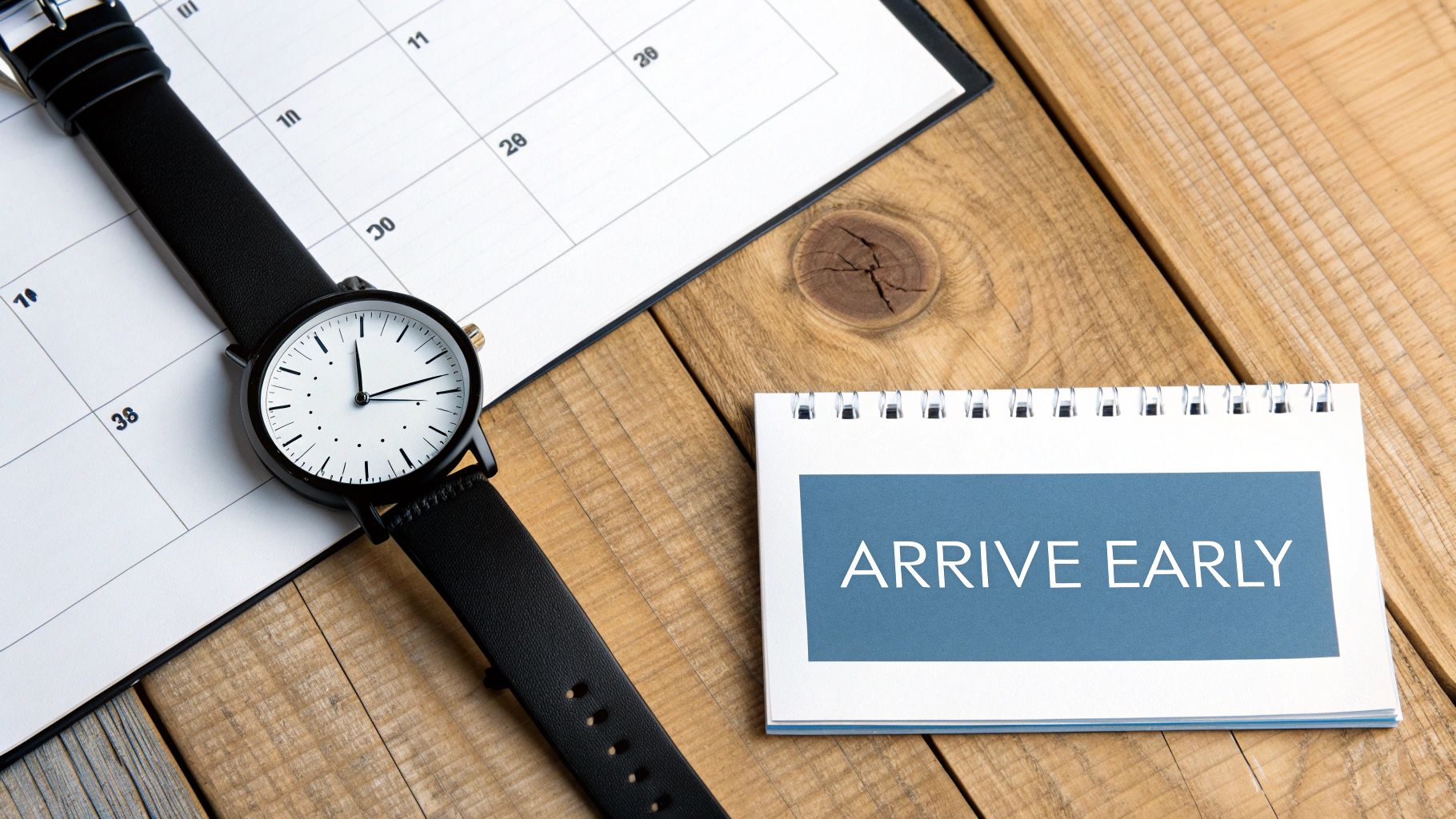
Think of this conversation as building the blueprint for your massage. Information about a recent surgery, a sensitive area, or a medication you're taking helps the therapist select the right techniques and avoid contraindicated areas or methods. This dialogue transforms a generic massage into a personalized therapeutic experience, directly addressing your unique goals, whether they be pain relief, relaxation, or improved athletic performance.
Why It's Crucial for Different Scenarios
Full disclosure is vital across all types of massage, but its importance is magnified in specific situations.
- For Injury Recovery: If you have a recent sprain, strain, or are recovering from surgery, your therapist must know. They can work around the injured area to reduce compensatory tension in other muscles or use specific, gentle techniques to aid healing, but only if they are fully informed.
- For Chronic Conditions: Individuals with conditions like arthritis, fibromyalgia, or sciatica require a specialized approach. Certain techniques may soothe symptoms, while others could cause a flare-up. It's also crucial to discuss any specific discomforts you're experiencing, such as a stiff neck, with your therapist. This also applies when deciding between different therapies for conditions like a stiff neck.
- For Prenatal Massage: Pregnancy involves significant physiological changes. A therapist trained in prenatal massage will use specific positioning and avoid certain pressure points, but they need you to confirm the pregnancy and how far along you are to ensure the safety of both mother and baby.
Key Insight: Don't withhold information because you think it's minor or irrelevant. Something as simple as a new medication (like a blood thinner) or a patch of sensitive skin can dramatically change the type of pressure or lotion a therapist should use.
Actionable Communication Plan
Be proactive and thorough with your communication before and during the session.
- Complete Intake Forms Honestly: Your session begins with the intake form. Fill it out completely and accurately. This is your first and best opportunity to list medications, allergies, injuries, and health conditions.
- Verbal Check-In: Before you get on the table, the therapist will likely ask about your goals. Use this time to reiterate key points. For example: "I mentioned my right shoulder injury on the form; I'd like you to focus on the tension in my neck but avoid deep pressure directly on the shoulder joint."
- Discuss Pressure Preferences: Clearly state your preference for light, medium, or deep pressure. Remember that you can ask for adjustments at any point during the massage.
- Speak Up During the Session: If you feel any sharp pain, discomfort, or numbness, tell your therapist immediately. It's your body and your time. Effective communication is essential, especially for a sports massage for athletes where specific muscle groups are targeted.
4. Arrive 15 Minutes Early
One of the most overlooked yet crucial aspects of what to do before a massage is managing your arrival time. Arriving 10-15 minutes early is not just a courtesy; it's a strategic part of the therapeutic process. This buffer period allows you to transition from the fast-paced, high-stress world outside to the tranquil environment of the spa or clinic, ensuring you start your session in a calm, receptive state rather than a rushed, frazzled one.
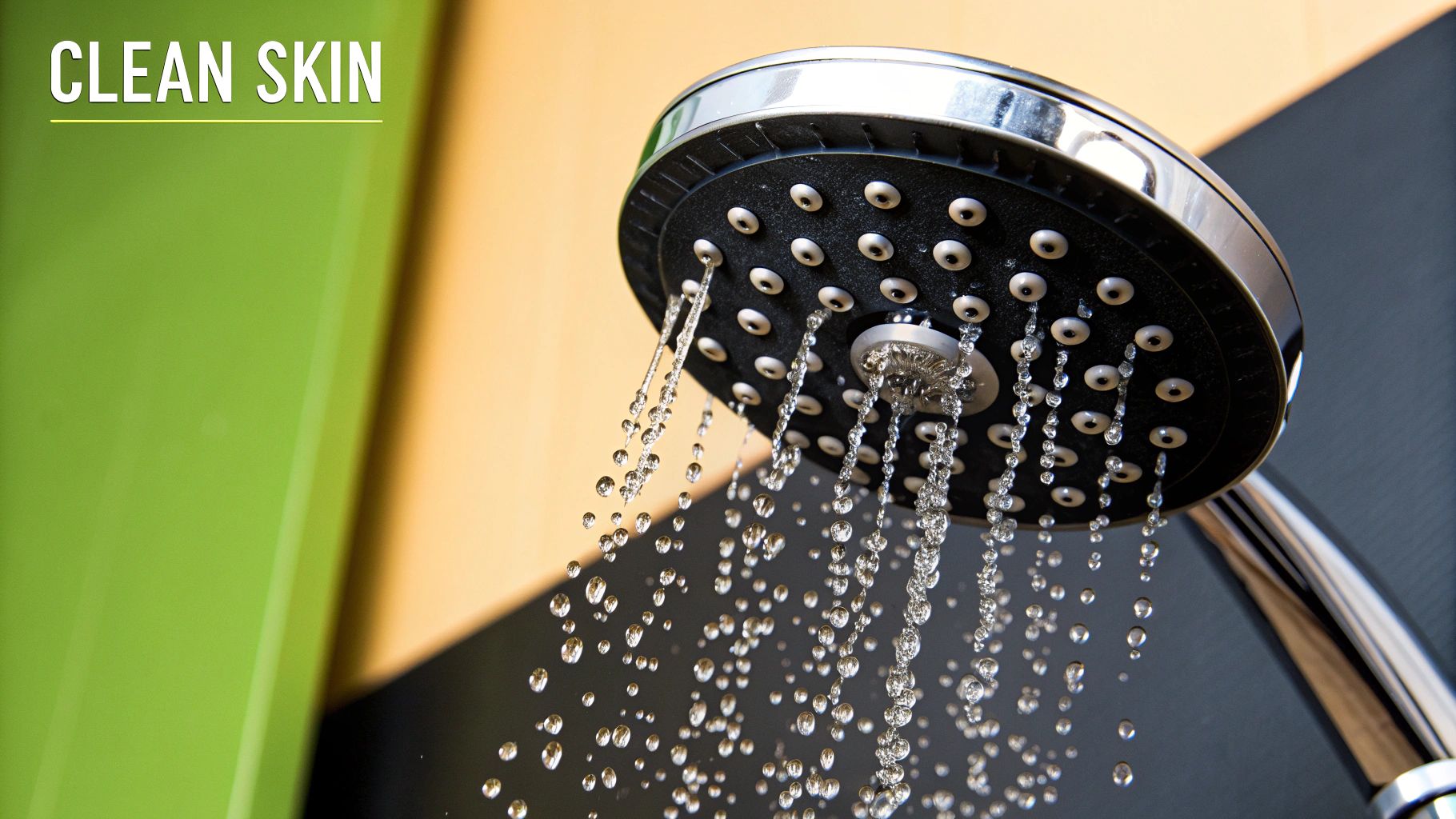
Rushing to an appointment floods your body with stress hormones like cortisol and adrenaline, causing your muscles to tighten. This creates a state of physical resistance that directly counteracts the goals of the massage. By arriving early, you allow your nervous system to downshift, your heart rate to slow, and your muscles to begin relaxing even before the therapist lays a hand on you. This preparation helps maximize every minute of your paid session time.
Why It's Crucial for Different Massage Environments
The importance of an early arrival can vary slightly depending on the setting, but the core benefit remains the same: preparation.
- For High-End Spas: These establishments often build this buffer time into their protocols. Arriving early allows you to check in, receive a robe and slippers, perhaps enjoy a cup of herbal tea, and use the restroom without feeling rushed. This entire ritual is designed to begin the relaxation process.
- For Medical or Clinical Massage: In a therapeutic setting, this time is essential for a pre-session consultation. You'll likely need to fill out or update intake forms regarding your pain points, health changes, or specific goals for the session. This detailed communication is vital for an effective, targeted treatment.
- For Wellness Centers: These centers often use the pre-massage window for a brief consultation to tailor the session to your immediate needs. This is your opportunity to discuss areas of tension, injuries, or preferences for pressure, ensuring a customized and beneficial experience.
Key Insight: Your massage doesn't start when the therapist begins the hands-on work; it starts the moment you walk through the door. Arriving early transforms travel stress into preparatory tranquility, making your treatment significantly more effective.
Actionable Arrival Plan
To ensure a smooth, stress-free start to your appointment, integrate these steps into your routine.
- Plan Your Logistics: The day before, confirm the address and check for any potential traffic or parking challenges. Knowing your route and where to park eliminates last-minute anxiety.
- Set a "Leave By" Alarm: Instead of an alarm for when your appointment starts, set one for when you need to leave. Add a 15-minute cushion to this time.
- Use the Time Wisely: Once you arrive, turn your phone on silent and put it away. Take a few deep, mindful breaths. Use this quiet time to mentally disconnect from your to-do list and focus on your intention for the massage.
- Communicate Delays: If you are running late, call the facility as soon as you can. They may need to adjust the session length, but communicating shows respect for the therapist's time. This also aligns with the principles of consistent body care; for more on establishing a routine, consider learning about how often you should get a massage.
5. Shower or Cleanse Your Skin
Showering before your session is a simple act of courtesy that significantly enhances the entire massage experience for both you and your therapist. Clean skin is not just about basic hygiene; it directly impacts the effectiveness of the treatment. Freshly cleansed skin absorbs massage oils and lotions more efficiently, allowing for a smoother glide and better delivery of any therapeutic ingredients.
From a practical standpoint, arriving clean ensures that the focus remains entirely on your treatment. It removes sweat, environmental pollutants, and residual personal care products, creating a neutral canvas. This prevents any bacteria from being rubbed into your pores during the massage, reducing the risk of skin irritation or breakouts, and creates a more pleasant and professional environment for everyone.
Why It's Crucial for Different Massage Types
The simple act of cleansing takes on greater importance depending on the context of your appointment.
- For Sports Massage: If you're an athlete coming directly from a workout or training session, a quick rinse is essential. It washes away sweat and grime, preventing clogged pores and allowing the therapist to work on your muscles without interference, which is a key part of what to do before a massage for athletic recovery.
- For Hot Stone Massage: The heat from the stones opens your pores. Arriving with clean skin is crucial to ensure that only the beneficial oils are absorbed, not dirt or bacteria, which could lead to skin reactions.
- For Spa Treatments: Many day spa packages or rituals begin with a cleansing step, like a steam shower or body scrub. This is done intentionally to prep the skin, maximizing the benefits of subsequent treatments and enhancing relaxation. To ensure your skin is perfectly prepped, understanding the significance of a thorough cleanse is key. For more on this, consider learning about the importance of skin cleansing and care.
Key Insight: A warm shower does more than just clean your skin. The warmth helps to relax your muscles superficially, making it easier for the therapist to begin their work and for you to settle into a state of relaxation more quickly.
Actionable Cleansing Plan
Follow these simple steps to ensure you arrive perfectly prepped for your session.
- Timing is Key: Aim to shower within a few hours of your appointment. This ensures you are fresh without rushing or arriving with damp skin.
- Use Gentle Cleansers: Opt for a mild, non-irritating soap or body wash. Avoid harsh exfoliants or scrubs right before your session, as this can make your skin overly sensitive to pressure and friction.
- Skip Strong Scents: Refrain from applying heavy perfumes, colognes, or strongly scented lotions after your shower. Your therapist may use specific aromatherapy oils, and conflicting scents can be overwhelming in a small treatment room.
- Pat, Don't Rub: After showering, gently pat your skin dry with a towel instead of rubbing vigorously. This prevents minor skin irritation and keeps your skin calm and ready for the massage.
6. Limit Alcohol and Caffeine Consumption
Just as proper hydration is vital, limiting substances that counteract its effects is a crucial step when considering what to do before a massage. Both alcohol and caffeine are diuretics, meaning they cause your body to lose water, leading to dehydration. This dehydrating effect can make your muscles tighter and more sensitive, potentially diminishing the positive outcomes of your session and increasing discomfort.
Furthermore, these substances directly affect your nervous system and circulation. Alcohol can impair your judgment and dull your senses, preventing you from giving accurate feedback to your therapist about pressure and comfort. Caffeine, on the other hand, is a stimulant that can increase heart rate and muscle tension, making it difficult for your body and mind to fully relax and receive the therapeutic benefits of the massage.
Why It's Crucial for Different Massage Types
The impact of these substances varies, but avoiding them is universally beneficial for enhancing your treatment.
- For Deep Tissue and Sports Massage: These modalities require your muscles to be pliable and responsive. Alcohol consumption can increase inflammation and sensitivity, making deep work more painful. Caffeine can heighten muscle tension, forcing your therapist to work harder to release knots and potentially leading to post-massage soreness.
- For Medical or Therapeutic Massage: When receiving treatment for a specific injury or medical condition, it's essential that your body's natural feedback system is uninhibited. Substances can mask pain or alter your perception, which can be counterproductive or even risky during focused therapeutic work.
- For Relaxation Massage: The primary goal here is to calm the nervous system. Caffeine directly opposes this by creating a state of alertness and sometimes anxiety. While alcohol might seem relaxing, it disrupts true restorative rest, and you won't experience the full mental and physical release that a Swedish or relaxation massage offers. The right atmosphere, enhanced by calming scents, is key, and you can learn more about how massage oils aid in achieving deep relaxation to complement a substance-free preparation.
Key Insight: Arriving for your massage in a natural, unaltered state allows your therapist to accurately assess your muscle condition and apply the most effective techniques. It also enables your body to respond optimally to the treatment, maximizing both the immediate and long-term benefits.
Actionable Pre-Massage Plan
To ensure your body is in the best possible state for your appointment, follow these clear guidelines.
- The 24-Hour Alcohol Rule: Refrain from consuming alcoholic beverages for at least 24 hours prior to your massage. This gives your body ample time to process the alcohol and rehydrate.
- Time Your Caffeine: If you are a regular coffee or tea drinker, try to have your last caffeinated drink at least four to six hours before your session. Limiting it to only your morning cup on the day of your massage is a good rule of thumb.
- Choose Calming Alternatives: In the hours leading up to your massage, opt for hydrating and calming beverages like water, decaffeinated herbal tea (such as chamomile or peppermint), or coconut water.
- Honesty is the Best Policy: If you have had a drink, be sure to inform your massage therapist. They can adjust the technique and pressure accordingly to ensure your safety and comfort. Never arrive for an appointment intoxicated.
6-Step Pre-Massage Preparation Comparison
| Preparation Step | Implementation Complexity 🔄 | Resource Requirements ⚡ | Expected Outcomes 📊 | Ideal Use Cases 💡 | Key Advantages ⭐ |
|---|---|---|---|---|---|
| Hydrate Properly 24 Hours Before | Low – simple habit to maintain | Minimal – access to water | Improved tissue flexibility, reduced soreness | Deep tissue massages, sports therapy | Maximizes massage benefits, reduces discomfort |
| Avoid Heavy Meals 2-3 Hours Prior | Low – requires meal timing planning | Minimal – meal coordination | Prevents digestive discomfort, enhances relaxation | Spa and medical massage sessions | Enhances comfort, reduces nausea risk |
| Communicate Health Conditions and Concerns | Moderate – requires honesty and detail | Minimal – time for disclosure | Safe, customized treatment, injury prevention | All massage types, especially therapeutic | Maximizes safety and effectiveness, builds trust |
| Arrive 15 Minutes Early | Low – simple scheduling adjustment | Minimal – time investment | Reduced stress, full appointment utilization | All appointments | Ensures full treatment time, reduces anxiety |
| Shower or Cleanse Your Skin | Low to Moderate – requires planning | Basic hygiene products | Better oil absorption, hygiene, reduced irritation | Spa, wellness, and sports massages | Improves comfort, prevents skin reactions |
| Limit Alcohol and Caffeine Consumption | Moderate – lifestyle adjustment needed | Minimal – avoidance of substances | Better relaxation, circulation, reduced adverse reactions | Pre-treatment for all massage types | Enhances therapeutic effects, improves recovery |
Your Next Step Towards Ultimate Rejuvenation
You’ve explored the essential framework for a truly transformative massage experience. The journey to deep relaxation and effective muscle recovery doesn't start the moment you lie on the table; it begins hours, and even a full day, beforehand. Understanding what to do before a massage is the key to unlocking the full spectrum of benefits, turning a good session into a phenomenal one.
By now, you recognize that these aren't just arbitrary rules. They are strategic actions designed to prepare your body’s internal and external environments for healing. Think of it as priming a canvas before creating a masterpiece. Proper hydration ensures your muscle tissue is pliable and ready to release tension. Avoiding a heavy meal prevents your body's energy from being diverted to digestion, allowing it to focus entirely on repair and relaxation.
From Preparation to Partnership
The most crucial takeaway is that a massage is a collaborative effort. Your preparation is your contribution to this partnership.
- Communication is Key: Openly discussing your health conditions, pain points, and preferences with your therapist isn't just helpful; it's fundamental. This dialogue transforms the session from a generic service into a personalized therapeutic treatment tailored specifically to your needs, whether you're an athlete recovering from intense training or someone seeking relief from chronic soreness.
- Creating a Calm Headspace: Arriving early, cleansing your skin, and limiting stimulants like caffeine and alcohol are all acts of self-respect. They signal to your mind and body that it's time to slow down and transition away from the stress of daily life. This mental shift is just as important as the physical preparation, allowing you to be fully present and receptive to the therapist's work.
Mastering these pre-massage rituals empowers you to take an active role in your own wellness journey. You are no longer a passive recipient of a service but an informed participant co-creating a powerful healing experience. This proactive approach ensures that every dollar and every minute you invest in a massage delivers the maximum possible return in the form of pain relief, reduced stress, and enhanced physical performance. Your body, whether aching from a workout or tight from a desk job, will thank you for this thoughtful preparation. Embrace these steps, and you will undoubtedly feel a profound difference in your next session.
Ready to experience the powerful benefits of a professionally delivered massage enhanced by your own expert preparation? The skilled therapists at La Moon Massage and Facial are dedicated to understanding your unique needs and helping you achieve your wellness goals. Put your new knowledge into practice and book your next appointment with us to feel the remarkable difference that a truly collaborative massage can make.
6 Essential Post Massage Care Tips for 2025

You've just stepped out of a blissful massage session, feeling relaxed and rejuvenated. But the benefits don't have to end when you leave the spa. The 24 hours following your appointment are a critical window for maximizing therapeutic effects and ensuring long-lasting relief. Proper post massage care is the secret to transforming a great massage into an exceptional wellness experience, a concept that complements other physical wellness routines. For athletes and fitness enthusiasts, this practice is as vital as understanding smarter post-workout recovery strategies for peak performance.
Effective aftercare involves a series of simple, intentional actions that support your body's recovery process. These steps help flush out metabolic waste released from your tissues and lock in that profound sense of calm and flexibility. Neglecting this crucial phase can unfortunately lead to next-day soreness, dehydration, and a quick return of the very tension you just paid to release.
This guide provides six essential, actionable strategies to extend the benefits of your treatment. Whether you've had a soothing Swedish massage or an intense deep tissue session, these expert-approved tips will help you make the most of your investment in your well-being and prolong the positive effects for days to come.
1. Hydrate Immediately and Continuously
Of all the post massage care steps you can take, rehydrating your body is arguably the most critical. Think of a deep tissue massage as a form of passive exercise for your muscles. The therapist's hands, elbows, and tools work to release tight knots and adhesions, which stimulates circulation and encourages the release of metabolic waste products stored in your tissues. Proper hydration is the vehicle that flushes these byproducts out of your system, preventing them from lingering and causing post-massage soreness or fatigue.
Without sufficient water, your body cannot efficiently process and eliminate these substances. The increased blood flow and lymphatic drainage initiated by the massage require fluid to function optimally. Failing to hydrate is like cleaning your house but leaving the trash bags inside; the system gets bogged down, and you won't feel the full, rejuvenating effects of your session. This simple step is fundamental to maximizing your recovery and prolonging the benefits of the therapy.
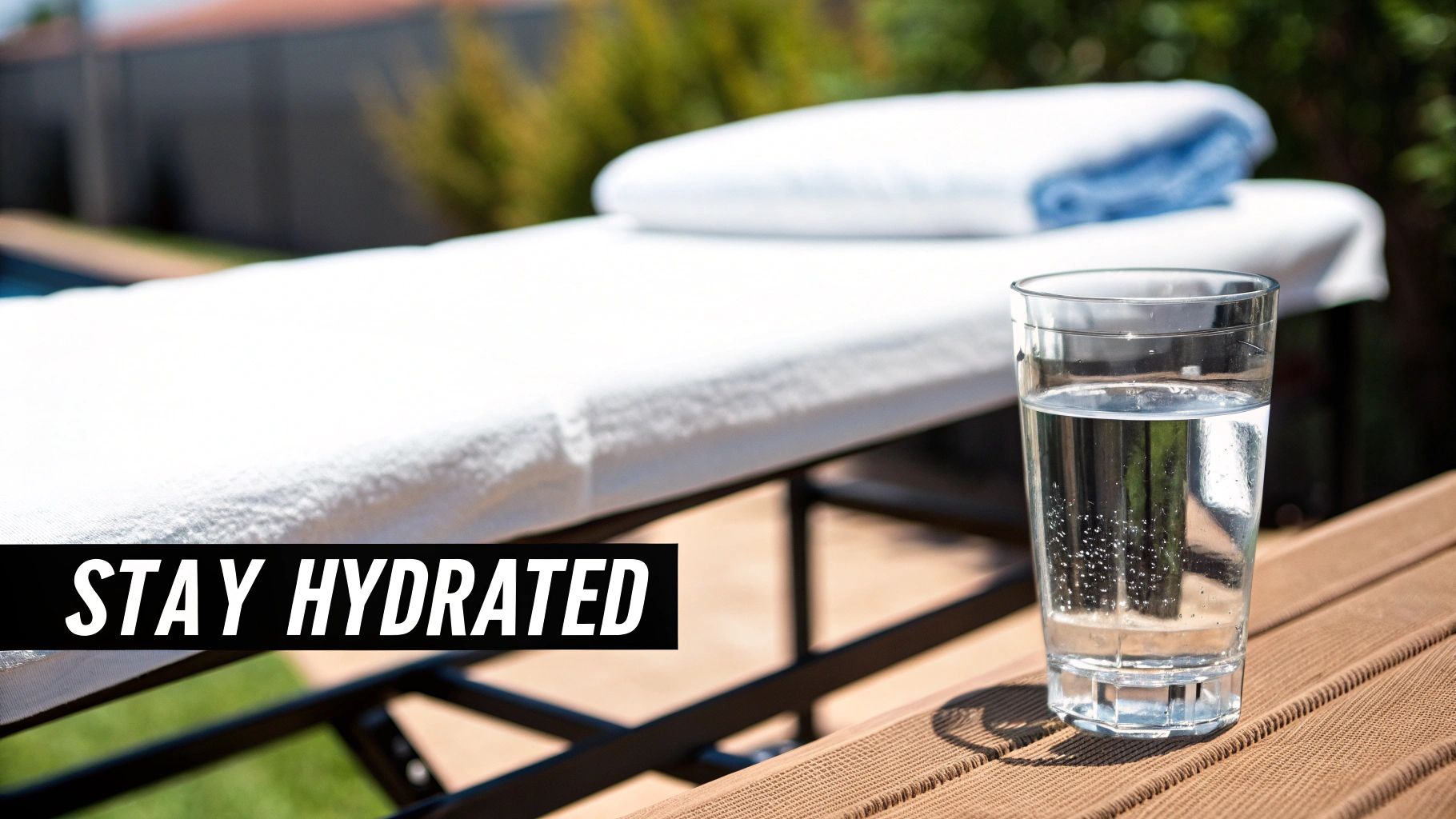
Why It Works and When to Do It
Hydration supports the kidneys and lymphatic system, the body's primary filtration and waste removal powerhouses. After a massage, especially an intense session for athletic recovery or chronic pain, these systems are working overtime. Providing them with ample water ensures they can transport and expel waste effectively, reducing inflammation and muscle ache.
This principle is so vital that it's a standard protocol in professional settings. Leading organizations like the American Massage Therapy Association (AMTA) emphasize its importance for client recovery. You will often see athletic recovery centers providing electrolyte-enhanced water after deep tissue work or medical massage clinics tracking patient hydration as part of a comprehensive treatment plan. The goal is to support the body’s natural detoxification process immediately when it's most active.
Actionable Hydration Tips
To make the most of your post massage care, apply these specific hydration strategies:
- Immediate Intake: Drink a large glass of water, about 16-20 ounces, within the first 30 minutes after your massage ends. This kickstarts the flushing process immediately.
- Sustained Hydration: Don't stop after the first glass. Continue to sip water steadily throughout the rest of the day to support your system over several hours.
- Add Electrolytes for Intensity: If you had a particularly deep or intense massage, such as sports massage, consider adding an electrolyte powder or tablet to your water. This helps replenish essential minerals like sodium and potassium lost through metabolic processes, which can prevent dehydration headaches.
- Monitor Your Progress: A simple way to check your hydration level is to monitor your urine color. Aim for a pale, straw-like yellow, which indicates you are well-hydrated.
2. Rest and Allow Recovery Time
Jumping back into a strenuous routine immediately after a massage can counteract its therapeutic effects. Effective post massage care requires you to give your body and nervous system a dedicated period to rest and integrate the work that was done. Think of it as allowing a complex machine to recalibrate after a major tune-up. Your muscles have been stretched and manipulated, and your nervous system has shifted from a state of stress to one of relaxation. Rest is the crucial final step that solidifies these positive changes.
This period of quiet allows your body to fully process the physiological shifts initiated by the massage, from improved circulation to the calming of sensory receptors. Without this downtime, you risk overstimulating your muscles and nervous system, which can lead to increased soreness or even re-tightening the very muscles you just paid to have released. Giving yourself permission to be still is not an indulgence; it's an essential component of maximizing the therapeutic investment you made in your health.
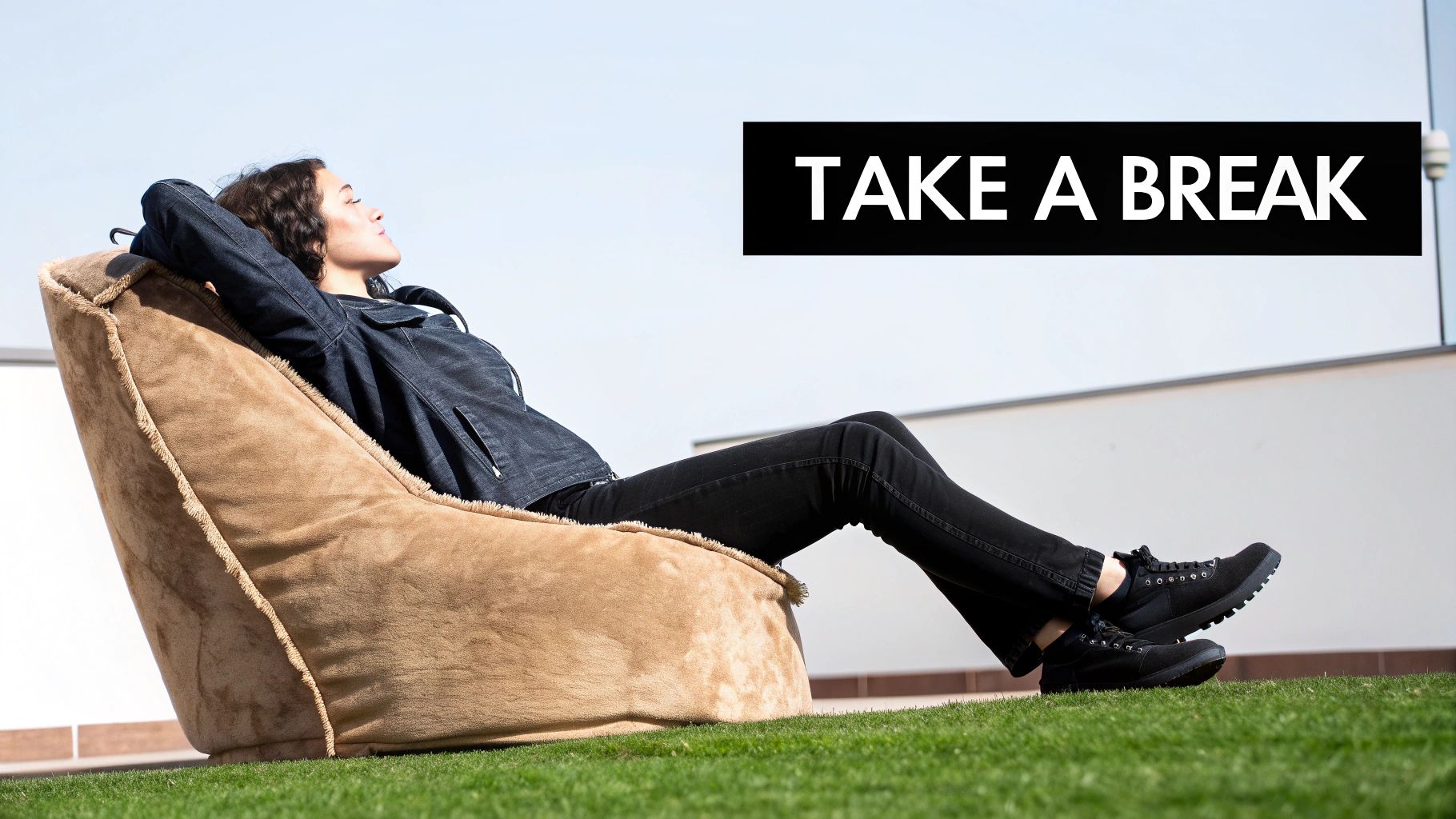
Why It Works and When to Do It
Resting after a massage allows your parasympathetic nervous system, often called the "rest and digest" system, to remain dominant. This state is optimal for muscle recovery, tissue repair, and reducing inflammation. When you immediately engage in stressful or physically demanding activities, you trigger the "fight or flight" sympathetic nervous system, which can halt the recovery process and negate the massage's benefits.
This principle is widely endorsed by professionals. For instance, the International Association of Healthcare Practitioners emphasizes rest for somatic integration, while sports massage therapists universally include it in recovery protocols. Day spas often institutionalize this by creating relaxation rooms for post-treatment rest, and medical massage clinics may advise patients to modify work duties on the day of their session. The goal is to extend the state of deep relaxation for as long as possible to ensure the body absorbs the full benefits. For a deeper dive into recovery protocols, you can find valuable insights on muscle recovery tips at LaMoonDaySpa.com.
Actionable Rest and Recovery Tips
To properly incorporate rest into your post massage care routine, use these targeted strategies:
- Plan Ahead: Schedule your massage on a day with a light schedule or at a time when you have at least 2-4 hours of downtime afterward.
- Avoid Intense Activity: Refrain from strenuous exercise, heavy lifting, or high-stress situations for at least 12-24 hours. This gives your muscles time to recover without being strained.
- Embrace Gentle Movement: If you feel the need to move, opt for gentle, restorative activities. A slow walk, light stretching, or a mindful yoga session can complement the massage without overtaxing your body.
- Create a Calm Environment: Use your rest period to engage in calming activities. Listen to soothing music, meditate, read a book, or simply lie down in a quiet, comfortable space to let your body and mind unwind completely.
3. Take a Warm Bath or Shower
Extending the therapeutic benefits of your massage is a key part of effective post massage care, and a warm bath or shower is one of the most pleasant ways to do it. The gentle heat of the water helps to maintain the increased circulation stimulated during your session, which is vital for delivering oxygen and nutrients to your recently worked muscles. This continued blood flow helps to soothe any potential next-day soreness and deepens the state of relaxation you achieved on the massage table.
A warm soak acts as a gentle continuation of the therapy, allowing your muscles to remain pliable and relaxed rather than quickly tensing up again. This practice is rooted in hydrotherapy principles and is a staple in wellness cultures worldwide, from European spas to Japanese onsen traditions. It’s a simple yet powerful step to bridge the gap between your session and your return to daily activities, ensuring the benefits last as long as possible.
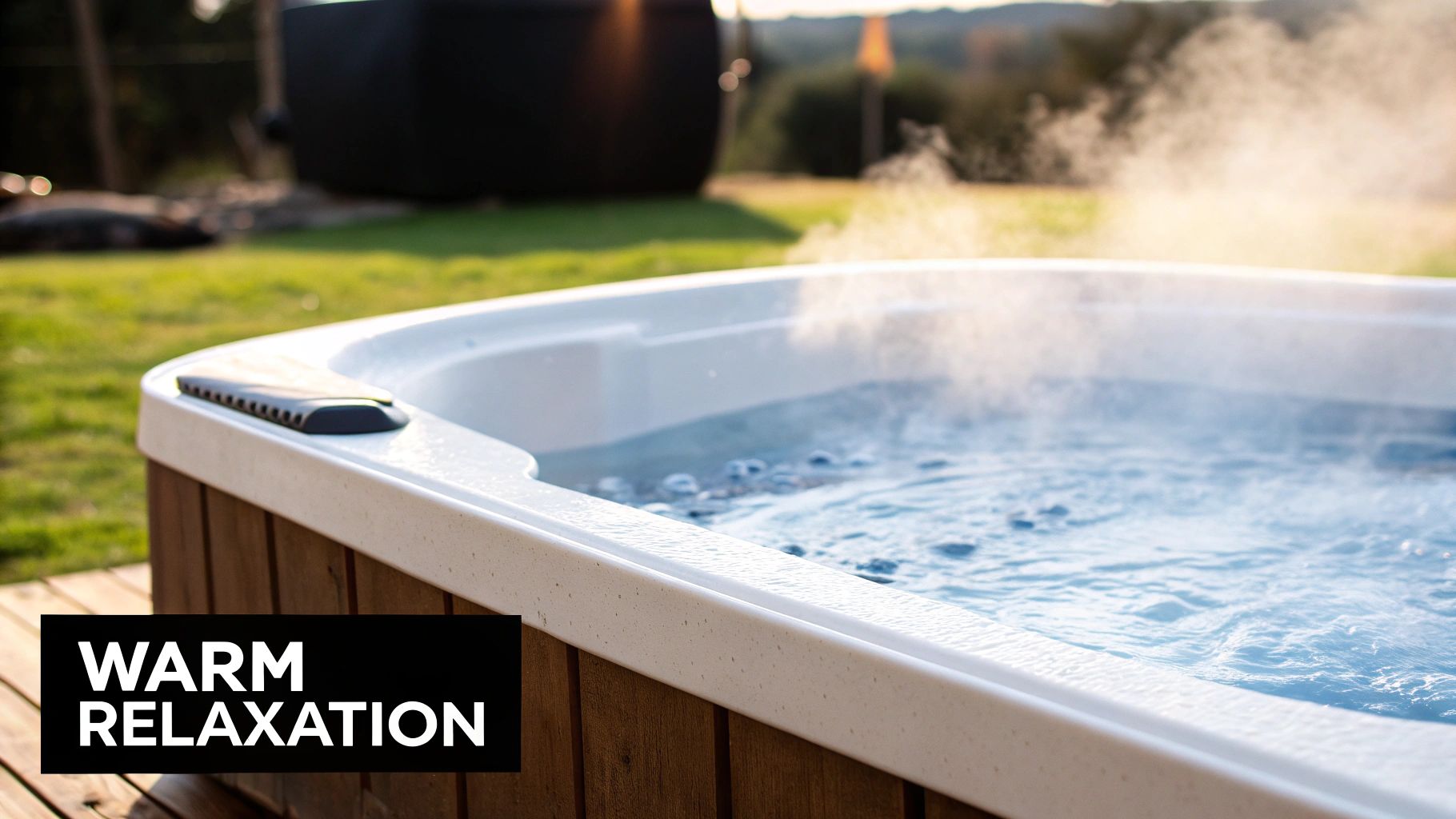
Why It Works and When to Do It
The primary mechanism behind a post-massage bath is heat's ability to promote vasodilation, or the widening of blood vessels. This effect complements the massage by keeping the circulatory and lymphatic systems active, aiding in the removal of metabolic byproducts that can cause muscle stiffness. For athletes or those with chronic aches, this can be particularly beneficial for reducing inflammation and accelerating recovery.
However, timing is crucial. It is generally recommended to wait at least two to four hours after your massage before bathing. This allows your body time to process the initial physiological changes from the session. It also gives any therapeutic oils or lotions used during the treatment time to fully absorb into your skin; many of which have their own anti-inflammatory and relaxing properties. For a deeper understanding of how different oils contribute to this process, you can learn more about massage oils for relaxation.
Actionable Bathing Tips
To turn your bath or shower into a therapeutic extension of your massage, follow these specific strategies:
- Wait for the Right Time: Allow a minimum of two hours to pass after your session before stepping into the tub or shower to maximize the benefits of any applied products.
- Mind the Temperature: Keep the water warm, not hot. The ideal temperature range is between 98-102°F (36-39°C). Water that is too hot can be dehydrating and may cause lightheadedness.
- Enhance with Epsom Salts: Add one to two cups of Epsom salt (magnesium sulfate) to your bath. Magnesium is a natural muscle relaxant that can be absorbed through the skin, helping to further ease soreness and tension.
- Keep it Brief: Limit your soak to 15-20 minutes. Prolonged exposure to warm water can start to strip your skin of natural oils and lead to dehydration.
- Stay Hydrated: Just like after the massage itself, drink a glass of water before and after your bath to stay properly hydrated.
4. Eat Light and Nutritious Foods
After a massage, your body's energy is channeled toward processing the therapeutic work done on your muscles and tissues. Consuming a heavy, greasy, or highly processed meal forces your digestive system to work overtime, diverting that crucial energy away from recovery. Proper post massage care involves choosing foods that support your body's healing state, not burden it.
Light, nutrient-dense foods provide the building blocks for muscle repair without causing digestive stress or sluggishness. Think of it as providing clean fuel for a finely tuned engine. Just as you wouldn't put low-grade fuel in a high-performance car after a tune-up, you shouldn't weigh your body down with difficult-to-digest food after a massage. This nutritional strategy helps you feel light and energized, enhancing the restorative effects of your session.
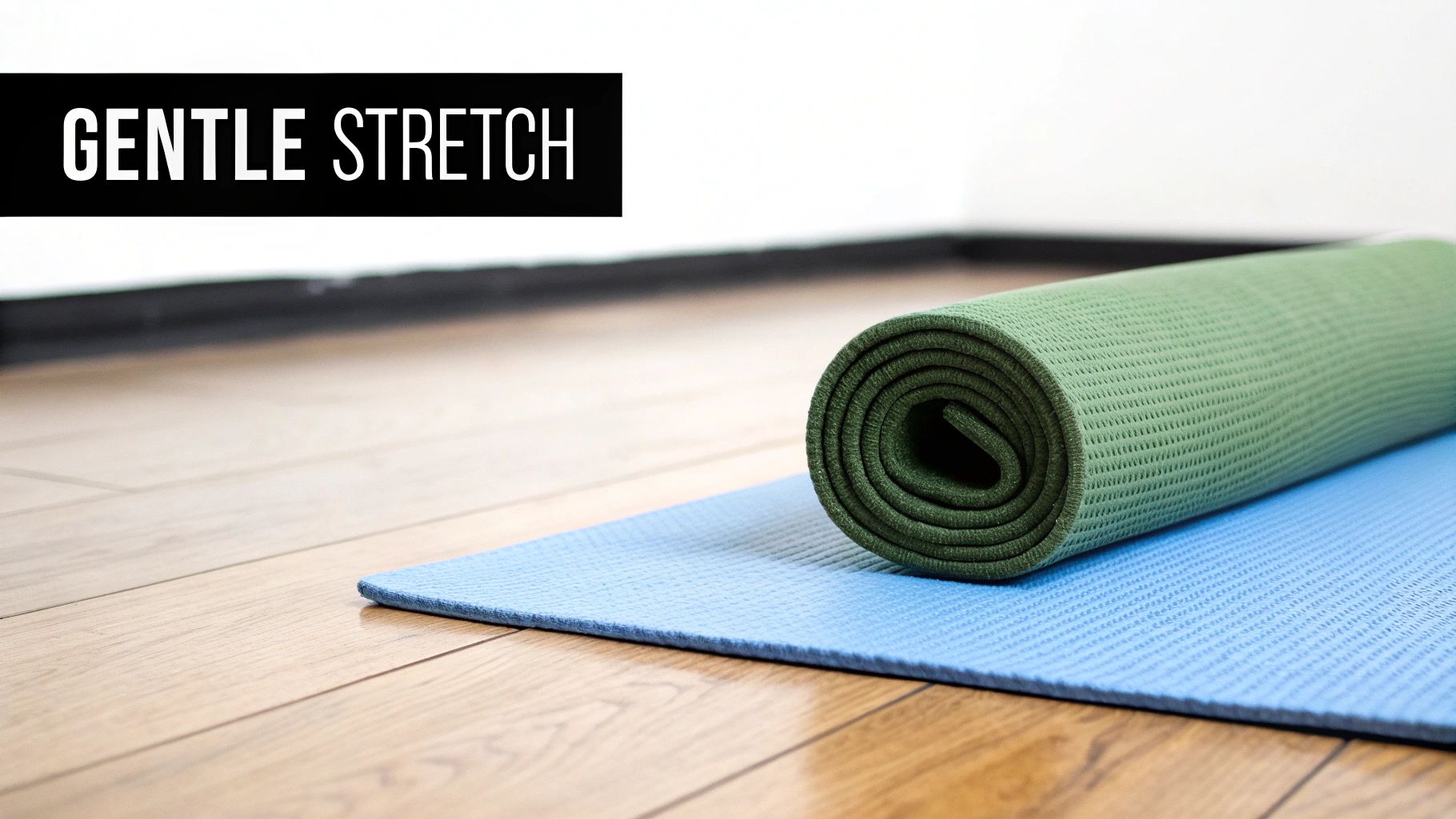
Why It Works and When to Do It
Your circulatory and lymphatic systems are highly active after a massage, working to clear metabolic byproducts. Heavy foods require significant blood flow to the digestive tract, pulling it away from the muscles and tissues that need it for recovery. Light, easily digestible meals allow your body to continue focusing its resources on repairing muscle tissue, reducing inflammation, and flushing out waste.
This principle is widely endorsed by integrative medicine practitioners and wellness nutrition experts. Many high-end spas and wellness retreats curate specific post-treatment menus featuring light salads, brothy soups, and lean proteins for this exact reason. The goal is to complement the physical therapy with nutritional support, creating a holistic recovery experience and ensuring clients leave feeling rejuvenated, not bloated or lethargic. This is a key component of a comprehensive post massage care plan.
Actionable Nutrition Tips
To properly fuel your recovery without overloading your system, apply these post-massage eating strategies:
- Wait Before You Eat: Give your body 60-90 minutes after your session before having a meal. This allows your system to begin its rebalancing process without the immediate demand of digestion.
- Focus on Anti-Inflammatory Foods: Actively support your body's healing by choosing foods known to reduce inflammation. Excellent choices include berries, leafy greens like spinach and kale, turmeric, ginger, and healthy fats from avocado or nuts.
- Prioritize Lean Protein and Veggies: A small portion of grilled chicken, fish, or tofu paired with steamed or raw vegetables provides essential amino acids for muscle repair and vitamins for overall function. A simple salad or a light soup is an ideal choice.
- Avoid Heavy or Processed Items: Steer clear of fried foods, red meat, refined sugars, and excessive dairy immediately following your massage. These foods can promote inflammation and make you feel sluggish, counteracting the benefits of your treatment.
5. Gentle Movement and Stretching
While it may be tempting to remain completely still after a massage, incorporating light movement and stretching is a vital step in your post massage care routine. A massage works to lengthen and relax muscle fibers, increasing your range of motion and flexibility. Gentle movement helps your body acclimate to this newfound freedom, preventing the muscles from tightening up again and causing stiffness. It essentially helps "lock in" the benefits of the session.
This approach encourages continued circulation, delivering oxygen-rich blood to the tissues that were just worked on. It also supports the lymphatic system in clearing out any residual metabolic waste released during the therapy. Think of it as gently reminding your muscles of their new, more relaxed state. This proactive step helps you integrate the therapeutic work, ensuring the suppleness and relief you feel on the table lasts for days, not just hours.
Why It Works and When to Do It
Gentle movement prevents the body from reverting to its old patterns of tension. Physical therapists and sports medicine professionals often prescribe specific stretches and light exercises after manual therapy to re-educate the neuromuscular system. By actively moving through a greater range of motion, you reinforce the positive changes achieved during the massage, which is especially important for addressing chronic pain or stubborn muscle knots. For an even deeper understanding of this process, you can find more information about releasing persistent tension in our detailed guide on how to get rid of muscle knots.
This practice is so effective that many wellness centers and yoga studios now offer post-massage gentle movement classes. The ideal time to start is within a few hours of your session, once you've had some time to hydrate and rest. The goal is not to perform a strenuous workout but to move with intention, focusing on fluidity and ease to prevent soreness and maintain flexibility.
Actionable Movement Tips
To properly integrate movement into your post massage care, follow these specific strategies:
- Start with a Walk: Engage in a slow, gentle walk for 10-15 minutes later in the day. This is a simple, low-impact way to encourage full-body circulation.
- Target Key Areas: Perform light, static stretches for the areas that received the most focus during your massage. If your therapist worked on your shoulders, do gentle shoulder rolls and cross-body arm stretches.
- Hold, Don't Bounce: Hold each stretch for 15-30 seconds without bouncing. This allows the muscle fibers to relax and lengthen safely.
- Listen to Your Body: The guiding principle is to avoid pain. The movement should feel good and restorative. If you feel any sharp or significant discomfort, stop immediately. Your body has just undergone therapy, so be gentle with it.
6. Avoid Alcohol and Stimulants
While it might seem tempting to follow a relaxing massage with a celebratory glass of wine or a cup of coffee to re-energize, this is one of the most counterproductive things you can do for your post massage care. Alcohol and stimulants like caffeine directly oppose the therapeutic goals of your session. A massage is designed to hydrate tissues, calm the nervous system, and flush out metabolic waste; alcohol and caffeine are diuretics that dehydrate the body and stimulants that can re-introduce tension.
Consuming these substances essentially asks your body to do two conflicting things at once. Your system is working hard to process the effects of the massage and enter a state of deep recovery, but alcohol and caffeine force it to metabolize toxins and elevate your heart rate. This interference can negate the benefits you just invested in, leading to dehydration, increased soreness, and a disrupted sense of calm. Steering clear of them is crucial for allowing the body to fully absorb the positive effects of the therapy.
Why It Works and When to Do It
Alcohol is a diuretic that can severely dehydrate you, directly undermining the hydration efforts that are so critical after a massage. It also acts as a depressant on the central nervous system, which may initially feel relaxing but ultimately interferes with the body's natural healing rhythm. Caffeine, a powerful stimulant, can cause muscles to tense up and may increase feelings of jitteriness, undoing the deep relaxation you achieved on the table.
This advice is a standard protocol across the wellness industry. Most reputable spas and medical massage clinics have policies advising clients to avoid alcohol post-treatment. For instance, wellness centers focused on detoxification or holistic health often provide educational materials explaining how these substances disrupt the body's equilibrium. Avoiding them immediately after your session allows your body to remain in a parasympathetic (rest and digest) state, which is optimal for tissue repair and recovery.
Actionable Avoidance Tips
To ensure your massage benefits are fully realized, incorporate these specific strategies:
- Set a 24-Hour Rule: Forgo alcoholic beverages for at least 24 hours after your massage. This gives your liver and kidneys ample time to process metabolic waste from your muscles without the added burden of metabolizing alcohol.
- Limit Caffeine for the Day: Avoid coffee, caffeinated sodas, and energy drinks for the remainder of the day. This prevents overstimulation of the nervous system and helps you maintain a relaxed state.
- Opt for Calming Alternatives: If you crave a warm beverage, choose decaffeinated herbal teas like chamomile, peppermint, or ginger. These can aid digestion and enhance relaxation, complementing the effects of your massage.
- Plan Your Sessions Strategically: If you know you have a social event involving alcohol, schedule your massage for a different day. Planning ahead ensures you won't have to choose between your recovery and your social life.
Post-Massage Care: 6 Key Practices Compared
| Post-Massage Care | Implementation Complexity 🔄 | Resource Requirements ⚡ | Expected Outcomes 📊 | Ideal Use Cases 💡 | Key Advantages ⭐ |
|---|---|---|---|---|---|
| Hydrate Immediately and Continuously | Low – simple habit change | Minimal – water or electrolyte drinks | Supports detox, prevents headaches, maintains tissue elasticity | All massage clients, athletes, recovery settings | Simple, immediate effects, enhances massage benefits |
| Rest and Allow Recovery Time | Moderate – requires scheduling and time | Low – quiet space or relaxation area | Nervous system integration, muscle recovery, stress regulation | Clients with flexible schedules, sports massage, medical massage | Maximizes benefits, supports natural healing |
| Take a Warm Bath or Shower | Low – easy home/self-care activity | Low – access to bath/shower | Continued relaxation, circulation, soreness management | Home care, spa environments, wellness routines | Extends massage benefits, accessible and relaxing |
| Eat Light and Nutritious Foods | Moderate – requires meal planning | Moderate – nutritious food | Supports energy restoration, tissue repair, digestive comfort | Wellness-focused clients, retreats, nutrition plans | Supports recovery, maintains energy, prevents discomfort |
| Gentle Movement and Stretching | Moderate – needs technique knowledge | Minimal – space for light activity | Maintains flexibility, circulation, prevents stiffness | Yoga, PT clinics, active individuals | Extends benefits, improves range of motion |
| Avoid Alcohol and Stimulants | Low to Moderate – lifestyle adjustment | None | Preserves relaxation, prevents dehydration, supports healing | All clients, especially regular consumers of alcohol/caffeine | Maximizes effectiveness, supports detox and relaxation |
Integrating Post-Massage Care into Your Wellness Routine
The time you spend on the massage table is a powerful investment in your physical and mental well-being. However, the true value of that investment is realized in the hours and days that follow. Treating your post-massage period with intention is the key to transforming a temporary relief into a lasting state of recovery and balance. By embracing a structured approach to your aftercare, you are not just passively receiving benefits; you are actively participating in and amplifying your body's healing process.
From Checklist to Ritual
We've explored six foundational pillars of effective post massage care: immediate hydration, dedicated rest, gentle warming with a bath or shower, light nutrition, mindful movement, and avoiding taxing substances like alcohol. While each of these actions is simple on its own, their collective power is immense. Think of them less as a checklist of chores and more as a cohesive ritual that honors the work your body and your therapist have just accomplished.
- Hydration flushes out metabolic waste released from your muscles.
- Rest gives your nervous system time to recalibrate and your tissues time to repair.
- Nourishment provides the essential building blocks for cellular recovery without overburdening your digestive system.
- Gentle Movement prevents stiffness and encourages healthy circulation, delivering oxygen-rich blood to worked muscles.
Mastering this sequence ensures that the benefits of your session, from decreased soreness to enhanced flexibility and mental clarity, extend far beyond the massage room.
A Holistic Approach to Recovery
Integrating effective aftercare into your routine is about adopting a more holistic view of wellness. It's understanding that what you do after the main event is just as critical as the event itself. This principle extends beyond massage. For instance, just as you carefully choose what to put in your body after a massage, exploring other natural wellness practices can further enhance your results. To further support your well-being, exploring how other natural elements can be integrated into your routine can be beneficial; consider resources like those discussing the unexpected uses for olive oil, including skincare applications, which can complement your recovery process.
Ultimately, your commitment to post massage care elevates a massage from a simple luxury to a cornerstone of your health strategy. It’s a profound act of self-respect that tells your body you are listening to its needs. By planning for this recovery time, you ensure every session delivers maximum, long-lasting impact, helping you feel stronger, more mobile, and deeply restored.
Ready to experience the profound benefits of a professional massage and put your new aftercare knowledge to the test? The expert therapists at La Moon Massage and Facial are dedicated to creating a personalized session that addresses your unique needs. Book your next appointment at La Moon Massage and Facial and take the first step toward integrating expert bodywork and mindful recovery into your life.
7 Best Massage Oils for Relaxation in 2025: A Guide
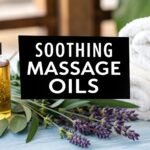
In the search for effective muscle recovery and deep relaxation, the right massage oil is a crucial component. Whether you're an athlete dealing with post-workout soreness or simply someone looking to unwind a tense body, selecting the ideal product can significantly enhance your experience. The challenge, however, is navigating the vast market to find high-quality, effective massage oils for relaxation that genuinely deliver on their promises. This guide simplifies that process by presenting a curated roundup of the best places to find them.
We've compiled a list of top-tier websites and brands, each offering unique formulations designed to soothe aching muscles and calm the mind. For every option, we provide a detailed breakdown of what makes their oils stand out, along with direct links and screenshots to streamline your search. This article cuts through the noise, giving you actionable insights to help you choose the perfect oil for your specific relaxation and recovery needs. While exploring various massage oils, it's worth noting that other products, such as a soothing Lavender Blossom Cream, also offer excellent relaxation benefits for the skin. Our goal is to equip you with all the information needed to make a confident and informed decision.
1. Amazon
When starting your search for the perfect massage oils for relaxation, Amazon stands as a comprehensive, one-stop marketplace. Its sheer volume of options is unparalleled, offering everything from single-ingredient oils like jojoba and sweet almond to complex, professionally blended aromatherapy formulas designed specifically to soothe the mind and body. This vast selection ensures you can find a product that aligns with your specific needs, whether you're an athlete managing muscle soreness or simply seeking a tranquil escape from daily stress.
The platform's primary advantage is its user-driven ecosystem. Before committing to a purchase, you can delve into hundreds or even thousands of customer reviews and ratings for a single product. This unfiltered feedback provides invaluable, real-world insights into an oil's texture, scent, and effectiveness for relaxation, helping you make a more informed decision.
Maximizing Your Amazon Experience
To navigate the extensive catalog effectively, use the robust filtering tools. You can narrow your search by:
- Key Ingredients: Filter for specific oils like lavender, chamomile, or ylang-ylang.
- Customer Rating: Set the filter to show only products with 4-star ratings and above.
- Brand: If you have a preferred brand, you can shop their entire collection.
- Price: Set a budget to avoid overspending.
Pro-Tip: Pay close attention to the "Sold by" and "Shipped by" information. Purchasing products sold directly by Amazon or the official brand storefront often ensures authenticity and quality. Also, read recent reviews, as product formulations can sometimes change.
Key Platform Features
| Feature | Description |
|---|---|
| Product Variety | Extensive selection of massage oils from countless brands, including organic, vegan, and therapeutic-grade options. |
| Customer Reviews | User-generated ratings and detailed reviews offer practical insights into performance and scent. |
| Pricing | Competitive pricing with frequent sales, "Subscribe & Save" discounts, and Lightning Deals. |
| Shipping | Amazon Prime members benefit from fast, often free, shipping, ensuring you get your relaxation oil quickly. |
While the sheer number of choices can feel overwhelming, Amazon's powerful search filters and wealth of customer feedback make it an indispensable resource for finding high-quality massage oils for relaxation tailored to any preference or budget.
Website: https://www.amazon.com
2. VedaOils USA
For those who prioritize purity and natural ingredients in their search for relaxation, VedaOils USA is a standout destination. This specialized retailer focuses exclusively on 100% pure and natural essential oils and carrier oils, making it an ideal choice for discerning consumers and professionals. Their curated collection is specifically geared towards therapeutic benefits, offering potent formulations for stress relief, muscle relaxation, and deep skin nourishment.
The platform's main strength lies in its commitment to quality and transparency. Each product page provides in-depth information on the oil's origin, extraction method, and key therapeutic properties. This educational approach empowers you to select the best massage oils for relaxation based on specific needs, whether you're targeting muscle soreness after a workout or seeking a calming aroma to aid sleep. VedaOils also caters to bulk purchasers, offering significant savings for therapists or frequent users.
Maximizing Your VedaOils Experience
To find the perfect product, leverage the site’s detailed categorization. You can explore oils based on their intended benefits.
- Shop by Benefit: Directly navigate to sections for pain relief, stress reduction, or skin health.
- Explore Carrier Oils: Browse their extensive selection of base oils like jojoba, fractionated coconut, or grapeseed to create your own custom blends.
- Check DIY Blogs: The site offers recipes and guides for creating personalized massage oil formulas.
- Consider Bulk Sizes: If you’ve found an oil you love, purchasing a larger size offers excellent value.
Pro-Tip: Pay attention to the "Certificate of Analysis" (COA) available for many products. This document verifies the oil's purity and composition, giving you extra confidence in its quality. Also, consider their blended massage oils if you're new to aromatherapy and want a professionally formulated product ready for use.
Key Platform Features
| Feature | Description |
|---|---|
| Product Purity | Specializes in 100% pure, natural, and often organic oils with a strong focus on therapeutic-grade quality. |
| Detailed Information | Extensive product descriptions outline benefits, ingredients, and suggested uses for targeted relaxation. |
| Bulk Pricing | Offers wholesale and bulk purchasing options, making it cost-effective for professionals and enthusiasts. |
| Specialized Selection | Curated collections for specific needs like pain relief, romance, and stress reduction simplify the shopping process. |
While it may lack the massive volume of user reviews seen on larger marketplaces, VedaOils USA compensates with its unwavering focus on high-quality, natural products, making it a trusted source for anyone serious about the therapeutic benefits of massage oils for relaxation.
Website: https://www.vedaoils.com
3. Plant Therapy
For those who prioritize purity and education alongside relaxation, Plant Therapy is a premier destination. This company specializes in high-quality, 100% pure essential oils and expertly crafted blends. Their focus on transparency and quality assurance means you can be confident you are purchasing potent and effective massage oils for relaxation, free from additives or synthetic fragrances. This makes it an ideal choice for aromatherapy enthusiasts and anyone seeking therapeutic benefits from their massage.
The platform’s standout feature is its dedication to customer education. Unlike larger marketplaces, Plant Therapy provides extensive information on each oil, including its origin, aroma profile, and safe usage guidelines. This educational approach empowers you to not only select the right oil but also to understand its properties, creating a more intentional and effective relaxation experience. For those interested in the deeper benefits, understanding these properties is key to what makes a therapeutic massage so effective.
Maximizing Your Plant Therapy Experience
To make the most of the site, explore their pre-formulated massage blends and carrier oils.
- Shop by Concern: Use their categories like "Relax," "Sleep," or "Muscle & Joint" to find blends targeted for your specific needs.
- Explore Carrier Oils: Don't forget their extensive selection of carrier oils like Fractionated Coconut Oil or Jojoba Oil to create your own custom massage blends.
- Read the Blog: Their blog is a rich resource for DIY recipes and learning more about how different essential oils work.
- Check Lab Reports: Look for the GC/MS test reports available for each essential oil batch to verify its purity and composition.
Pro-Tip: Sign up for their rewards program, "PT Perqs," to earn points on purchases that can be redeemed for discounts. Also, check their "Safe Essential Oil Recipes" (SEOR) group on Facebook for community-driven ideas and support.
Key Platform Features
| Feature | Description |
|---|---|
| Purity & Quality | Rigorous third-party testing (GC/MS) on every batch of essential oil ensures purity and therapeutic quality. |
| Educational Resources | Detailed product pages, a comprehensive blog, and certified aromatherapists on staff to answer questions. |
| Product Selection | Wide range of single essential oils, carrier oils, and specialized blends like "Relax" and "Tranquil." |
| Customer-Friendly Policies | Free U.S. shipping on all orders over $75 and a generous 90-day return policy provide a risk-free shopping experience. |
While some products may have a higher price point than mass-market alternatives, Plant Therapy’s unwavering commitment to quality, transparency, and education makes it a trusted source for anyone serious about using authentic and effective massage oils for relaxation.
Website: https://www.planttherapy.com
4. West Coast Aromatics
For those who prioritize ingredient purity and professional-grade quality, West Coast Aromatics is a specialized supplier that caters to both seasoned massage therapists and at-home relaxation enthusiasts. The platform distinguishes itself by focusing on high-quality, natural ingredients, offering a curated selection of oils that eschew unnecessary additives in favor of effective, plant-based formulations. This commitment to quality makes it a trusted source for finding potent massage oils for relaxation.
The primary appeal of West Coast Aromatics lies in its balance of professional-grade products and user-friendly accessibility. Whether you need an unscented base oil for sensitive skin or a pre-blended aromatic formula to target stress relief, their catalog is thoughtfully assembled. Their standout 60-day money-back guarantee provides a significant layer of confidence, allowing you to try a product and ensure it meets your relaxation needs without financial risk.
Maximizing Your West Coast Aromatics Experience
To make the most of this specialized platform, focus on the product descriptions and intended uses. Since the selection is more curated than on massive marketplaces, each product has a specific purpose.
- Identify Your Need: Are you looking for a deeply moisturizing oil or a light, fast-absorbing one? Consider options like their Sweet Almond Oil for general use or explore their specialty blends.
- Read the Ingredients: Take time to review the simple, transparent ingredient lists to understand exactly what you are applying to your skin.
- Leverage the Guarantee: Don't hesitate to take advantage of the 60-day money-back guarantee if a product isn't the right fit for your relaxation routine.
Pro-Tip: If you are new to massage oils, start with one of their unscented base oils. This allows you to experience the texture and absorption rate first. You can later add your own essential oils to customize the scent and therapeutic benefits.
Key Platform Features
| Feature | Description |
|---|---|
| Product Quality | Strong emphasis on high-quality, natural ingredients suitable for professional massage techniques and personal relaxation. |
| Curated Selection | Offers a focused range of massage oils, including unscented base oils and carefully crafted scented blends. |
| Return Policy | A generous 60-day money-back guarantee allows for a risk-free purchase, reflecting confidence in their products. |
| User Base | Trusted by both professional therapists and individuals seeking reliable, effective massage products for home use. |
While its product range is more limited than that of large-scale retailers, West Coast Aromatics excels in quality and customer assurance, making it a top choice for anyone seeking pure and effective massage oils for relaxation.
Website: https://www.westcoastaromatics.com
5. SheaMoisture
For those who prioritize ethically sourced, natural ingredients in their wellness routines, SheaMoisture offers a thoughtfully curated selection of body and massage oils. While not a massive marketplace, its strength lies in its commitment to high-quality, nourishing formulas rooted in generations of family tradition. The brand excels at creating products that do more than just facilitate a massage; they deeply hydrate and care for the skin using ingredients like certified organic Shea Butter, Coconut Oil, and African Black Soap.
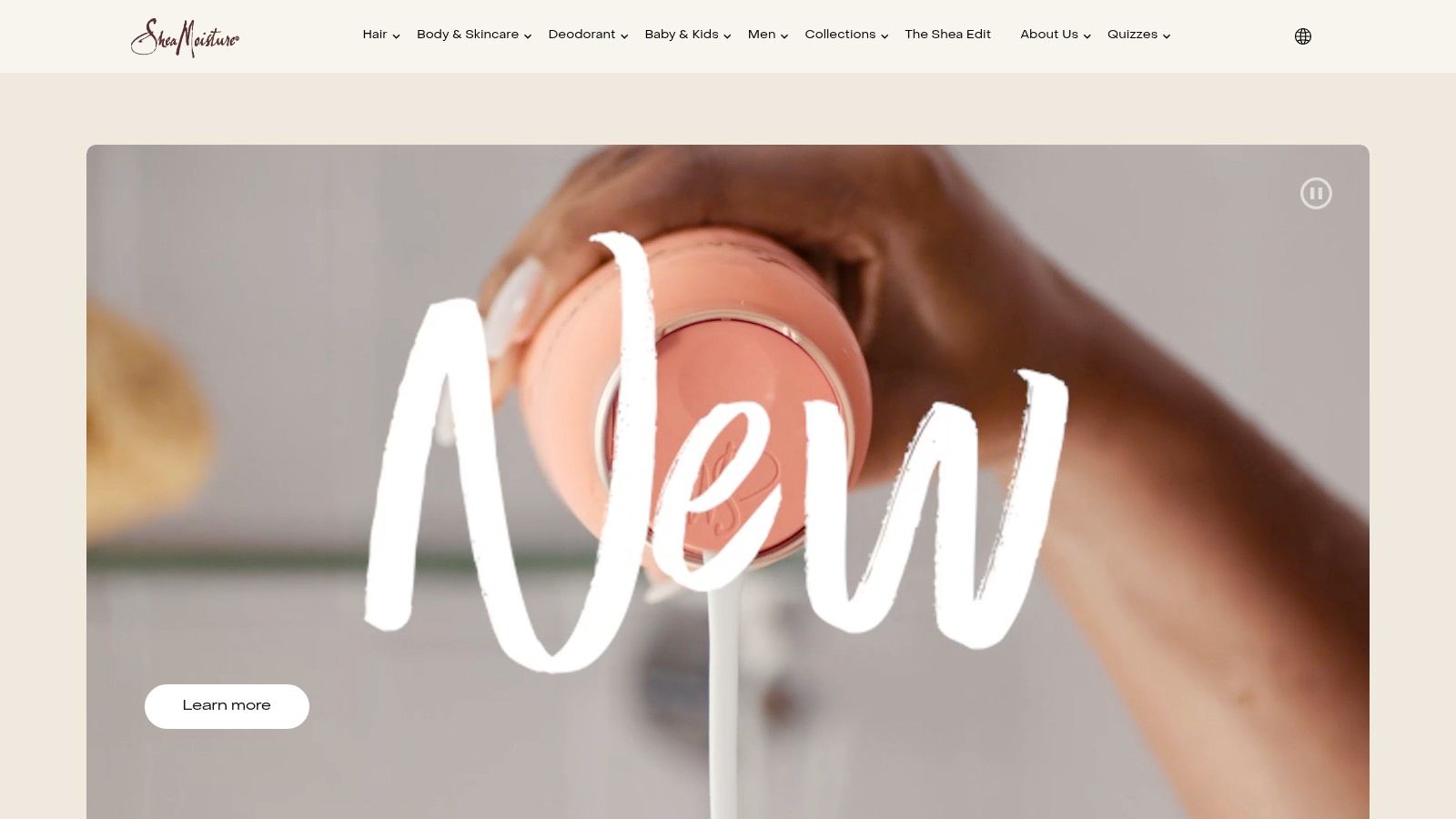
The primary appeal of SheaMoisture is the trust and transparency it has built. Their website provides detailed ingredient lists and background on their Community Commerce model, so you know your purchase supports a greater mission. This focus on natural wellness makes their oils a reliable choice for achieving a state of calm, especially when dealing with muscle tension. For targeted relief, combining their products with specific massage techniques can be particularly effective; for instance, you can learn more about how to relax tight shoulder muscles to enhance your experience.
Maximizing Your SheaMoisture Experience
Navigating the SheaMoisture website is straightforward, but a few tips can help you find the perfect product for your relaxation needs.
- Explore by Ingredient: Use the "Shop by Ingredient" feature to find oils with specific benefits, such as calming lavender or hydrating coconut.
- Filter by Collection: Their collections are often designed for specific concerns, like the "Coconut & Hibiscus" line for hydration or "African Black Soap" for soothing properties.
- Read Product Details: Pay close attention to the "Key Ingredients" and "Usage" sections on each product page to ensure the scent profile and benefits match your relaxation goals.
- Use the Store Locator: Since SheaMoisture is widely available, use the store locator to see if you can find the product at a local retailer for immediate purchase.
Pro-Tip: While their official site is a great resource for information, compare prices with authorized retailers like Target, Walmart, or Ulta. You can often find sales or bundle deals that aren't available directly on the SheaMoisture website.
Key Platform Features
| Feature | Description |
|---|---|
| Natural Ingredients | Formulas are centered around certified organic shea butter and other natural, ethically sourced ingredients. Paraben-free and cruelty-free. |
| Skin Nourishment | Products are designed to be multi-purpose, providing deep skin hydration and nourishment alongside relaxation benefits. |
| Retail Availability | One of the most accessible brands on this list, found in major drugstores, supermarkets, and beauty retailers across the country. |
| Affordability | Offers high-quality, natural massage oils for relaxation at a very competitive and accessible price point. |
SheaMoisture stands out as a dependable, affordable, and ethically conscious choice. It's the ideal destination for anyone seeking effective massage oils for relaxation that also provide tangible skincare benefits without compromising on ingredient integrity.
Website: https://www.sheamoisture.com
6. L'Occitane
For those seeking a truly luxurious, spa-like experience at home, L'Occitane en Provence offers an exquisite selection of body and massage oils. Rooted in the traditions of Provence, France, this brand focuses on high-quality, natural ingredients and sophisticated aromatic blends. Their products are less about a vast catalog and more about a curated collection designed to transform a simple massage into a decadent, sensory ritual, making them a premier choice for premium massage oils for relaxation.
The brand's main appeal lies in its commitment to creating an indulgent atmosphere. From the elegant, gift-worthy packaging to the rich, non-greasy formulas that absorb beautifully into the skin, every detail is crafted for a feeling of opulence. This makes L'Occitane an excellent destination not only for personal use but also for finding a special gift for someone in need of pampering.

Maximizing Your L'Occitane Experience
While the selection is more focused, you can still refine your shopping experience to find the perfect product for your relaxation needs.
- Shop by Collection: Explore specific lines like "Almond" or "Shea Butter," each with a unique scent profile and set of benefits.
- Identify Your Need: Look for oils specifically labeled for "relaxing," "soothing," or "nourishing" to match your desired outcome.
- Visit a Store: If possible, visit a physical L'Occitane boutique to experience the textures and aromas firsthand before purchasing.
Pro-Tip: L'Occitane frequently offers gift sets, which can be a more cost-effective way to sample a massage oil along with other complementary products from the same collection. Also, sign up for their newsletter to receive notifications about special promotions and new arrivals.
Key Platform Features
| Feature | Description |
|---|---|
| Product Quality | Formulated with high-quality, natural ingredients like sweet almond oil and shea butter, sourced with a focus on sustainability. |
| Aromatic Scents | Sophisticated, perfumer-crafted fragrances designed to transport you to the fields of Provence and enhance relaxation. |
| User Experience | A clean, elegant website and the option to shop in beautifully designed physical stores for a tactile experience. |
| Gifting Options | Beautiful packaging and curated gift sets make these products ideal for special occasions. Creating a consistent self-care routine is important; consider reading about how often you should get a massage to complement your at-home rituals. |
While L'Occitane sits at a higher price point, the superior quality, enchanting scents, and luxurious feel provide a distinct and worthwhile investment for anyone serious about creating a truly relaxing massage experience.
Website: https://www.loccitane.com
7. Badger
For those who prioritize purity and ethical sourcing in their wellness products, Badger offers a refreshing and trustworthy destination. This family-owned company is built on a foundation of providing certified organic skincare, and their collection of massage oils for relaxation is a testament to that commitment. Badger’s oils are crafted for individuals who want to ensure what they put on their skin is as clean and natural as possible, making them an excellent choice for those with sensitive skin or a preference for non-toxic living.
The brand's philosophy centers on using only the finest USDA Certified Organic ingredients, completely avoiding synthetic chemicals, artificial fragrances, parabens, and GMOs. This dedication to purity means you can feel confident in the quality and safety of their massage oils, whether you're using them for post-workout muscle relief or a calming bedtime ritual.
Maximizing Your Badger Experience
The Badger website is clean and easy to navigate. To find the ideal oil for your needs, you can browse their dedicated "Body & Massage Oils" category. Consider these tips for a focused shopping experience:
- Identify Your Need: Are you looking for something soothing and calming, or invigorating and sore-muscle focused? Badger offers specific blends like "Sore Muscle Rub" and "Jojoba Body Oil."
- Read the Ingredients: Badger is transparent about its formulas. Take a moment to read the short, understandable ingredient lists to see exactly what you’re getting.
- Explore Beyond Oils: While shopping, check out their other complementary products like aromatherapy balms and body balms, which can enhance your overall relaxation routine.
Pro-Tip: Look for Badger’s "B Corp" certification on their site. This signifies a verified commitment to high standards of social and environmental performance, accountability, and transparency, adding another layer of trust to your purchase.
Key Platform Features
| Feature | Description |
|---|---|
| Certified Organic | All massage oils are USDA Certified Organic, ensuring they are free from harmful pesticides and chemicals. |
| Sensitive Skin Focus | Formulations are gentle and made without common irritants, making them suitable for most skin types. |
| Sustainability | As a certified B Corporation, the company is committed to environmentally friendly practices and ethical business operations. |
| Ingredient Purity | Products are free from synthetic fragrances, GMOs, parabens, and other artificial additives. |
While its product selection is more curated and smaller than massive online retailers, Badger excels by offering exceptionally high-quality, organic massage oils for relaxation. It is the ideal platform for the conscious consumer seeking effective, pure, and ethically produced wellness products.
Website: https://www.badgerbalm.com
Top 7 Massage Oils for Relaxation Comparison
| Brand | Implementation Complexity 🔄 | Resource Requirements ⚡ | Expected Outcomes 📊 | Ideal Use Cases 💡 | Key Advantages ⭐ |
|---|---|---|---|---|---|
| Amazon | Low – User-friendly platform, easy to navigate | Moderate – Internet access, selection overhead | Wide product variety and user ratings | Casual buyers seeking variety and deals | Extensive selection, customer reviews, discounts |
| VedaOils USA | Moderate – Focus on natural, detailed selection | Moderate – Bulk buying options for professionals | High-quality natural oils, therapeutic benefits | Professionals and frequent users | Pure natural ingredients, bulk pricing |
| Plant Therapy | Moderate – Includes educational resources | Moderate – Investing time to learn and choose | High-quality essential oils and blends | Aromatherapy enthusiasts and DIY projects | Quality assurance, educational content |
| West Coast Aromatics | Low – Straightforward selection | Low to Moderate – Limited range, easy purchase | Reliable natural oils with satisfaction guarantee | Professionals and personal users needing quality | Money-back guarantee, quality natural oils |
| SheaMoisture | Low – Easily accessible in stores and online | Low – Affordable, widely available | Effective, natural, and skin-friendly oils | Budget-conscious users and general wellness | Affordable, natural sourcing, retail presence |
| L'Occitane | Moderate – Luxurious presentation and formulas | Moderate to High – Premium pricing and packaging | Spa-like, aromatic experience | Gift-giving and upscale personal care | Luxurious scents, elegant packaging |
| Badger | Moderate – Organic certification standards | Moderate – Focus on sustainability and purity | Certified organic, skin-friendly oils | Environmentally conscious and sensitive skin | Organic certified, sustainable practices |
Final Thoughts on Finding Your Perfect Massage Oil for Relaxation
We've journeyed through a curated selection of exceptional massage oils, exploring everything from the vast, accessible marketplace of Amazon to specialized, artisan brands like West Coast Aromatics and L'Occitane. Each brand, whether it's the ethically sourced SheaMoisture, the pure and potent Plant Therapy, the all-natural Badger, or the wholesale-focused VedaOils USA, offers a unique pathway to tranquility and muscle relief. The key takeaway is that the ideal choice isn't about finding a single "best" oil, but about discovering the one that best aligns with your specific needs, whether you're an athlete managing soreness or someone simply seeking a moment of peace.
Actionable Steps to Your Ultimate Relaxation Routine
Choosing the right product is just the first step. To truly harness the power of massage oils for relaxation, you need to integrate them into a consistent wellness practice. Here’s how to translate your newfound knowledge into tangible results:
- Define Your Primary Goal: Are you targeting post-workout muscle soreness, seeking to calm your mind before sleep, or aiming to soothe dry, irritated skin? Your objective will guide your choice. For muscle recovery, an arnica-infused blend like Badger's Sore Muscle Rub is ideal. For pure mental calm, a lavender-rich oil from Plant Therapy or L'Occitane would be more effective.
- Consider Your Scent Preference: The aromatherapy component is crucial for relaxation. Do you find earthy scents like sandalwood grounding, or do floral notes like lavender and ylang-ylang calm you? Don't underestimate the power of fragrance in your relaxation journey.
- Patch Test and Personalize: Before committing to a full-body massage, always perform a patch test on a small area of skin to check for any adverse reactions. Feel free to customize your experience by adding a few extra drops of your favorite essential oil to a carrier oil for a personalized scent profile.
Integrating Massage with Holistic Wellness
Massage is a powerful tool, but its effects are amplified when combined with other wellness strategies. Building a comprehensive self-care routine can significantly deepen your sense of relaxation and combat the physical manifestations of stress. To further enhance your relaxation and overall well-being, consider integrating complementary therapies. Practices like mindfulness meditation, gentle stretching, and even professional treatments can create a synergistic effect. For those interested in exploring ancient, effective techniques, learning about acupuncture for stress management can offer profound insights into balancing your body's energy and relieving tension.
Ultimately, your journey into the world of massage oils for relaxation is a deeply personal one. Use this guide as your starting point, experiment with different formulations, and pay attention to how your body and mind respond. The perfect blend is out there waiting to transform your self-care ritual into a truly restorative experience.
Ready to experience the pinnacle of professional relaxation? Let the experts at La Moon Massage and Facial elevate your wellness journey with their specialized techniques and premium oils. Book your session today and discover how a professional touch can unlock a new level of tranquility.
Massage for Athletes: Boost Performance & Recovery
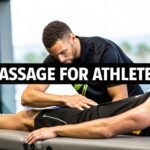
So, what’s the secret weapon in an elite athlete’s toolkit? It's not always the latest gear or some revolutionary training fad. Often, it's a dedicated commitment to massage therapy, a critical piece of the puzzle for boosting recovery, preventing injuries, and maintaining peak physical condition. Top-tier competitors don’t see it as an indulgence; they treat it as an essential strategy for a long, successful career and a serious competitive edge.
Why Elite Athletes Swear By Massage Therapy
Ever wonder how professional athletes manage to stay at the top of their game, season after season? It’s not just about talent or grueling practice sessions—it's about smart, calculated maintenance. For these competitors, their bodies are finely tuned engines, and targeted massage is the essential service that keeps them running at full power.
Think about it this way: every intense workout puts incredible stress on your muscles, leading to tiny tears, inflammation, and knots. If you let that build up, you’re paving the way for burnout, nagging pain, and the kind of injuries that can sideline you for good. This is precisely where a massage for athletes becomes an absolute necessity.
By proactively managing muscle health, athletes don't just bounce back faster—they build a more resilient, durable body. This shifts massage from being something you do after you're hurt to a powerful tool for building a long and successful career.
To give you a quick snapshot of what we'll cover, here are the core advantages that make massage a non-negotiable for serious athletes.
Key Benefits of Athletic Massage at a Glance
| Benefit | Impact on Athletic Performance |
|---|---|
| Faster Recovery | Reduces muscle soreness, allowing you to return to training sooner and with greater intensity. |
| Injury Prevention | Addresses muscle imbalances and tightness before they escalate into serious problems. |
| Enhanced Flexibility | Loosens tight muscles and connective tissues, improving your overall range of motion. |
| Improved Circulation | Increases blood flow to deliver more oxygen and nutrients to your hard-working muscles. |
| Psychological Boost | Eases pre-competition anxiety and improves focus, giving you a mental edge. |
Each of these benefits contributes to a stronger, more consistent athletic performance, which we'll explore in more detail.
A Competitive Edge Backed By Results
The real-world proof is undeniable when you look at athletes at the highest level of sport. In one study of elite soccer players during a demanding 35-day tournament, the athletes overwhelmingly reported that regular sports massage was vital for keeping up with the intense schedule and recovering between games. You can read more about these findings on scienceofmassage.com.
It's this mindset—treating massage as a performance tool—that truly separates the good from the great. It empowers athletes to:
- Train Harder and More Consistently: By cutting down on delayed onset muscle soreness (DOMS), you can get back to high-impact training much faster.
- Improve Mobility and Flexibility: Massage is fantastic for releasing tight fascia and working out stubborn knots, which directly translates to a better range of motion and more fluid movements.
- Reduce the Risk of Injury: It helps correct muscular imbalances before they become chronic issues, keeping your body aligned and ready to perform under pressure.
Adopting this professional approach is a game-changer. Once you fully grasp the link between muscle health and your athletic output, every massage session becomes a direct investment in your performance. You can explore our detailed guide to uncover all the benefits of sports massage. For elite athletes, it’s not just about feeling good—it’s about gaining a distinct physical and mental advantage over the competition.
How Massage Unlocks Better Athletic Performance
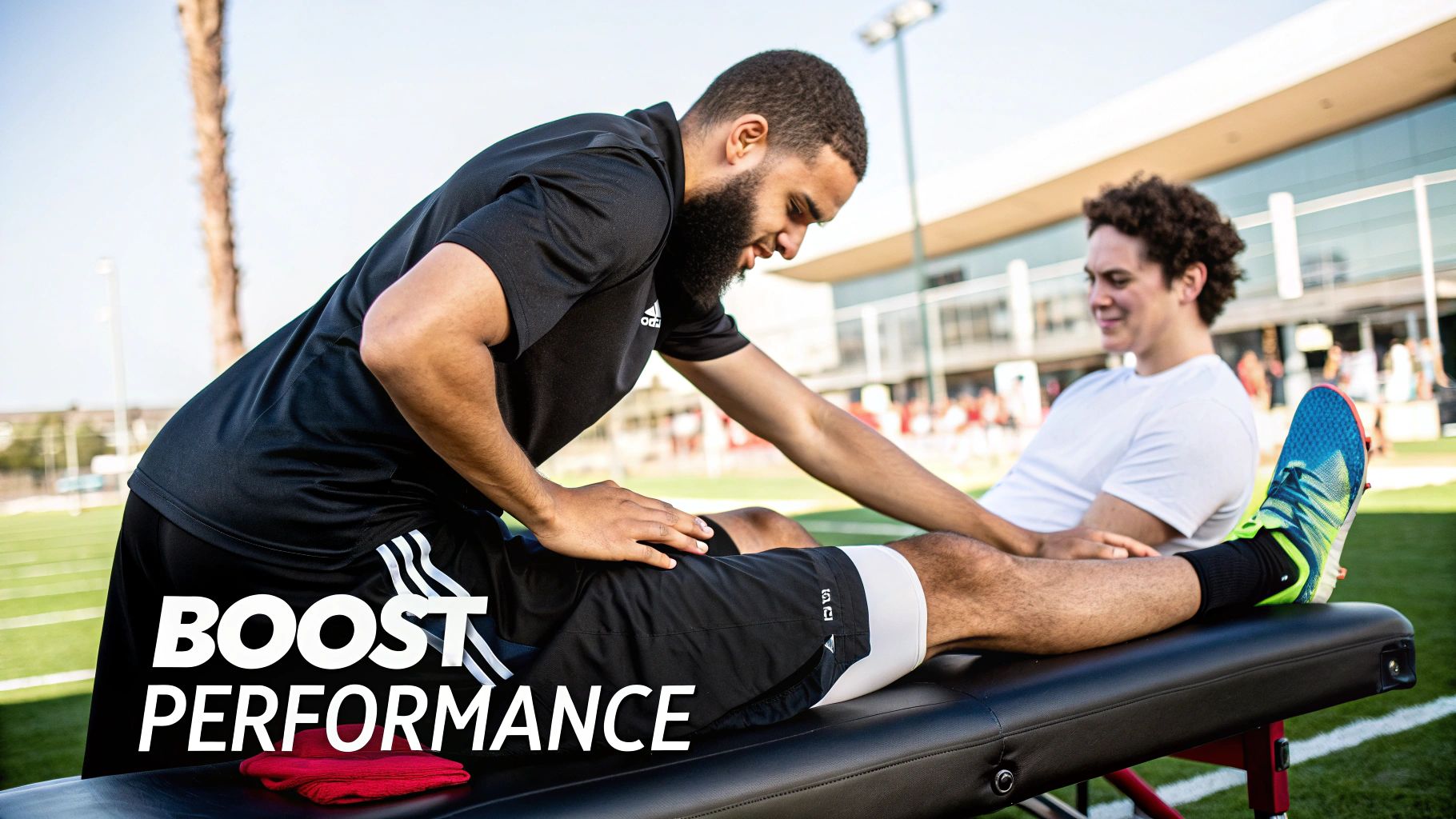
To really get why massage is so vital for athletes, we have to look beyond the "feel-good" factor and see what’s actually happening inside your body. It's not just about relaxation; it’s a powerful physiological tune-up that creates real, measurable gains on the field, court, or in the gym. Every session is an investment in your body's ability to perform and endure.
Think about a stubborn knot or a chronically tight muscle. It's a lot like a hopelessly tangled pair of headphone wires. When they’re knotted up, they can't do their job—they're constricted, short, and basically useless. In the same way, muscle knots and adhesions choke off your range of motion, limit your power, and block blood flow, creating a bottleneck that holds you back.
A great massage therapist acts like a master detangler. Through skilled pressure and specific techniques, they manually break down those adhesions, release the built-up tension, and help the muscle return to its proper, functional state. This is ground zero for unlocking your body's full potential.
Boosting Circulation and Flushing Out Waste
One of the first things you'll notice from a good massage is a major boost in circulation. As the therapist works on a muscle, the pressure physically pushes blood through congested areas, which then allows fresh, oxygen-rich blood to flood in. This isn't just a fleeting sensation; it has a huge impact on your recovery.
After a hard workout, your muscles are loaded with metabolic byproducts like lactic acid. This is a big reason you feel that familiar ache and stiffness known as DOMS (Delayed Onset Muscle Soreness).
Simply put, massage acts like a manual pump for your body's circulatory and lymphatic systems. It speeds up the process of clearing out all that metabolic junk that slows down muscle repair and makes you feel sore for days.
This "flushing" effect is a game-changer. It’s why you can bounce back faster from tough workouts, letting you train more consistently and effectively.
Calming Your Nervous System for Better Recovery
Top-level performance isn't purely physical—it's also directed by your nervous system. Your body has two main modes: the "fight-or-flight" state (sympathetic nervous system), which is on full blast during intense activity, and the "rest-and-digest" state (parasympathetic nervous system), which handles all the crucial recovery and repair work.
You can’t stay in that high-alert state forever. Real recovery only happens when you can shift into that parasympathetic mode, and massage is one of the best ways to flip that switch. The rhythmic pressure and hands-on work send signals straight to your brain, telling it that the "threat" is over and it's safe to power down.
Making this shift has several key benefits for an athlete:
- Lowers Stress Hormones: Massage is proven to reduce levels of cortisol, the main stress hormone that can sabotage recovery and muscle growth.
- Increases Relaxation Hormones: At the same time, it ramps up the production of feel-good hormones like serotonin and dopamine, improving your mood and sense of well-being.
- Reduces Muscle Guarding: When your nervous system finally calms down, muscles that you were holding tense without even realizing it can finally let go.
Releasing Fascia and Improving Mobility
Finally, a truly effective massage for athletes doesn’t just work on the muscles; it also targets the fascia. Fascia is the intricate web of connective tissue that wraps around every single muscle, bone, and organ in your body. When it gets tight and sticky from overuse, injury, or even just sitting too much, it can seriously restrict your flexibility and range of motion.
Techniques like myofascial release use sustained pressure to gently stretch and loosen this tissue. A great analogy is to imagine trying to work out while wearing a shirt that's two sizes too small. You’d be fighting it with every move. Releasing tight fascia is like getting a shirt that fits perfectly—suddenly, you can move freely, powerfully, and without restriction. This improved mobility is absolutely essential for executing movements with proper form and avoiding injuries down the road.
Choosing the Right Massage for Your Sport
Picking the right massage is a lot like choosing the right equipment for your sport—you wouldn't see a javelin thrower training with a shot put. Different massage techniques are designed for very different outcomes. To get the most out of your session, you need to understand which one aligns with your athletic goals. A massage for athletes isn't a generic, one-size-fits-all service; it's a targeted tool for performance.
Just like you wouldn't use the same game plan for every opponent, you shouldn't use the same type of massage for every physical need. The gentle, flowing strokes of a Swedish massage are fantastic for general relaxation and boosting circulation. On the other hand, a deep tissue session is built to break down chronic knots and stubborn, deep-seated tension. The best choice depends entirely on what your body is telling you at that specific moment in your training cycle.
This image gives you a quick visual breakdown of the most common massage techniques that are relevant to athletes.
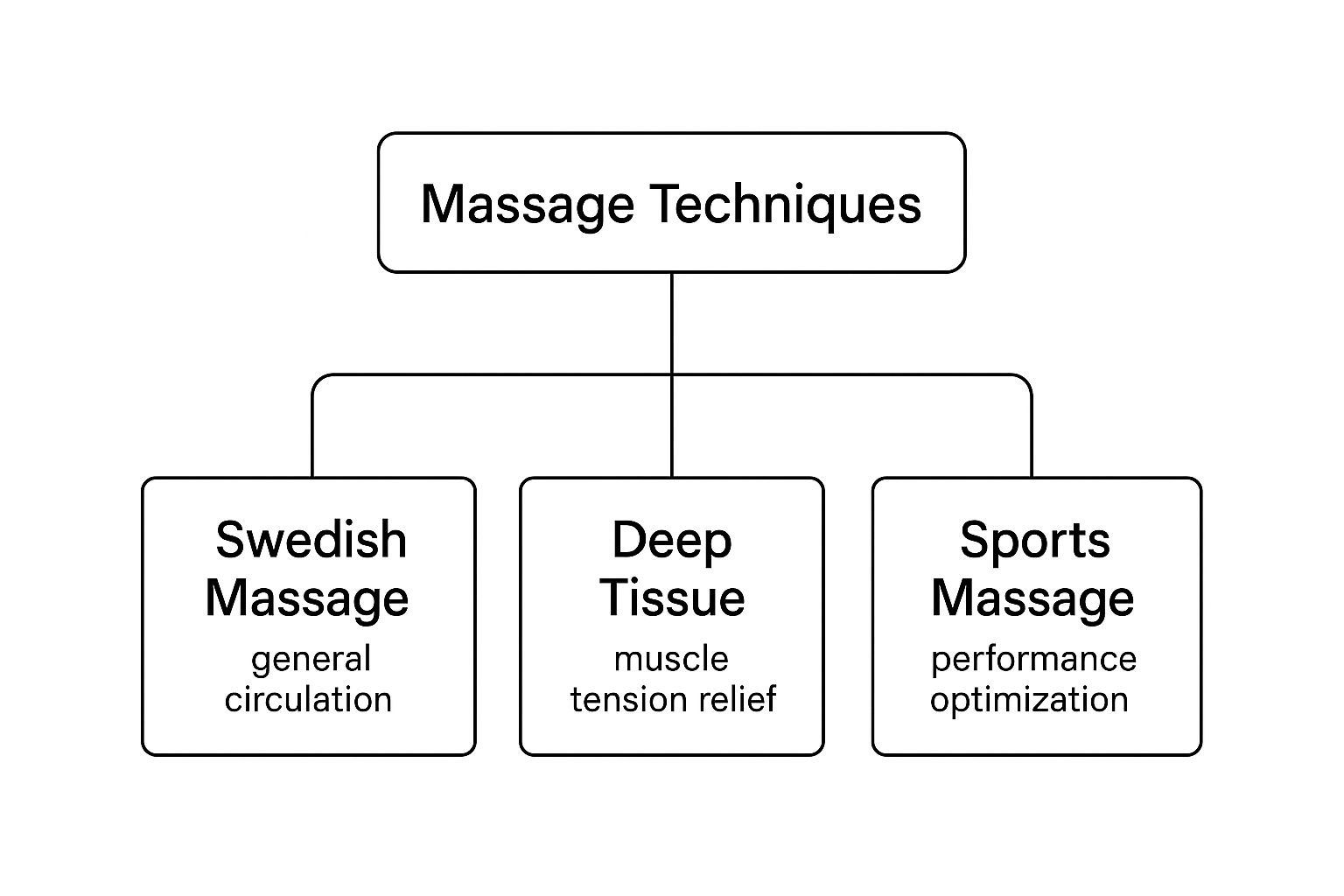
As you can see, each modality really does serve a distinct purpose, ranging from broad relaxation to highly specific performance tuning.
Deep Tissue for Chronic Tension
Think of deep tissue massage as the specialist you bring in for a really tough job. This technique uses slow, firm pressure to work on the deeper layers of your muscle and the connective tissue, or fascia. It’s the perfect choice when you're wrestling with stubborn tightness, old injuries, or dense knots that just won’t respond to lighter work.
This approach is especially helpful for athletes in sports that demand powerful, repetitive movements—think weightlifting or rowing—where muscle adhesions can easily build up over time. By breaking down those adhesions, deep tissue massage helps get your normal movement patterns back on track and can offer relief from persistent pain.
Sports Massage for Peak Performance
While sports massage often uses deep tissue techniques, it's really in a category all its own. What truly sets it apart is how it’s adapted to your athletic calendar. A skilled therapist will adjust the entire session based on whether you're in the middle of a heavy training block, getting ready for a big event, or recovering from a competition.
For any serious athlete, this is the most targeted approach you can get. Research backs this up, with one study showing that 47% of athletes felt significant relief from muscle tension after a sports massage. On top of that, 24% noticed less muscle stiffness and faster recovery times, which directly impacts your ability to train effectively. You can learn more about the differences between Sport Massage Vs Deep Tissue to see which is a better fit for your immediate needs.
Specialized Techniques for Specific Issues
Beyond these more common types, therapists often have other specialized methods in their toolkit to address very precise problems.
- Trigger Point Therapy: This is all about applying direct, isolated pressure to a specific "trigger point"—that's the technical term for a muscle knot—to get it to release. It's like finding the master switch to turn off a whole circuit of pain and tightness.
- Myofascial Release: This technique uses gentle, sustained pressure to stretch and free up the fascia, which is the web of connective tissue that surrounds all your muscles. It's incredibly effective for improving your overall mobility and relieving widespread tightness that feels like it's everywhere at once.
The key takeaway here is simple: The "best" massage is the one that directly addresses what you need right now. Are you sore from a brutal workout? Stiff and anxious before a race? Or dealing with an old, nagging pain point? Your answer points you to the right approach.
For example, a marathon runner might benefit from a lighter Swedish massage a few days before a race to boost circulation without causing any deep muscle soreness. After the race, however, a more focused sports massage would be the better call to kickstart recovery and address any new issues that popped up. To dig deeper into these differences, you can check out our guide on sports massage vs. regular massage.
Ultimately, the most important thing you can do is communicate openly with your therapist. Let them know your training schedule, your goals, and what you're feeling. That conversation is the key to getting the results you’re after.
When to Get a Massage for Optimal Results
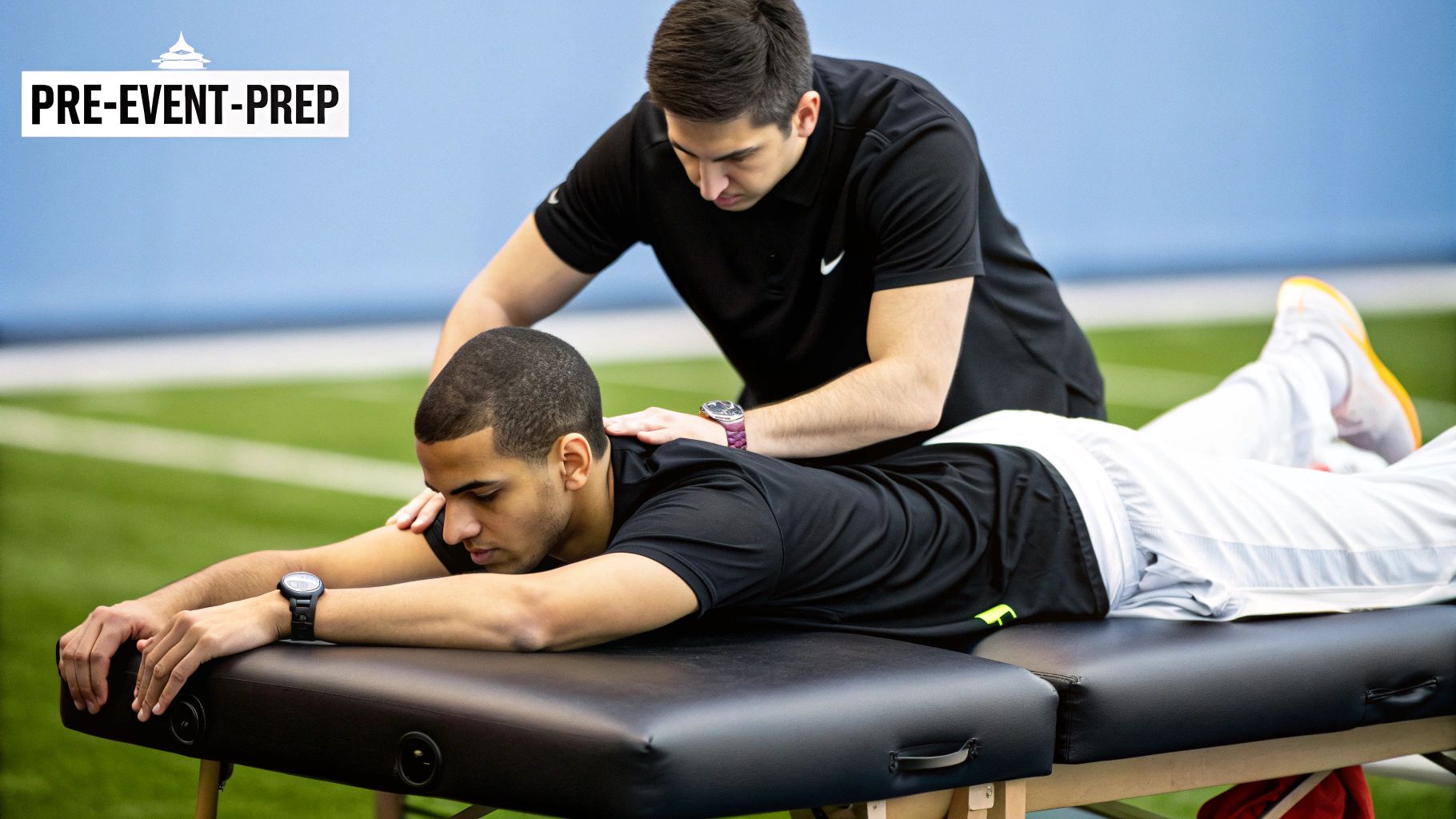
Knowing when to get an athletic massage is every bit as crucial as knowing which type to get. Timing isn’t just a minor detail; it’s a strategy. Schedule a session at the wrong time, and you could feel sore and sluggish on game day. But get it right, and you can boost your performance and dramatically speed up your recovery.
Think of it like fueling your body. You wouldn't down a huge meal right before a sprint, but you also wouldn't run a marathon on an empty stomach. Massage timing works the same way. The goals of a massage before a big competition are completely different from a session afterward, and understanding this difference is the key to unlocking the best results.
By lining up your massages with your training and competition schedule, you can turn this powerful therapy into a genuine competitive edge. This approach helps you sidestep common mistakes and ensures every session is pushing you closer to your goals.
Pre-Event Massage: The Energizer
A pre-event massage is all about preparation, not deep correction. These sessions are quick, light, and invigorating, usually done anywhere from a couple of days to just a few hours before you compete. The focus is on stimulating your muscles, not digging into deep, chronic knots.
The whole point is to increase blood flow, wake up the nervous system, and improve your flexibility without leaving you with any soreness. Your therapist will use techniques like brisk strokes, light stretching, and gentle shaking to prime your body for peak performance.
Think of it as a dynamic warm-up delivered by a professional. It's designed to get your muscles firing and ready for action, giving you a physical and mental boost right from the start.
Getting a deep tissue massage too close to an event is a classic rookie mistake. It can leave your muscles feeling tender and sluggish precisely when you need them to be at their sharpest. Save that deep work for your recovery days.
Post-Event Massage: The Recovery Accelerator
After you’ve pushed your body to its absolute limit, the focus shifts entirely to recovery. A post-event massage, ideally done within 24 to 48 hours after your competition or a brutal workout, is your best first defense against serious soreness and fatigue.
Here, the pace slows way down. The techniques are all geared toward calming your body. The therapist uses flushing strokes to help clear out the metabolic waste that builds up during intense exercise, which is essential for reducing inflammation and kickstarting the healing process.
This session also helps your nervous system switch from its high-alert "fight-or-flight" state back to "rest-and-digest" mode—a non-negotiable step for real healing. Getting this kind of targeted work can seriously shorten your recovery window, something we cover in our guide on sports massage for recovery.
Maintenance Massage: The Foundation of Your Season
While event-specific massages are critical, the true secret to long-term athletic success is the maintenance massage. This is the consistent, regularly scheduled work you do throughout your training season. It’s the foundation that prevents small aches from turning into major, season-ending injuries.
During these sessions, your therapist can finally address the cumulative wear and tear of training. They'll work on chronic knots, help correct muscle imbalances, and improve your overall mobility. This is the time and place for deep tissue and trigger point therapy, since you can safely resolve lingering issues without worrying about being sore for a competition.
How often should you get one? It really depends on the individual, your sport, your training load, and how your body recovers. Some athletes get a massage weekly, while others might go a few times a week during a particularly intense training block. By working with a therapist to align these sessions with your training calendar, you're building a proactive strategy that keeps you healthy, resilient, and performing at your best all season long.
Finding a Therapist Who Understands Athletes
The person applying the pressure matters just as much as the technique itself. While any massage can feel good, a true massage for athletes demands a therapist who genuinely gets the unique strain you put on your body. Finding the right professional is the key to getting the results you’re after.
Think of it this way: you wouldn't hire a general fitness instructor to dial in your competitive swimming stroke. The same logic applies here. You need a massage therapist who speaks the language of athletic recovery and can become a real partner in your training.
A great therapist can spot subtle imbalances, knows where you are in your training cycle, and customizes every single session to what you need that day. This transforms massage from a luxury into a strategic weapon in your performance toolkit.
What to Look For in a Sports Therapist
When you're searching for a therapist, you need to look for solid proof that they're equipped to handle an athlete's body. Don't be shy about asking for their credentials or inquiring about their background—a true professional will be proud to share their qualifications.
Start by looking for these tell-tale signs:
- Specialized Certifications: Look for credentials that go beyond a basic massage license. Certifications in sports massage, clinical massage, or orthopedic massage are a good indicator they’ve invested in advanced, specific training.
- Experience with Athletes: Ask them if they work with athletes often. Even better, do they work with athletes in your specific sport? A therapist who mainly provides relaxation massages for office workers probably isn't the best person to tackle your chronic hamstring issue.
- A Deep Understanding of Anatomy: They need an expert-level command of kinesiology and biomechanics. This is what allows them to connect the dots and trace your nagging shoulder pain back to an underlying imbalance in your hips.
The goal is to find someone who sees you as an athlete, not just a client. Their approach should be analytical, performance-focused, and collaborative, with the clear objective of helping you achieve your physical goals.
Critical Questions to Ask a Potential Therapist
Once you've found a candidate who looks good on paper, a quick conversation can tell you everything else you need to know. Treat it like an interview. After all, you’re hiring them for a vital role on your performance team.
Here are some non-negotiable questions to ask:
- How do you change your approach for an in-season vs. off-season athlete? Their answer will immediately reveal if they understand the critical role of timing and intensity in a training year.
- Can you describe your experience working with [Your Sport] athletes? This is a direct way to find out if they’re familiar with the common strains and injury patterns your body endures.
- What techniques do you use to address issues like muscle adhesions or restricted fascia? This question helps you understand their toolkit and whether they’re skilled in methods like trigger point therapy or myofascial release.
- How do you determine the right amount of pressure for an individual athlete? A great therapist works with you, not on you. They should stress the importance of open communication to make sure the pressure is therapeutic, not just painful.
Finding the right person might take a bit of legwork, but the payoff is huge. A skilled therapist who truly understands your athletic journey is one of the best investments you can make in both your performance and your longevity in the sport.
Effective Self-Massage for Daily Recovery
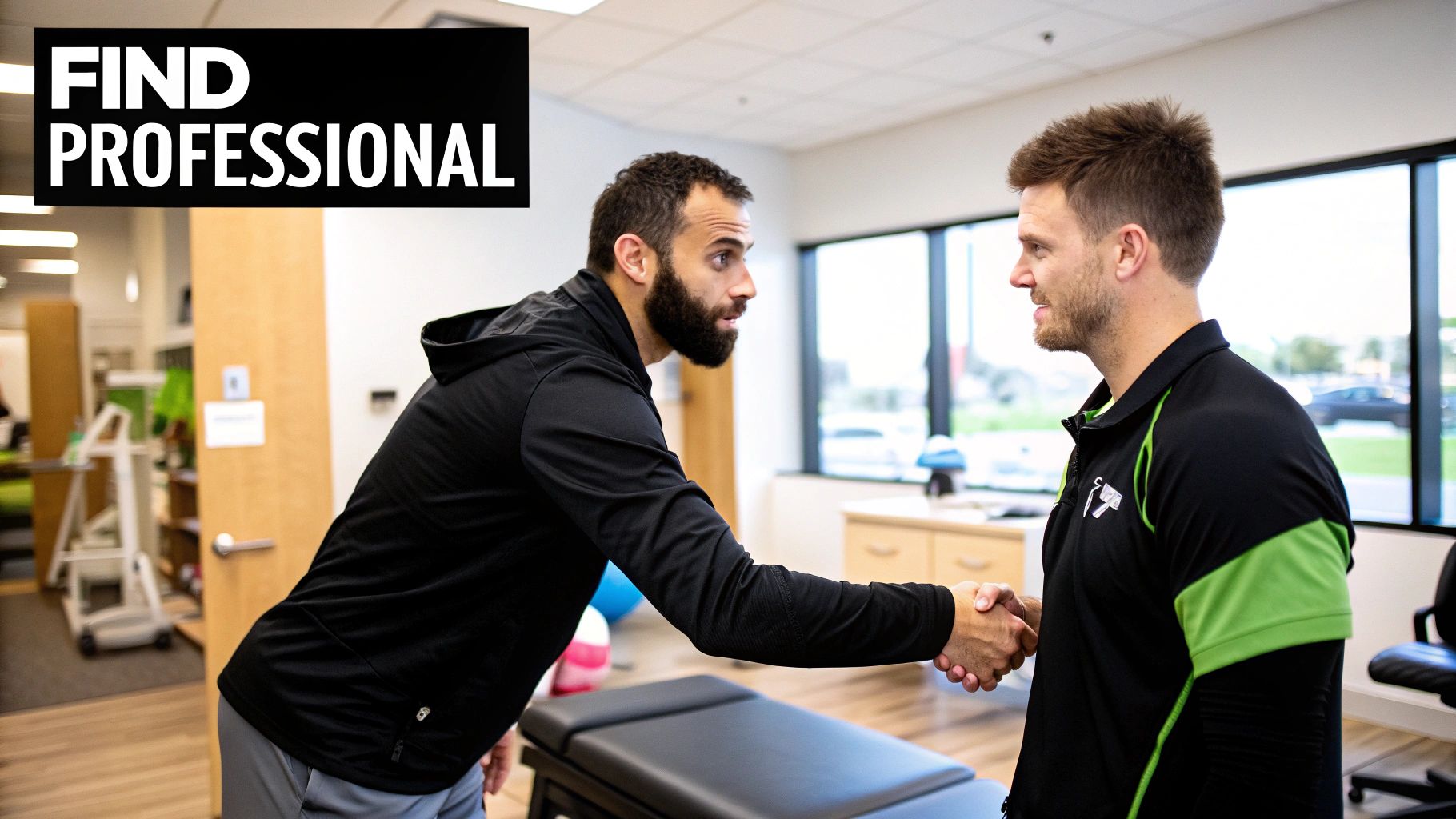
While getting a professional massage is a fantastic way to maintain your body, what you do between those sessions is where the real magic happens. Think of your daily self-care not just as a bonus, but as your secret weapon for managing soreness, staying mobile, and making the benefits of your professional therapy last.
This is about turning recovery from a passive event into an active, daily practice. With tools like foam rollers, massage balls, and percussion massagers, you can take control, addressing tightness as it appears and stopping minor aches from becoming bigger problems.
Using a Foam Roller for Large Muscle Groups
There's a reason the foam roller is a classic. It’s the perfect tool for ironing out the big, workhorse muscles—your quads, hamstrings, back, and calves—that take a beating during training. Imagine you're smoothing out wrinkles in your muscle fibers before they have a chance to set.
To really get the most from your roller, it's all about technique:
- Position the Roller: Get it under the muscle you're working on (like your quads) and use your hands and feet to support your weight.
- Roll Slowly: This is key. Aim for about one inch per second as you move along the muscle. Rushing is a common mistake that just skims the surface instead of getting deep.
- Pause on Tender Spots: When you hit a sore spot, don't just roll over it. Stop and hold that pressure for 20-30 seconds. You can even add small movements, like bending and straightening your knee, to help the muscle fibers release.
Pinpointing Knots with a Massage Ball
Foam rollers are great for covering broad territory, but for the tricky, stubborn knots, you need a precision tool. This is where a massage ball—whether it's a simple lacrosse ball or one made for therapy—really shines. It's fantastic for digging into hard-to-reach spots in the glutes, shoulders, and chest.
A massage ball allows you to apply direct, focused pressure on a specific knot, breaking it up in a way a foam roller just can't. It’s like using a fine-tipped pen to get the details right instead of a big, clumsy marker.
For example, to get into your glutes, you can sit on the floor with the ball placed right under the tight spot and gently roll on it. To release your shoulders, try standing with your back to a wall, pinning the ball between your shoulder blade and the wall to apply that targeted pressure.
Mastering the Massage Gun for Rapid Relief
Percussion massagers, often called massage guns, are all about speed. They deliver quick, powerful pulses deep into your muscle tissue, a technique known as percussive therapy. This can rapidly boost blood flow, help break down adhesions, and soothe soreness almost instantly. But using one correctly is crucial for safety and effectiveness.
Here are a few best practices to keep in mind:
- Start on a Low Setting: Always begin on the lowest speed. See how your muscles respond before you even think about cranking up the intensity.
- Keep it Moving: Don't press down hard or let the gun linger on one spot for more than a few seconds. You want to "float" it over the belly of the muscle.
- Avoid Bones and Joints: This is non-negotiable. Never use a massage gun directly over bony prominences, joints, or your neck. Stick to the fleshy, muscular areas.
By bringing these tools into your daily routine, you take the driver's seat in your own recovery. This consistent self-care works hand-in-hand with your professional massage for athletes, creating a complete system that keeps your body ready for whatever you throw at it.
Common Questions About Massage for Athletes
Once you start thinking about adding massage to your training, the practical questions usually start popping up. It's one thing to understand the theory, but another to know exactly how it fits into your schedule and what to expect. Let's clear up some of the most common questions athletes ask.
First on the list for many is a simple but important one: Is this going to hurt?
Does Sports Massage Hurt?
A proper massage for athletes should feel productive, not painful. Sure, you'll likely feel some discomfort—especially when your therapist is zeroing in on a stubborn knot or a tight spot—but it should never be unbearable. The old "no pain, no gain" philosophy definitely doesn't apply here.
A good sports massage works with your body, not against it. The whole point is to coax the muscle into releasing tension, not to brute-force it into submission.
Think of the pressure as a productive conversation with your muscles. It needs to be firm enough to get a response, but not so intense that your body tenses up to fight it. Open communication with your therapist is key; they can and should adjust the pressure to a level that feels effective for you.
How Soon Can I Train After a Massage?
This really depends on the kind of massage you just had. Timing is everything when it comes to maximizing either your performance or your recovery.
- After a light, pre-event massage: You're good to go. These sessions are designed to warm up the muscles and get you ready for action, so you can train or compete right away without any downtime.
- After a deep tissue or recovery massage: You need to give your body a break. A good rule of thumb is to wait 24 to 48 hours before you tackle another intense workout. This window gives your muscles the time they need to settle down and reap the full benefits of the deep work.
Of course, light activity like a walk or some gentle stretching during this recovery period is perfectly fine and can actually help the process along.
What Should I Do After My Massage?
What you do after your session can make a huge difference in how much you get out of it. A few simple steps will help lock in the benefits and have you feeling your best.
Number one is to hydrate. Your massage helped release metabolic byproducts from your muscle tissue, and drinking plenty of water helps your body flush all of that out.
Also, be sure to avoid any tough workouts for at least 24 hours after a deep massage. Give your muscles a real chance to heal. If you want to take it a step further, an Epsom salt bath later that day is a great idea. The magnesium helps soothe any leftover soreness and amplifies the relaxation, setting you up perfectly for your next performance.
The team at La Moon Massage and Facial is dedicated to helping you reach peak performance and recover effectively. Our experienced therapists truly get the unique demands on an athlete's body and are here to support your goals. Experience premium massage therapy designed to soothe your mind and rejuvenate your body.
